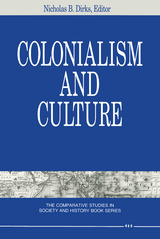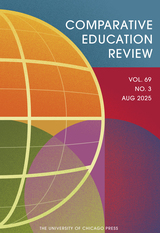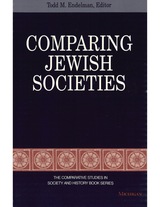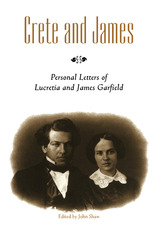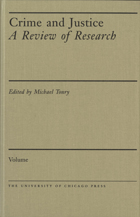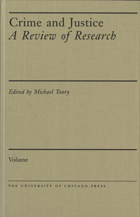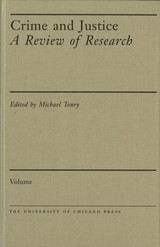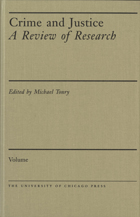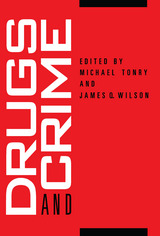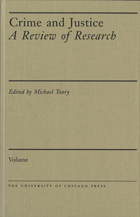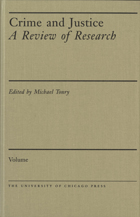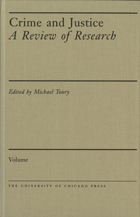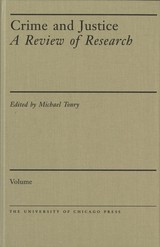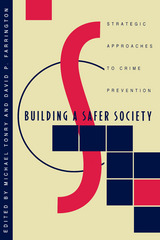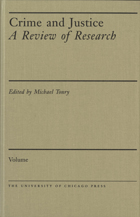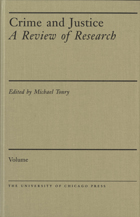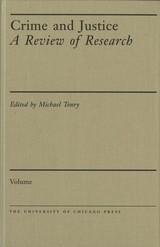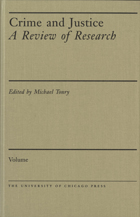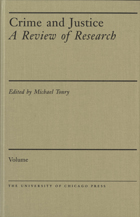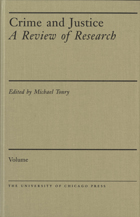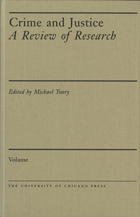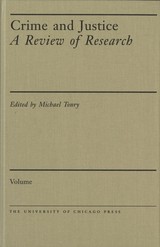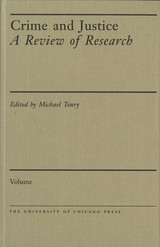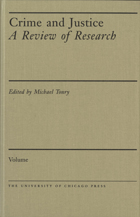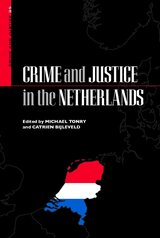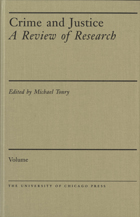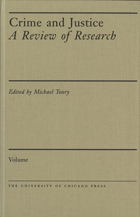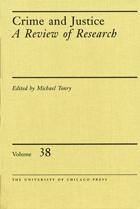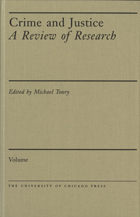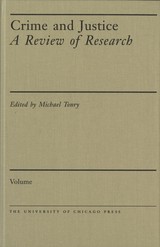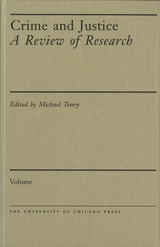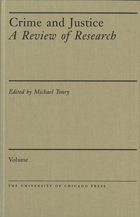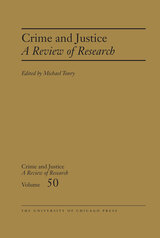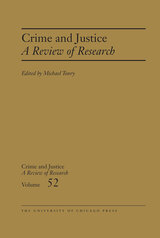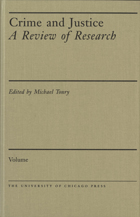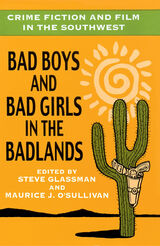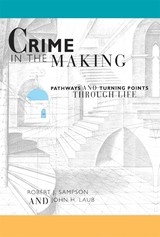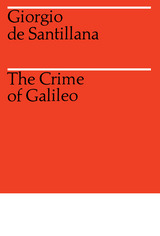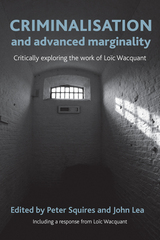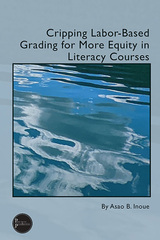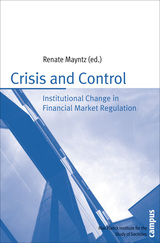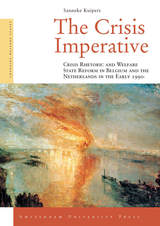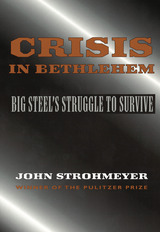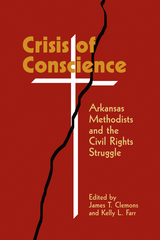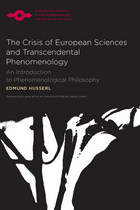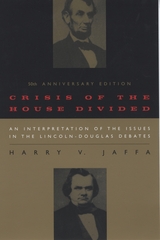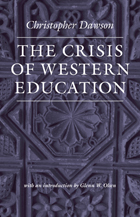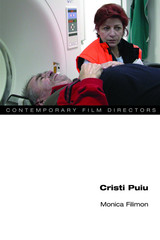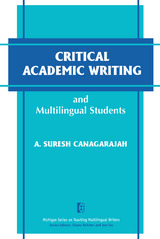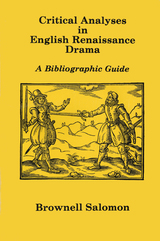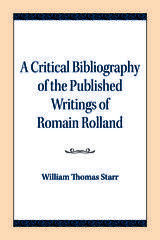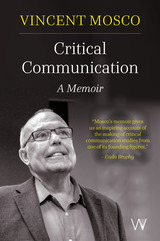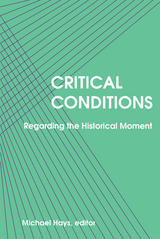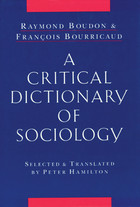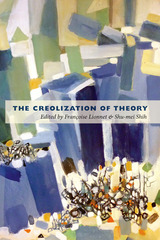 The Creolization of Theory
Françoise Lionnet and Shu-mei Shih, eds.
Duke University Press, 2011 Introducing this collection of essays, Françoise Lionnet and Shu-mei Shih argue that looking back—investigating the historical, intellectual, and political entanglements of contemporary academic disciplines—offers a way for scholars in the humanities to move critical debates forward. They describe how disciplines or methodologies that seem distinct today emerged from overlapping intellectual and political currents in the 1960s and early 1970s, in the era of decolonization, the U.S. civil rights movement, and antiwar activism. While both American ethnic studies programs and “French theory” originated in decolonial impulses, over time, French theory became depoliticized in the American academy. Meanwhile, ethnic studies, and later also postcolonial studies, developed politically and historically grounded critiques of inequality. Suggesting that the abstract universalisms of Euro-American theory may ultimately be the source of its demise, Lionnet and Shih advocate the creolization of theory: the development of a reciprocal, relational, and intersectional critical approach attentive to the legacies of colonialism. This use of creolization as a theoretical and analytical rubric is placed in critical context by Dominique Chancé, who provides a genealogy of the concept of creolization. In their essays, leading figures in their fields explore the intellectual, disciplinary, and ethical implications of the creolized theory elaborated by Lionnet and Shih. Édouard Glisssant links the extremes of globalization to those of colonialism and imperialism in an interview appearing for the first time in English in this volume. The Creolization of Theory is a bold intervention in debates about the role of theory in the humanities. Contributors. Étienne Balibar, Dominique Chancé, Pheng Cheah, Leo Ching, Liz Constable, Anne Donadey, Fatima El-Tayeb, Julin Everett, Édouard Glissant, Barnor Hesse, Ping-hui Liao, Françoise Lionnet, Walter Mignolo, Andrea Schwieger Hiepko, Shu-mei Shih
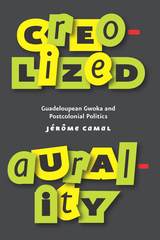 Creolized Aurality: Guadeloupean Gwoka and Postcolonial Politics
Jérôme Camal
University of Chicago Press, 2019 In the Caribbean island of Guadeloupe, the complex interplay between anticolonial resistance and accommodation resounds in its music. Guadeloupean gwoka music—a secular, drum-based tradition—captures the entangled histories of French colonization, movements against it, and the uneasy process of the island’s decolonization as an overseas territory of France. In Creolized Aurality, Jérôme Camal demonstrates that musical sounds and practices express the multiple—and often seemingly contradictory—cultural belongings and political longings that characterize postcoloniality. While gwoka has been associated with anti-colonial activism since the 1960s, in more recent years it has provided a platform for a cohort of younger musicians to express pan-Caribbean and diasporic solidarities. This generation of musicians even worked through the French state to gain UNESCO heritage status for their art. These gwoka practices, Camal argues, are “creolized auralities”—expressions of a culture both of and against French coloniality and postcoloniality.
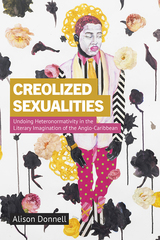 Creolized Sexualities: Undoing Heteronormativity in the Literary Imagination of the Anglo-Caribbean
Alison Donnell
Rutgers University Press, 2022 Creolized Sexualities: Undoing Heteronormativity in the Literary Imagination of the Anglo-Caribbean draws attention to a wide, and surprising, range of writings that craft inclusive and pluralizing representations of sexual possibilities within the Caribbean imagination. Reading across an eclectic range of writings from V.S. Naipaul to Marlon James, Shani Mootoo to Junot Diaz, Andrew Salkey to Thomas Glave, Curdella Forbes to Colin Robinson, this bold work of literary criticism brings into view fictional worlds where Caribbeanness and queerness correspond and reconcile. Through inspired close readings Donnell gathers evidence and argument for the Caribbean as an exemplary creolized ecology of fluid possibilities that can illuminate the prospect of a non-heteronormalizing future. Indeed, Creolized Sexualities hows how writers have long rendered sexual plasticity, indeterminacy, and pluralism as an integral part of Caribbeanness and as one of the most compelling if unacknowledged ways of resisting the disciplining regimes of colonial and neocolonial power.
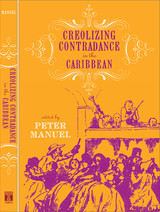 Creolizing Contradance in the Caribbean
Peter Manuel
Temple University Press, 2011 The contradance and quadrille, in their diverse forms, were the most popular, widespread, and important genres of creole caribbean music and dance in the nineteenth century. Throughout the region they constituted sites for interaction of musicians and musical elements of different racial, social, and ethnic origins, and they became crucibles for the evolution of genres like the Cuban danzón and son, the Dominican merengue, and the Haitian mereng. Creolizing Contradance in the Caribbean is the first book to explore this phenomenon in detail and with a pan-regional perspective. Individual chapters by respected area experts discuss the Spanish, French, and English-speaking Caribbean. For each area they cover the musical and choreographic features, social dynamics, historical development and significance, and discuss them in relation to the broader Caribbean historical context. This groundbreaking text fills a significant gap in studies of Caribbean cultural history and of social dance.
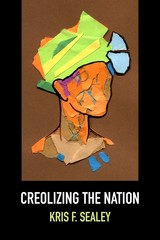 Creolizing the Nation
Kris F. Sealey
Northwestern University Press, 2020 Winner, 2022 Nicolás Cristóbal Guillén Batista Outstanding Book Award
Creolizing the Nation identifies the nation-form as a powerful resource for political struggles against colonialism, racism, and other manifestations of Western hegemony in the Global South even as it acknowledges the homogenizing effects of the politics of nationalism. Drawing on Caribbean, decolonial, and Latina feminist resources, Kris F. Sealey argues that creolization provides a rich theoretical ground for rethinking the nation and deploying its political and cultural apparatus to imagine more just, humane communities. Analyzing the work of thinkers such as Édouard Glissant, Frantz Fanon, Gloria Anzaldúa, María Lugones, and Mariana Ortega, Sealey shows that a properly creolizing account of the nation provides an alternative imaginary out of which collective political life might be understood. Creolizing practices are always constitutive of anticolonial resistance, and their ongoing negotiations with power should be understood as everyday acts of sabotage. Sealey demonstrates that the conceptual frame of the nation is not fated to re-create colonial instantiations of nationalism but rather can support new possibilities for liberation and justice.
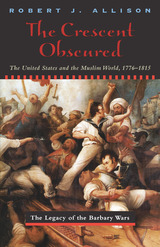 The Crescent Obscured: The United States and the Muslim World, 1776-1815
Robert Allison
University of Chicago Press, 2000 From the beginning of the colonial period to the recent conflicts in the Middle East, encounters with the Muslim world have helped Americans define national identity and purpose. Focusing on America's encounter with the Barbary states of North Africa from 1776 to 1815, Robert Allison traces the perceptions and mis-perceptions of Islam in the American mind as the new nation constructed its ideology and system of government.
"A powerful ending that explains how the experience with the Barbary states compelled many Americans to look inward . . . with increasing doubts about the institution of slavery." —David W. Lesch, Middle East Journal
"Allison's incisive and informative account of the fledgling republic's encounter with the Muslim world is a revelation with a special pertinence to today's international scene." —Richard W. Bulliet, Journal of Interdisciplinary History
"This book should be widely read. . . . Allison's study provides a context for understanding more recent developments, such as America's tendency to demonize figures like Iran's Khumaini, Libya's Qaddafi, and Iraq's Saddam." —Richard M. Eaton, Eighteenth Century Studies
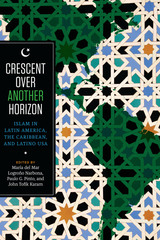 Crescent over Another Horizon: Islam in Latin America, the Caribbean, and Latino USA
Edited by Maria del Mar Logroño Narbona, Paulo G. Pinto, and John Tofik Karam
University of Texas Press, 2015 Muslims have been shaping the Americas and the Caribbean for more than five hundred years, yet this interplay is frequently overlooked or misconstrued. Brimming with revelations that synthesize area and ethnic studies, Crescent over Another Horizon presents a portrait of Islam’s unity as it evolved through plural formulations of identity, power, and belonging. Offering a Latino American perspective on a wider Islamic world, the editors overturn the conventional perception of Muslim communities in the New World, arguing that their characterization as “minorities” obscures the interplay of ethnicity and religion that continues to foster transnational ties. Bringing together studies of Iberian colonists, enslaved Africans, indentured South Asians, migrant Arabs, and Latino and Latin American converts, the volume captures the power-laden processes at work in religious conversion or resistance. Throughout each analysis—spanning times of inquisition, conquest, repressive nationalism, and anti-terror security protocols—the authors offer innovative frameworks to probe the ways in which racialized Islam has facilitated the building of new national identities while fostering a double-edged marginalization. The subjects of the essays transition from imperialism (with studies of morisco converts to Christianity, West African slave uprisings, and Muslim and Hindu South Asian indentured laborers in Dutch Suriname) to the contemporary Muslim presence in Argentina, Brazil, Mexico, and Trinidad, completed by a timely examination of the United States, including Muslim communities in “Hispanicized” South Florida and the agency of Latina conversion. The result is a fresh perspective that opens new horizons for a vibrant range of fields.
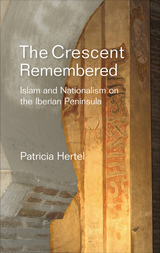 The Crescent Remembered: Islam and Nationalism on the Iberian Peninsula
Patricia Hertel
Sussex Academic Press, 2022 Contemporary Spain and Portugal share a historical experience as Iberian states which emerged within the context of al-Andalus. These centuries of Muslim presence in the Middle Ages became a contested heritage during the process of modern nation-building with its varied concepts and constructs of national identities. Politicians, historians and intellectuals debated vigorously the question how the Muslim past could be reconciled with the idea of the Catholic nation. The Crescent Remembered investigates the processes of exclusion and integration of the Islamic past within the national narratives. It analyzes discourses of historiography, Arabic studies, mythology, popular culture and colonial policies towards Muslim populations from the 19th century to the dictatorships of Franco and Salazar in the 20th century. In particular, it explores why, despite apparent historical similarities, in Spain and Portugal entirely different strategies and discourses concerning the Islamic past emerged. In the process, it seeks to shed light on the role of the Iberian Peninsula as a crucial European historical "contact zone" with Islam.
Crete and James: Personal Letters of Lucretia and James Garfield
John Shaw
Michigan State University Press, 1994 Crete and James is a collection of letters exchanged by James A. Garfield and Lucretia Randolph Garfield during the mid-nineteenth century. Of the 1,200 or so letters written, the 300 included this work chronicle their courtship and marriage, and also discuss the Civil War, political affairs, and the details of daily life during the years 1853-1881. In them, we watch Crete grow from a shy girl into a self-confident woman who guides her husband in social and political matters. Through James’s flamboyant yet scholarly style, and Lucretia’s detailed, perceptive insights, we come to know them as though they were our close friends. Through their correspondence, the reader also meets the many people involved in their lives. Crete and James will be of great interest to those studying women’s history.
 Cricket Radio: Tuning In the Night-Singing Insects
John Himmelman
Harvard University Press, 2011 At a time when night-singing insects have slipped beyond our notice—indeed, are more likely to be heard as NatureSounds than in a backyard—John Himmelman seeks to reconnect us to creatures whose songs form a part of our own natural history.
On warm summer evenings, night-singing insects produce a whirring, chirping soundscape—a calming aural tapestry celebrated by poets and naturalists for millennia. But “cricket radio” is not broadcast for the easy-listening pleasure of humans. The nocturnal songs of insects are lures and warnings, full of risks and rewards for these tiny competitive performers. What moves crickets and katydids to sing, how they produce their distinctive sounds, how they hear the songs of others, and how they vary cadence, volume, and pitch to attract potential mates, warn off competitors, and evade predators is part of the engaging story Cricket Radio tells.
Himmelman’s narrative weaves together his personal experiences as an amateur naturalist in search of crickets and katydids with the stories of scientists who study these insects professionally. He also offers instructions for bringing a few of the little singers into our homes and gardens. We can, Himmelman suggests, be reawakened to these night songs that have meant so much to the human psyche. The online insect calls that accompany this colorfully illustrated narrative provide a bridge of sound to our past and to our vital connection with other species.
Crickets and Katydids, Concerts and Solos
Vincent G. Dethier
Harvard University Press, 1992 Adorned with fine drawings, this book introduces amateur naturalists and lovers of nature to some of the more common singing crickets, locusts, and grasshoppers of the northeastern U.S. Dethier presents us with a captivating glimpse of the ecology of singing Orthoptera, conditions under which they are studied, and people who have studied them.
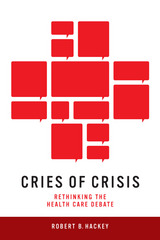 Cries of Crisis: Rethinking the Health Care Debate
Robert B. Hackey
University of Nevada Press, 2015 Since the late 1960s, health care in the United States has been described as a system in crisis. No matter their position, those seeking to improve the system have relied on the rhetoric of crisis to build support for their preferred remedies, to the point where the language and imagery of a health care crisis are now deeply embedded in contemporary politics and popular culture.
In Cries of Crisis, Robert B. Hackey analyzes media coverage, political speeches, films, and television shows to demonstrate the role that language and symbolism have played in framing the health care debate, shaping policy making, and influencing public perceptions of problems in the health care system. He demonstrates that the idea of crisis now means so many different things to so many different groups that it has ceased to have any shared meaning at all. He argues that the ceaseless talk of “crisis,” without a commonly accepted definition of that term, has actually impeded efforts to diagnose and treat the chronic problems plaguing the American health care system. Instead, he contends, reformers must embrace a new rhetorical strategy that links proposals to improve the system with deeply held American values like equality and fairness.
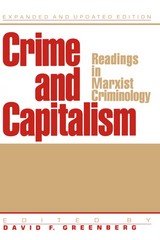 Crime And Capitalism: Readings in Marxist Crimonology
edited by David F. Greenberg
Temple University Press, 1993 "This book is superb in every way.... [It] is the only book that attempts to put into perspective just what the possible relationship between praxis and Marxist criminology might (should) be."
--Eleanor Miller, University of Wisconsin, Milwaukee
In this expanded and updated second edition of a revered reader in Marxist criminology, editor David F. Greenberg brings together writings about crime that range from classic articles by Karl Marx and Friedrich Engels to a variety of contemporary essays. Taking an explicitly Marxist point of view, the articles deal with various aspects of criminology, including organized crime, delinquency, urban crime, criminal law, and criminal justice. To the original text, Greenberg has added pieces on race and crime, gender and crime, rape, arson for profit, and auto theft.
With extensive prefatory material prepared by Greenberg, as well as editorial notes, and a glossary of Marxist terminology, Crime and Capitalism is an indispensable text for students and professionals in the fields of criminology, criminal justice, social history, and sociology.
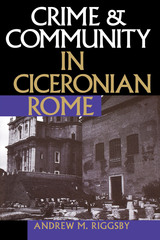 Crime and Community in Ciceronian Rome
By Andrew M. Riggsby
University of Texas Press, 1999 In the late Roman Republic, acts of wrongdoing against individuals were prosecuted in private courts, while the iudicia publica (literally "public courts") tried cases that involved harm to the community as a whole. In this book, Andrew M. Riggsby thoroughly investigates the types of cases heard by the public courts to offer a provocative new understanding of what has been described as "crime" in the Roman Republic and to illuminate the inherently political nature of the Roman public courts. Through the lens of Cicero's forensic oratory, Riggsby examines the four major public offenses: ambitus (bribery of the electorate), de sicariis et veneficiis (murder), vis (riot), and repetundae (extortion by provincial administrators). He persuasively argues that each of these offenses involves a violation of the proper relations between the state and the people, as interpreted by orators and juries. He concludes that in the late Roman Republic the only crimes were political crimes.
 Crime and Conflict in English Communities, 1300–1348
Barbara A. Hanawalt
Harvard University Press, 1979 As this account of crime patterns in medieval England shows, crime can perhaps tell us more about a society's dynamics, tensions, and values than any other single social phenomenon. And Barbara Hanawalt's approach is particularly enlightening because it looks at the subject not from the heights of the era's learned opinion, but from the viewpoint of the people participating in the criminal dramas and manipulating the law for their own benefit.
Hanawalt's sources are those of the new social historian—village and judicial records supplemented by the literature of the time. She examined approximately 20,000 criminal court cases as well as coroners' and manorial court rolls. Her analysis of these data produces striking results. Medieval England, the author reveals, was a society in which all classes readily sought violent solutions to conflicts. The tensions of village life were severe. The struggle for food and for profits caused numerous homicides and property crimes. These felonies were committed in seasonal patterns, with homicides occurring most frequently during the difficult times of planting and harvesting, and burglaries reaching a peak in winter when goods were stored in houses and barns.
Moreover, organized crime was widespread and varied. It ranged from simple associations of local people to professional bands led by members of the nobility. One of Hanawalt's most interesting findings explodes the Robin Hood myth of robbers who stole from the rich and gave to the poor. Almost always, she shows, the robbers stole from the poor and kept for themselves. Throughout, Hanawalt carefully places the crimes and their participants within the context of village life in the later middle ages. Along with a description of the social and legal setting of criminal acts, she includes a discussion of the influence of war, politics, and economic, social, and demographic changes on the patterns of crime.
Crime and Criminal Statistics in Boston
Sam Bass Warner
Harvard University Press This second volume of the Harvard Survey of Crime discusses the data on criminal administration available now and the data which should be made available in the future. Sam Bass Warner concludes that hitherto most statistical information in regard to the administration of criminal justice has been unsatisfactory; and he then demonstrates what such statistics might achieve and how they could be made to serve useful ends if collected and compiled with due care and forethought. His system of criminal court statistics as embodied in the last chapters will interest many readers for just this reason and also because in advancing some of the features of his scheme he had first to criticize and discard many current practices and ideas. His plan, it is interesting to note, has already been adopted by two states.
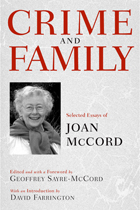 Crime and Family: Selected Essays of Joan McCord
Joan McCord, introduction by David Farrington, foreword by Geoffrey Sayre-McCord
Temple University Press, 2007 Joan McCord (1930-2004) was one of the most famous, most-respected, and best-loved criminologists of her generation. A brilliant pioneer, Dr. McCord was best known for her work on the Cambridge-Somerville Youth Study, the first large-scale, longitudinal experimental study in the field of criminology. The study was among the first to demonstrate unintended harmful effects of a well-meaning prevention program. Dr. McCord's most important essays from this groundbreaking research project are among those included in this volume.McCord also co-wrote, edited, or co-edited twelve volumes and authored or co-authored 127 journal articles and book chapters. She wrote across a broad array of subjects, including delinquency, alcoholism, violence, crime prevention, and criminal theory. This book brings her most important and lasting work together in one place for the first time.
 Crime and Forgiveness: Christianizing Execution in Medieval Europe
Adriano Prosperi
Harvard University Press, 2020 A provocative analysis of how Christianity helped legitimize the death penalty in early modern Europe, then throughout the Christian world, by turning execution into a great cathartic public ritual and the condemned into a Christ-like figure who accepts death to save humanity.
The public execution of criminals has been a common practice ever since ancient times. In this wide-ranging investigation of the death penalty in Europe from the fourteenth to the eighteenth century, noted Italian historian Adriano Prosperi identifies a crucial period when legal concepts of vengeance and justice merged with Christian beliefs in repentance and forgiveness.
Crime and Forgiveness begins with late antiquity but comes into sharp focus in fourteenth-century Italy, with the work of the Confraternities of Mercy, which offered Christian comfort to the condemned and were for centuries responsible for burying the dead. Under the brotherhoods’ influence, the ritual of public execution became Christianized, and the doomed person became a symbol of the fallen human condition. Because the time of death was known, this “ideal” sinner could be comforted and prepared for the next life through confession and repentance. In return, the community bearing witness to the execution offered forgiveness and a Christian burial. No longer facing eternal condemnation, the criminal in turn publicly forgave the executioner, and the death provided a moral lesson to the community.
Over time, as the practice of Christian comfort spread across Europe, it offered political authorities an opportunity to legitimize the death penalty and encode into law the right to kill and exact vengeance. But the contradictions created by Christianity’s central role in executions did not dissipate, and squaring the emotions and values surrounding state-sanctioned executions was not simple, then or now.
Crime and Justice, Volume 15: Modern Policing
Edited by Michael Tonry and Norval Morris
University of Chicago Press Journals, 1993 Modern Policing, a critical assessment of contemporary police agencies, is the fifteenth volume in the Crime and Justice series. Modern Policing is a comprehensive review for students and scholars of criminal justice and public policy, as well as specialists in sociology and history.
Crime and Justice, Volume 18: Beyond the Law: Crime in Complex Organizations
Edited by Michael Tonry and Albert J. Reiss Jr.
University of Chicago Press Journals, 1993 This collection explores structural incentives and disincentives to anti-social and unlawful behaviors and the roles of self- regulation, administrative agencies, and civil and criminal sanctions in shaping organizational behavior. Included are articles on organizational crime, the savings and loan industry, insider trading, industrial water pollution, garbage collection, and the nursing home industry.
Crime and Justice, Volume 19: Strategic Approaches to Crime Prevention
Edited by Michael Tonry and David Farrington
University of Chicago Press Journals, 1995 We elect officials in hopes that they will make our communities safer, yet their widely-endorsed law enforcement strategies have little effect on crime rates. Active crime prevention must take into account the diversity of crimes and criminals. High-quality evaluation research designs are needed to convince scholars, policy makers, and practitioners about the effectiveness of crime prevention techniques. Building a Safer Society, the most comprehensive exposition of research and experience concerning crime prevention ever published, offers a new conceptualization of the subject incorporating developmental, community, situational and law enforcement approaches. This timely collection will especially interest scholars in law, criminal justice, public policy and public administration.
Crime and Justice, Volume 20: An Annual Review of Research
Edited by Michael Tonry
University of Chicago Press Journals, 1996 Founded in 1979, Crime and Justice addresses important developments in the criminal justice system. This distinguished series of commissioned essays encompasses topics both within and outside of the accepted core of research on crime and justice, including legal, psychological, biological, sociological, historical, and ethical considerations. Individual essays in Volume 20 include articles by Michael Tonry and Mary Lynch on intermediate sanctions; Thomas J. Bernard and Jeffrey B. Snipes on theoretical integration in criminology; Antony Duff on recent work in the philosophy of punishment; Eugene Maguin and Rolf Loeber on academic performance and delinquency; Thomas M. Mieczkowski on the measurement of drug prevalence in the United States; and Ellen G. Cohn and David P. Farrington on Crime and Justice in the criminal justice and criminology literature.
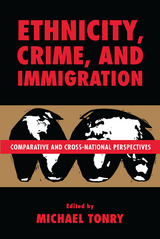 Crime and Justice, Volume 21: Comparative and Cross-National Perspectives on Ethnicity, Crime, and Immigration
Edited by Michael Tonry
University of Chicago Press Journals, 1997 This volume is the first major cross-national examination of racial and
ethnic differences in criminal offending, victimization by crime, and
disparities and discrimination in justice systems. These nine essays
provide comrehensive up-to-date summaries of research and experience
concerning those subjects in Australia, Canada, England and Wales,
France, Germany, the Netherlands, Sweden, Switzerland, and the United
States. Population migration has reached an all time high in Europe and
with it, "immigration and crime" has become the single most volatile and
topical crime control issue in most of these countries.
The nine essays in this book are written by the leading specialists in
each country. Contributors include Roderic Broadhurst, Julian V. Roberts
and Anthony N. Doob, David J. Smith, Pierre Tournier, Hans-Jörg
Albrecht, Josine Junger-Tas, Peter L. Martens, Martin Killias, Robert J.
Sampson and Janet L. Lauritsen.
Michael Tonry is Sonosky Professor of Law and Public Policy at the
University of Minnesota.
Crime and Justice, Volume 23: An Annual Review of Research
Edited by Michael Tonry
University of Chicago Press Journals, 1998 Volume 23 includes articles by Daniel Nagin on deterrence; James Alan Fox and Jack Levin on serial and mass murder; Stephen J. Morse on "New Excuse" defenses; Christian Pfeiffer on youth violence in Western Europe; Roxanne Lieb, Vernon Quinsey, and Lucy Berliner on sexual psychopath laws; Rolf Loeber and Marc Le Blanc on the development of juvenile offending; and Michael Tonry on intermediate sanctions in sentencing guidelines.
Crime and Justice, Volume 24: Youth Violence
Edited by Michael Tonry and Mark H. Moore
University of Chicago Press Journals, 1998 Youth violence has become one of the most contentious and perplexing issues in current debates on crime policy, not the least because of the sharp increase in violence among young minority males since the mid-1980s.
Featuring articles by leading American and European scholars from many fields, Youth Violence provides a reliable, up-to-date, authoritative and comprehensive overview of policy issues and research developments concerning crime and violence among the young.
Crime and Justice, Volume 25: An Annual Review of Research
Edited by Michael Tonry
University of Chicago Press Journals, 1999 For years this distinguished series has provided scholars and practitioners with timely, cross-disciplinary reviews of research on some of today's most pressing policy issues. Volume 25 includes articles by Jeffery A. Fagan and Richard B. Freeman on crime and work; John Braithwaite on restorative justice; Josine Junger-Tas and Ineke Haen Marshall on self-report methodology in crime research; Roger Lane on the history of murder in America; and James B. Jacobs and Lauryn P. Gouldin on Cosa Nostra.
 Crime and Justice, Volume 26: Prisons
Edited by Michael Tonry and Joan Petersilia
University of Chicago Press Journals, 1999 America's prison population has quadrupled in the past two decades, with an enormous impact on families, communities, correctional officers, policy makers, and prisoners themselves. The use of imprisonment as a means of social control has come to the fore in many public debates—whether the issues be deterrence, incapacitation, public spending, overcrowding, or the effects of imprisonment on the offenders' later lives. Prisons addresses these and related topics, offering thought-provoking analyses of particular issues that deserve greater consideration, such as the effects of imprisonment on the children of inmates, the relationship between prisons and the surrounding communities, medical care in prisons, prisoner suicide and coping, adult correctional treatment, and prison management trends, and related topics.
Featuring articles by Alfred Blumstein and Allen Beck, Joan Petersilia, Anthony Bottoms, Douglas McDonald and others, Prisons provides reliable, up-to-date, and comprehensive overviews of policy issues and research developments concerning prisons and imprisonment. This timely collection of essays will benefit scholars, administrators, and policy makers alike.
Crime and Justice, Volume 27: A Review of Research
Edited by Michael Tonry
University of Chicago Press Journals, 2000 For twenty years, this distinguished series has provided both scholars and practitioners with timely, cross-disciplinary reviews of the best research on today's most contentious and pressing policy issues. Volume 27 includes articles by William Spelman on recent studies of prisons and crime; Brandon C. Welsh and David P. Farrington on monetary costs and benefits of crime prevention programs; Donna Bishop on juvenile offenders in the criminal justice system; Leena Kurki on restorative and community justice in the United States; Martha J. Smith and Ronald V. Clarke on crime and public transport; and Francis T. Cullen/Bonnie S. Fisher/Brandon K. Applegate on public opinion about punishment and corrections.
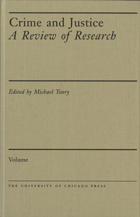 Crime and Justice, Volume 28: A Review of Research
Edited by Michael Tonry
University of Chicago Press Journals, 2001 The most relevant topics for today=s policy makers and academicians are presented in a manner both comprehensive and accessible. As editor, Tonry has created a careful blend of the key philosophical, theoretical, and policy-relevant issues of the day. This volume is a must for any bookshelf. —Criminal Justice Review
Volume 28 is a review of recent research on criminal justice issues, with a careful balance of research, theory, and practice.
Contributors:
John Laub and Robert J. Sampson on Desistance From Crime
Norval Morris and Leena Kurki on Supermax Prisons
Richard Harding on Private Prisons
David Boerner and Roxanne Lieb on Sentencing Reform In The Other Washington, 1975-2000
Michael A. Bellesiles on the History Of Firearms Regulation
Grant T. Harris, Tracey A. Skilling, and Marnie E. Rice on Psychopathy And Crime
Daniel Nagin on Costs And Benefits Of Crime Prevention.
Crime and Justice, Volume 29: A Review of Research
Edited by Michael Tonry
University of Chicago Press Journals, 2002 "The most relevant topics for today’s policy makers and academicians are presented in a manner both comprehensive and accessible. As editor, Tonry has created a careful blend of the key philosophical, theoretical, and policy-relevant issues of the day . . . . A must for any bookshelf."—Criminal Justice Review
Volume 29 is a review of recent research on criminal justice issues, with a careful balance of research, theory, and practice.
Crime and Justice, Volume 30: A Review of Research
Edited by Michael Tonry
University of Chicago Press Journals, 2003 "The most relevant topics for today's policy makers and academicians are presented in a manner both comprehensive and accessible. As editor, Tonry has created a careful blend of the key philosophical, theoretical, and policy-relevant issues of the day. . . . A must for any bookshelf."—Crime and Justice Review
Volume 30 is a survey volume of recent research on criminal justice issues, with a careful balance of research, theory, and practice.
Contributors:
Alfred Blumstein
Rick Brown
Ronald V. Clarke
Anthony N. Doob
Manuel Eisner
David P. Farrington
Rosemary Gartner
James Jacobs
Candace Kruttschnitt
Ellen Peters
Alex R. Piquero
Tom R. Tyler
Cheryl Marie Webster
Crime and Justice, Volume 31: Youth Crime and Youth Justice: Comparative and Cross-national Perspectives
Edited by Michael Tonry and Anthony N. Doob
University of Chicago Press Journals, 2004 Volume 31 of Crime and Justice presents a global view on youth justice systems, examining Canada, Denmark, Germany, Great Britain, the Netherlands, New Zealand, Sweden, and an aggregation of Western countries. The systems are addressed in five sections, which discuss the relevance of a separate youth justice system, age limitations, historical stability and changes, welfare concerns, and a comparative look at current laws as written and administered.
Contributors:
Hans-Jörg Albrecht
Anthony Bottoms
James Dignan
Anthony N. Doob
Carl-Gunnar Janson
Josine Junger-Tas
Britta Kyvsgaard
Allison Morris
Julian V. Roberts
Jane B. Sprott
Lode Walgrave
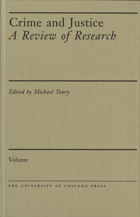 Crime and Justice, Volume 32: A Review of Research
Edited by Michael Tonry
University of Chicago Press Journals, 2004 Since 1979 the Crime and Justice series has presented important developments in the criminal justice system that enhance the work of sociologists, psychologists, criminal lawyers, justice scholars, and political scientists. Crime and Justice offers an interdisciplinary approach to core issues in criminology, with perspectives from biology, law, psychology, ethics, history, and sociology.
Volume 32 covers criminal justice issues, with a careful balance of research, theory, and practice. Topics in this volume include: environmental crime, the effects of wrongful imprisonment, the assessment of macro-level predictors and theories of crime, ethnic differences in intergenerational crime patterns, sentencing guidelines in Minnesota from 1978 to 2003, and the results of five decades of neutralization research.
Contributors:
Heith Copes
Francis T. Cullen
Richard S. Frase
Adrian Grounds
Shadd Maruna
Travis C. Pratt
Aaron S. Routhe
Neal Shover
David J. Smith
Crime and Justice, Volume 33: Crime and Punishment in Western Countries, 1980-1999
Edited by Michael Tonry and David P. Farrington
University of Chicago Press Journals, 2006 The eight essays in this volume provide comprehensive, up-to-date summaries of crossnational crime trends in Australia, Canada, England, Wales, the Netherlands, Scotland, Sweden, Switzerland, and the United States. This book is an essential resource for sociologists, psychologists, criminal lawyers, justice scholars, and political scientists who seek an interdisciplinary approach to crime, its causes, and its repercussions. The contributors to this volume are Marcelo F. Aebi, Catrien C. J. H. Bijleveld, Alfred Blumstein, Carlos Carcach, Philip J. Cook, Mark Irving, Darrick Jolliffe, Nataliya Khmilevska, Martin Killias, Philippe Lamon, Patrick A. Langan, Asheley Van Ness, Paul R. Smit, David J. Smith, and Brandon Welsh.
Crime and Justice, Volume 34: A Review of Research
Edited by Michael Tonry
University of Chicago Press Journals, 2006 Since 1979, the Crime and Justice series has presented international crime-related research to enrich the work of sociologists, psychologists, criminal lawyers, justice scholars, and political scientists. Volume 34 covers criminal justice issues with a careful balance of research, theory, and practice.It offers an interdisciplinary approach to core issues in criminology, with perspectives from biology, law, psychology, ethics, history, and sociology.
Crime and Justice, Volume 35: Crime and Justice in the Netherlands
Edited by Michael Tonry and Catrien Bijleveld
University of Chicago Press Journals, 2008 Since 1979, the Crime and Justice series has presented international crime-related research to enrich the work of sociologists, psychologists, criminal lawyers, justice scholars, and political scientists. The eleven essays in Volume 35 provide the first English-language survey of the Dutch criminal justice system, which has been the basis for many important international research initiatives, including many in the United States. Topics covered include Dutch tolerance of drugs, prostitution, and euthanasia; organized crime in the Netherlands; sex offenders and sex offending; and juvenile delinquency.
Crime and Justice, Volume 36: Crime, Punishment, and Politics in Comparative Perspective
Edited by Michael Tonry
University of Chicago Press Journals, 2008 The goal of Crime and Justice, Volume 36 is to advance the understanding of the determinants of penal policies in developed countries. The contributors explore the distinctive national differences in policy in responses to rising crime rates, rapid social change, economic dislocation and increased ethnic diversity. Countries covered include Great Britain, the Netherlands, Belgium, Canada, Japan, France, Norway and the United States.
Crime and Justice, Volume 37: A Review of Research
Edited by Michael Tonry
University of Chicago Press Journals, 2008 Since 1979 the Crime and Justice series has presented a review of the latest international research, providing expertise to enhance the work of sociologists, psychologists, criminal lawyers, justice scholars, and political scientists. The series explores a full range of issues concerning crime, its causes, and its cure. Volume 37 covers a range of criminal justice issues from the effects of parental imprisonment on children to economists and crime. Contributors to this volume are Shawn Bushway, Todd Clear, Francis T. Cullen, David P. Farrington, Tappio Lappi-Sappälä, Cheryl N. Lero-Jonson, Matthew Melewski, Joseph Murray, Joan Petersilia, Alex Piquero, Peter Reuter, Michael Tonry, James D. Unnever, and David Weisburd.
Crime and Justice, Volume 38: A Review of Research
Edited by Michael Tonry
University of Chicago Press Journals, 2009 Since 1979, Crime and Justice has presented an annual review of the latest international research, providing expertise to enhance the work of sociologists, psychologists, criminal lawyers, justice scholars, and political scientists. The series explores a full range of issues concerning crime, its causes, and its cure. Volume 38 covers a range of criminal justice issues, from the effects of parental imprisonment on children to economists and crime.
Crime and Justice, Volume 39: A Review of Research
Edited by Michael Tonry
University of Chicago Press Journals, 2010 Since 1979 the Crime and Justice series has presented a review of the latest international research, providing expertise to enhance the work of sociologists, psychologists, criminal lawyers, justice scholars, and political scientists. The series explores a full range of issues concerning crime, its causes, and its cure. Volume 39 covers a range of criminal justice issues, including how drug enforcement affects drug prices, the source of racial disparity in imprisonment, rape and attrition in the legal process, and sex offender recidivism. Contributors to this volume include: Brigitte Bouhours, Jonathan P. Caulkins , Aaron Chalfin, Philip J. Cook, , Kathleen Daly, Denise C. Gottfredson, David S. Kirk, John H. Laub, Stephen D. Mastrofski , Chongmin Na, Steven Raphael, Michael D. Reisig, Peter Reuter, Dirk van Zyl Smit, Keith Soothill, Michael Tonry, and James J. Willis.
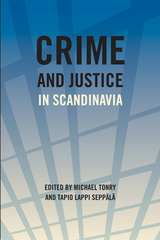 Crime and Justice, Volume 40: Crime and Justice in Scandinavia
Edited by Michael Tonry and Tapio Lappi-Seppälä
University of Chicago Press Journals, 2012 Since 1979 the Crime and Justice series has presented a review of the latest international research, providing expertise to enhance the work of sociologists, psychologists, criminal lawyers, justice scholars, and political scientists. The series explores a full range of issues concerning crime, its causes, and its cure.
Volume 40, Crime and Justice in Scandinavia, offers the most comprehensive and authoritative look ever available at criminal justice policies, practices, and research in the Nordic countries. Topics range from the history of violence through juvenile delinquency, juvenile justice, and sentencing to controversial contemporary policies on prostitution, victims, and organized crime. Contributors to this volume include Jon-Gunnar Bernburg, Ville Hinkkanen, Cecilie Høigård, Hanns von Hofer, Charlotta Holmström, Janne Kivivuori, Lars Korsell, Tapio Lappi-Seppälä, Paul Larsson, Martti Lehti, Torkild Hovde Lyngstad, Sven-Axel Månsson, Anita Rönneling, Lise-Lotte Rytterbro, Torbjørn Skardhamar, May-Len Skilbrei, and Henrik Tham.
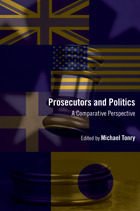 Crime and Justice, Volume 41: Prosecutors and Politics: A Comparative Perspective
Edited by Michael Tonry
University of Chicago Press Journals, 2012 Prosecutors are powerful figures in any criminal justice system. They decide what crimes to prosecute, whom to pursue, what charges to file, whether to plea bargain, how aggressively to seek a conviction, and what sentence to demand. In the United States, citizens can challenge decisions by police, judges, and corrections officials, but courts keep their hands off the prosecutor. Curiously, in the United States and elsewhere, very little research is available that examines this powerful public role. And there is almost no work that critically compares how prosecutors function in different legal systems, from state to state or across countries. Prosecutors and Politics begins to fill that void.
Police, courts, and prisons are much the same in all developed countries, but prosecutors differ radically. The consequences of these differences are enormous: the United States suffers from low levels of public confidence in the criminal justice system and high levels of incarceration; in much of Western Europe, people report high confidence and support moderate crime control policies; in much of Eastern Europe, people’s perceptions of the law are marked by cynicism and despair. Prosecutors and Politics unpacks these national differences and provides insight into this key area of social control.
Since 1979 the Crime and Justice series has presented a review of the latest international research, providing expertise to enhance the work of sociologists, psychologists, criminal lawyers, justice scholars, and political scientists. The series explores a full range of issues concerning crime, its causes, and its cure.
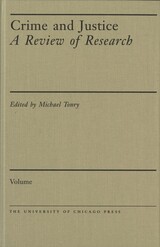 Crime and Justice, Volume 42: Crime and Justice in America: 1975-2025
Edited by Michael Tonry
University of Chicago Press Journals, 2012 For the American criminal justice system, 1975 was a watershed year. Offender rehabilitation and individualized sentencing fell from favor. The partisan politics of “law and order” took over. Among the results four decades later are the world’s harshest punishments and highest imprisonment rate. Policymakers’ interest in what science could tell them plummeted just when scientific work on crime, recidivism, and the justice system began to blossom. Some policy areas—sentencing, gun violence, drugs, youth violence—became evidence-free zones. In others—developmental crime prevention, policing, recidivism studies, evidence mattered. Crime and Justice in America: 1975-2025 tells how policy and knowledge did and did not interact over time and charts prospects for the future. What accounts for the timing of particular issues and research advances? What did science learn or reveal about crime and justice, and how did that knowledge influence policy? Where are we now, and, perhaps even more important, where are we going?
The contributors to this volume, the leading scholars in their fields, bring unsurpassed breadth and depth of knowledge to bear in answering these questions. They include Philip J. Cook, Francis T. Cullen, Jeffrey Fagan, David Farrington, Daniel S. Nagin, Peter Reuter, Lawrence W. Sherman, and Franklin E. Zimring.
For thirty-five years, the Crime and Justice series has provided a platform for the work of sociologists, psychologists, criminal lawyers, justice scholars, and political scientists as it explores the full range of issues concerning crime, its causes, and it remedies.
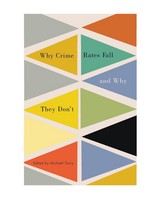 Crime and Justice, Volume 43: Why Crime Rates Fall, and Why They Don't
Edited by Michael Tonry
University of Chicago Press Journals, 2015 Violent and property crime rates in all Western countries have been falling since the early and mid-1990s, after rising in the 1970s and 1980s. Few people have noticed the common patterns and fewer have attempted to understand or explain them. Yet the implications are essential for thinking about crime control and criminal justice policy more broadly. Crime rates in Canada and the United States, for example, have moved in parallel for 40 years, but Canada has neither increased its imprisonment rate nor adopted harsher criminal justice policies. The implication is that something other than mass imprisonment, zero-tolerance policing, and “three-strikes” laws explains why crime rates in our time are falling. The essays in this 43rd volume of Crime and Justice explore the possibilities cross-nationally. They document the common rises and falls in crime and look at possible explanations, including changes in sensitivity to violence generally and intimate violence in particular, macro-level changes in self-control, and structural and economic developments in modern states.
The contributors to this volume include Marcelo Aebi, Andromachi Tseloni, Eric Baumer, Manuel Eisner, Graham Farrell, Janne Kivivuori, Tapio Lappi-Seppälä, Suzy McElrath, Richard Rosenfeld, Rossella Selmini, Nick Tilley, and Kevin T. Wolff.
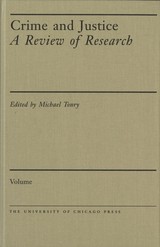 Crime and Justice, Volume 44: A Review of Research
Edited by Michael Tonry
University of Chicago Press Journals, 2015 Volume 44 of Crime and Justice is essential reading for scholars, policy makers, and practitioners who need to know about the latest advances in knowledge concerning crime, its causes, and its control. Contents include Robert D. Crutchfield on the complex interactions among race, social class, and crime; Cassia Spohn on race, crime, and punishment in America; Marianne van Ooijen and Edward Kleemans on the “Dutch model” of drug policy; Beau Kilmer, Peter Reuter, and Luca Giommoni on cross-national and comparative knowledge about drug use and control drugs; Michael Tonry on federal sentencing policy since 1984; Kathryn Monahan, Laurence Steinberg, and Alex R. Piquero on the growing influence of bioscience and developmental psychology on juvenile justice policy and practice; Cheryl Lero Jonson and Francis T. Cullen on prisoner reentry programs; James P. Lynch and Lynn A. Addington on cultural changes in tolerance of violence amd their effects on crime statistics; Brandon C. Welsh, David P. Farrington, and B. Raffan Gowar on benefit-cost analysis of crime prevention; Torbjorn Skardhamar, Jukka Savolainen, Kjersti N. Aase, and Torkild H. Lyngstad on the effects of marriage on criminality; and John MacDonald on the effects on crime rates and patterns of urban design and development.
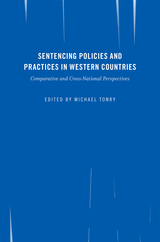 Crime and Justice, Volume 45: Sentencing Policies and Practices in Western Countries: Comparative and Cross-National Perspectives
Edited by Michael Tonry
University of Chicago Press Journals, 2016 Sentencing Policies and Practices in Western Countries: Comparative and Cross-national Perspectives is the forty-fifth addition to the Crime and Justice series. Contributors include Thomas Weigend on criminal sentencing in Germany since 2000; Julian V. Roberts and Andrew Ashworth on the evolution of sentencing policy and practice in England and Wales from 2003 to 2015; Jacqueline Hodgson and Laurène Soubise on understanding the sentencing process in France; Anthony N. Doob and Cheryl Marie Webster on Canadian sentencing policy in the twenty-first century; Arie Freiberg on Australian sentencing policies and practices; Krzysztof Krajewski on sentencing in Poland; Alessandro Corda on Italian policies; Michael Tonry on American sentencing; and Tapio Lappi-Seppälä on penal policy and sentencing in the Nordic countries.
Crime and Justice, Volume 46: Reinventing American Criminal Justice
Edited by Michael Tonry
University of Chicago Press Journals, 2017 Justice Futures: Reinventing American Criminal Justice is the forty-sixth volume in the Crime and Justice series. Contributors include Francis Cullen and Daniel Mears on community corrections; Peter Reuter and Jonathan Caulkins on drug abuse policy; Harold Pollack on drug treatment; David Hemenway on guns and violence; Edward Mulvey on mental health and crime; Edward Rhine, Joan Petersilia, and Kevin Reitz on parole policies; Daniel Nagin and Cynthia Lum on policing; Craig Haney on prisons and incarceration; Ronald Wright on prosecution; and Michael Tonry on sentencing policies.
Crime and Justice, Volume 47: A Review of Research
Edited by Michael Tonry
University of Chicago Press Journals, 2018 Since 1979, the Crime and Justice series has presented a review of the latest international research, providing expertise to enhance the work of sociologists, psychologists, criminal lawyers, justice scholars, and political scientists. The series explores a full range of issues concerning crime, its causes, and its cures. In both the review and the thematic volumes, Crime and Justice offers an interdisciplinary approach to address core issues in criminology. Volume 47 will be a review volume featuring, among other selections, a top-of-class impact ranking.
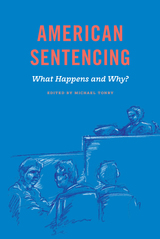 Crime and Justice, Volume 48: American Sentencing
Edited by Michael Tonry
University of Chicago Press Journals, 2019 American Sentencing provides an up-to-date and comprehensive overview of efforts in the state and the federal systems to make sentencing fairer, reduce overuse of imprisonment, and help offenders live law-abiding lives. It addresses a variety of topics and themes related to sentencing and reform, including racial disparities, violence prediction, plea negotiation, case processing, federal and state guidelines, California’s historic “realignment,” and more.
This volume covers what students, scholars, practitioners, and policy makers need to know about how sentencing really works, what a half century’s “reforms” have and have not accomplished, how sentencing processes can be made fairer, and how sentencing outcomes can be made more just. Its writers are among America’s leading scholarly specialists—often the leading specialist—in their fields.
Clearly and accessibly written, American Sentencing is ideal for teaching use in seminars and courses on sentencing, courts, and criminal justice. Its authors’ diverse perspectives shed light on these issues, making it likely the single, most authoritative source of information on the state of sentencing in America today.
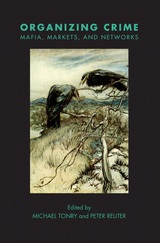 Crime and Justice, Volume 49: Organizing Crime: Mafias, Markets, and Networks
Edited by Michael Tonry and Peter Reuter
University of Chicago Press Journals, 2021 For most Americans, The Godfather, The Sopranos, and the Cosa Nostra exemplify organized crime. In Asia the term conjures up images of Japanese yakuza and Chinese triads, in Italy the Cosa Nostra and ‘Ndrangheta, in Latin America Mexican narco-gangs and Colombian drug cartels, in the Netherlands transnational drug and human trafficking, and in Scandinavia outlaw motorcycle gangs. Some but not all those organizations are “mafias” with centuries-long histories, distinctive cultures, and complicated relationships with local communities and governments. Others are new, large but transitory and with no purpose other than maximizing profits from illegal markets.
Organized crime organizations have existed for centuries. Serious scholarly, as opposed to journalistic or law enforcement, efforts to understand them, however, date back only a few decades. Authoritative overviews were, until very recently, impossible. Rigorous, analytically acute, and methodologically sophisticated literatures did not exist. They have begun to emerge. They have developed in many countries, involve work in different languages and disciplines, and deploy a wide range of methods.
Organizing Crime: Mafias, Markets, and Networks provides the most exhaustive overview ever published of knowledge about organized crime. It provides intensive accounts of American, Italian, and Dutch developments, covers both national mafias and transnational criminality, and delves in depth into gender, human capital, and money laundering issues. The writers are based in seven countries. To a person they are, or are among, the world’s most distinguished specialists in their subjects. At last, credible explanations and testable hypotheses are available concerning when, why, and under what circumstances mafias and other organized crime organizations come into being, what makes them distinctive, what they do and with what effects, and how to contain them.
Crime and Justice, Volume 50: A Review of Research
Edited by Michael Tonry
University of Chicago Press Journals, 2021 Since 1979 the Crime and Justice series has presented a review of the latest international research, providing expertise to enhance the work of sociologists, psychologists, criminal lawyers, justice scholars, and political scientists. The series explores a full range of issues concerning crime, its causes, and its cures. In both the review and the thematic volumes, Crime and Justice offers an interdisciplinary approach to address core issues in criminology.
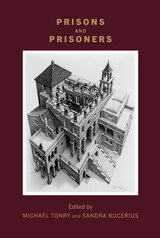 Crime and Justice, Volume 51: Prisons and Prisoners
Edited by Michael Tonry and Sandra Bucerius
University of Chicago Press Journals, 2022 Volume 51 is a thematic volume on Prisons and Prisoners.
Since 1979, the Crime and Justice series has presented a review of the latest international research, providing expertise to enhance the work of sociologists, psychologists, criminal lawyers, justice scholars, and political scientists. The series explores a full range of issues concerning crime, its causes, and its cures. In both the review and the occasional thematic volumes, Crime and Justice offers an interdisciplinary approach to address core issues in criminology.
Volume 51 of Crime and Justice is the first to reprise a predecessor, Prisons (Volume 26, 1999), edited by series editor Michael Tonry and the late Joan Petersilia. In Prisons and Prisoners, editors Michael Tonry and Sandra Bucerius revisit the subject for several reasons.
In 1999, most scholarly research concerned developments in Britain and the United States and was published in English. Much of that was sociological, focused on inmate subcultures, or psychological, focused on how prisoners coped with and adapted to prison life. Some, principally by economists and statisticians, sought to measure the crime-preventive effects of imprisonment generally and the deterrent effects of punishments of greater and lesser severity. In 2022, serious scholarly research on prisoners, prisons, and the effects of imprisonment has been published and is underway in many countries. That greater cosmopolitanism is reflected in the pages of this volume. Several essays concern developments in places other than Britain and the United States. Several are primarily comparative and cover developments in many countries. Those primarily concerned with American research draw on work done elsewhere.
The subjects of prison research have also changed. Work on inmate subcultures and coping and adaptation has largely fallen by the wayside. Little is being done on imprisonment’s crime-preventive effects, largely because they are at best modest and often perverse. An essay in Volume 50 of Crime and Justice, examining the 116 studies then published on the effects of imprisonment on subsequent offending, concluded that serving a prison term makes ex-prisoners on average more, not less, likely to reoffend.
In 1999, little research had been done on the effects of imprisonment on prisoners’ families, children, or communities, or even—except for recidivism— on ex-prisoners’ later lives: family life, employment, housing, physical and mental health, or achievement of a conventional, law-abiding life. The first comprehensive survey of what was then known was published in the earlier Crime and Justice: Prisons volume. An enormous literature has since emerged, as essays in this volume demonstrate. Comparatively little work had been done by 1999 on the distinctive prison experiences of women and members of non-White minority groups. That too has changed, as several of the essays make clear.
What is not clear is the future of imprisonment. Through more contemporary and global lenses, the essays featured in this volume not only reframe where we are in 2022 but offer informed insights into where we might be heading.
Crime and Justice, Volume 52: A Review of Research
Edited by Michael Tonry
University of Chicago Press Journals, 2024 Volume 52 is an annual survey of cutting-edge issues by preeminent criminology scholars.
Since 1979, Crime and Justice has presented a review of the latest international research, providing expertise to enhance the work of sociologists, psychologists, criminal lawyers, justice scholars, and political scientists. The series explores a full range of issues concerning crime, its causes, and its cures. In both the review and the thematic volumes, Crime and Justice offers an interdisciplinary approach to address core issues in criminology.
Crime and Justice, Volume 53: Crime and Justice in Historical Perspective
Edited by Michael Tonry
University of Chicago Press Journals, 2024 Presents cutting-edge scholarship by preeminent criminology scholars.
Since 1979, Crime and Justice has presented a review of the latest international research, providing expertise to enhance the work of sociologists, psychologists, criminal lawyers, justice scholars, and political scientists. The series explores a full range of issues concerning crime, its causes, and its cures. In both the review and the thematic volumes, Crime and Justice offers an interdisciplinary approach to address core issues in criminology.
Crime and Justice, Volume 8: Communities and Crime
Edited by Albert J. Reiss Jr. and Michael Tonry
University of Chicago Press Journals, 1987 How does crime relate to the quality of life in communities? What role does fear play in influencing crime patterns? What is the effect of crime on a community's school's teachers, and pupils? How does environmental design affect crime? Can household and community mobilization change crime patterns?
Examining the ways in which communities both affect crime and are affected by it, this volume seeks to explain the wide variation of crime levels among different communities. As it attempts to redress the bias toward describing crime in terms of individuals, Communities and Crime brings concentrated attention to crime at a community level, suggesting ways in which neighborhoods can change their crime patterns.
Crime and Justice, Volume 9: Prediction and Classification in Criminal Justice Decision Making
Edited by Don M. Gottfredson and Michael Tonry
University of Chicago Press Journals, 1988 Prediction and Classification: Criminal Justice Decision Making, a collection of commissioned essays by distinguished international scholars, is the ninth volume in the Crime and Justice series. Like its predecessors, Prediction and Classification is essential reading for scholars and researchers seeking a unified source of knowledge about crime, its causes, and its cure.
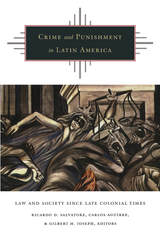 Crime and Punishment in Latin America: Law and Society Since Late Colonial Times
Ricardo D. Salvatore, Carlos Aguirre, and Gilbert M. Joseph, eds.
Duke University Press, 2001 Crowning a decade of innovative efforts in the historical study of law and legal phenomena in the region, Crime and Punishment in Latin America offers a collection of essays that deal with the multiple aspects of the relationship between ordinary people and the law. Building on a variety of methodological and theoretical trends—cultural history, subaltern studies, new political history, and others—the contributors share the conviction that law and legal phenomena are crucial elements in the formation and functioning of modern Latin American societies and, as such, need to be brought to the forefront of scholarly debates about the region’s past and present. While disassociating law from a strictly legalist approach, the volume showcases a number of highly original studies on topics such as the role of law in processes of state formation and social and political conflict, the resonance between legal and cultural phenomena, and the contested nature of law-enforcing discourses and practices. Treating law as an ambiguous and malleable arena of struggle, the contributors to this volume—scholars from North and Latin America who represent the new wave in legal history that has emerged in recent years-- demonstrate that law not only produces and reformulates culture, but also shapes and is shaped by larger processes of political, social, economic, and cultural change. In addition, they offer valuable insights about the ways in which legal systems and cultures in Latin America compare to those in England, Western Europe, and the United States. This volume will appeal to scholars in Latin American studies and to those interested in the social, cultural, and comparative history of law and legal phenomena. Contributors. Carlos Aguirre, Dain Borges, Lila Caimari, Arlene J. Díaz, Luis A. Gonzalez, Donna J. Guy, Douglas Hay, Gilbert M. Joseph, Juan Manuel Palacio, Diana Paton, Pablo Piccato, Cristina Rivera Garza, Kristin Ruggiero, Ricardo D. Salvatore, Charles F. Walker
 Crime and Punishment in Medieval Chinese Drama: Three Judge Pao Plays of the Yuan and Ming Dynasties
George A. Hayden
Harvard University Press, 1978 The Chinese were writing detective stories at least three hundred years before Edgar Allan Poe and courtroom drama about two hundred years before that. In the thirteenth and fourteenth centuries, courtroom drama was a popular sub-genre—with the judge-hero Pao Cheng of the Sung dynasty as a principal character—and crime and punishment as its most important themes.
In Crime and Punishment in Medieval Chinese Drama George A. Hayden translates three Judge Pao plays: "Selling Rice at Ch'ien-chu," "The Ghost of the Pot," and "The Flower in the Back Courtyard." In his introduction Professor Hayden explains the structure of the dramas, which were sung as well as spoken, and their moral significance in the light of traditional Chinese ethics. He also traces the legend of the wise and incorruptible but very human Judge Pao through the years to its high point in Yuan and early Ming drama. The book is annotated for the general reader as well as for the specialist and contains a list of twenty-seven courtroom plays and a list of late Ming anthologies in which these plays appear.
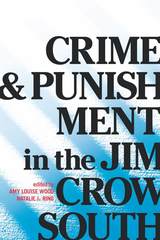 Crime and Punishment in the Jim Crow South
Edited by Amy Louise Wood and Natalie J. Ring
University of Illinois Press, 2019 Policing, incarceration, capital punishment: these forms of crime control were crucial elements of Jim Crow regimes. White southerners relied on them to assert and maintain racial power, which led to the growth of modern state bureaucracies that eclipsed traditions of local sovereignty. Friction between the demands of white supremacy and white southern suspicions of state power created a distinctive criminal justice system in the South, elements of which are still apparent today across the United States. In this collection, Amy Louise Wood and Natalie J. Ring present nine groundbreaking essays about the carceral system and its development over time. Topics range from activism against police brutality to the peculiar path of southern prison reform to the fraught introduction of the electric chair. The essays tell nuanced stories of rapidly changing state institutions, political leaders who sought to manage them, and African Americans who appealed to the regulatory state to protect their rights. Contributors: Pippa Holloway, Tammy Ingram, Brandon T. Jett, Seth Kotch, Talitha L. LeFlouria, Vivien Miller, Silvan Niedermeier, K. Stephen Prince, and Amy Louise Wood
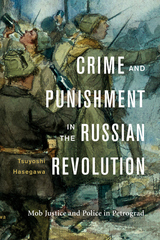 Crime and Punishment in the Russian Revolution: Mob Justice and Police in Petrograd
Tsuyoshi Hasegawa
Harvard University Press, 2017 Russians from all walks of life poured into the streets of the imperial capital after the February Revolution of 1917, joyously celebrating the end of Tsar Nicholas II’s monarchy. One year later, with Lenin’s Bolsheviks now in power, Petrograd’s deserted streets presented a very different scene. No celebrations marked the Revolution’s anniversary. Amid widespread civil strife and lawlessness, a fearful citizenry stayed out of sight.
In Crime and Punishment in the Russian Revolution, Tsuyoshi Hasegawa offers a new perspective on Russia’s revolutionary year through the lens of violent crime and its devastating effect on ordinary people. When the Provisional Government assumed power after Nicholas II’s abdication, it set about instituting liberal reforms, including eliminating the tsar’s regular police. But dissolving this much-hated yet efficient police force and replacing it with a new municipal police led rapidly to the breakdown of order and services. Amid the chaos, crime flourished. Gangs of criminals, deserters, and hooligans brazenly roamed the streets. Mass prison escapes became common. And vigilantism spread widely as ordinary citizens felt compelled to take the law into their own hands, often meting out mob justice on suspected wrongdoers.
The Bolsheviks swept into power in the October Revolution but had no practical plans to reestablish order. As crime continued to escalate and violent alcohol riots almost drowned the revolutionary regime, they redefined it as “counterrevolutionary activity,” to be dealt with by the secret police, whose harshly repressive, extralegal means of enforcement helped pave the way for a Communist dictatorship.
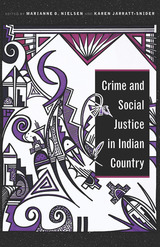 Crime and Social Justice in Indian Country
Edited by Marianne O. Nielsen and Karen Jarratt-Snider
University of Arizona Press, 2018 In Indigenous America, human rights and justice take on added significance. The special legal status of Native Americans and the highly complex jurisdictional issues resulting from colonial ideologies have become deeply embedded into federal law and policy. Nevertheless, Indigenous people in the United States are often invisible in discussions of criminal and social justice.
Crime and Social Justice in Indian Country calls to attention the need for culturally appropriate research protocols and critical discussions of social and criminal justice in Indian Country. The contributors come from the growing wave of Native American as well as non-Indigenous scholars who employ these methods. They reflect on issues in three key areas: crime, social justice, and community responses to crime and justice issues. Topics include stalking, involuntary sterilization of Indigenous women, border-town violence, Indian gaming, child welfare, and juvenile justice. These issues are all rooted in colonization; however, the contributors demonstrate how Indigenous communities are finding their own solutions for social justice, sovereignty, and self-determination.
Thanks to its focus on community responses that exemplify Indigenous resilience, persistence, and innovation, this volume will be valuable to those on the ground working with Indigenous communities in public and legal arenas, as well as scholars and students. Crime and Social Justice in Indian Country shows the way forward for meaningful inclusions of Indigenous peoples in their own justice initiatives.
Contributors
Alisse Ali-Joseph
William G. Archambeault
Cheryl Redhorse Bennett
Danielle V. Hiraldo
Lomayumptewa K. Ishii
Karen Jarratt-Snider
Eileen Luna-Firebaugh
Anne Luna-Gordinier
Marianne O. Nielsen
Linda M. Robyn
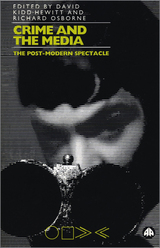 Crime and the Media: The Post-Modern Spectacle
Edited by David Kidd-Hewitt and Richard Osborne
Pluto Press, 1996 This book brings together key debates within cultural studies, media studies, criminology and sociology on the relationship between the media and crime in a postmodern society – highlighted by recent controversies on the effects of media portrayals of violence and crime on the community at large.
Real-life crime, crime reconstruction and crime as entertainment are categories that are now so interdependent that the media itself is in danger of confusing the genres as it seeks to profit from their undoubted appeal. This intertextuality is a key theme in this collection. The contributors highlight and theorise the symbiosis that exists between real crime and its representations, from media moral panics, policing the crisis and representing order to the postmodern confusion of crime and spectacle, trial by media and trials on media. As recent debates have shown all too starkly, the media's neutrality in this critical area is ever more problematic.
This is an invaluable introduction to new thinking in a pressing contemporary debate.
 Crime, Corrections, and the COVID-19 Pandemic: Responses and Adaptations in the U.S. Criminal Justice System
Edited by Breanne Pleggenkuhle and Joseph A. Schafer
Southern Illinois University Press, 2025 Analyses of crime and justice in an unprecedented time
While COVID-19 lockdowns affected nearly everyone worldwide, feelings of anxiety and fear were exacerbated for those already entangled in the criminal justice system. Scholars recognized the unique opportunity to study crime and the justice system’s response during this period, though they soon realized that determining the pandemic’s effects would be a complicated, nuanced process.
Crime, Corrections, and the COVID-19 Pandemic features analyses and findings from more than thirty contributors in eleven essays. The collection examines the multifaceted social, economic, cultural, legislative, and policy responses to COVID-19 and their impacts on crime and justice. It also explores how professionals across the criminal justice system—police officers, campus police officers, attorneys, judges, correctional staff, and community supervision agents—adapted to unprecedented challenges.
The book provides real-world evidence of how unconventional solutions and groundbreaking practices were implemented in response to a global crisis. Contributors analyze how incarcerated individuals, their families, and their supervisors dealt with the fear of transmission, medical care, and death. Their findings, which are necessarily dependent on timing, place, measurement, and operationalization, include both change and stasis, both negative and positive outcomes. For instance, while minor and property-related offenses initially declined, violent crimes like homicide and intimate partner violence increased. Drug usage patterns changed, leading to a rise in opioid overdoses, and despite the rise in digital interactions, there was no significant difference in self-reported cybervictimization. Furthermore, rates of gang-related crimes did not decrease. Policy and public health responses reshaped criminal activities, influencing the methods and motivations behind theft, child and elder abuse, and other offenses. This volume includes in-depth examinations of certain often-overlooked crimes, such as labor trafficking, and provides direct insights into the job challenges faced by criminal justice professionals, from probation personnel to labor rights advocates.
Emerging innovations in health risk management within correctional facilities led to increased awareness and focus on specific types of crime. Responses to the pandemic revealed significant challenges, such as burnout among justice system personnel, difficulties in adapting and innovating, and challenges in providing services to vulnerable populations.
Through diverse perspectives and empirical approaches ranging from advanced statistical analysis to qualitative interviews, Crime, Corrections, and the COVID-19 Pandemic offers a comprehensive exploration of the complexities that affect research results. It showcases the resilience and innovation within the criminal justice field and details the challenges professionals in this area tackled during a universally trying time, presenting valuable lessons for future crises.
Crime Fiction and Film in the Southwest: Bad Boys and Bad Girls in the Badlands
Edited by Steve Glassman and Maurice O'Sullivan
University of Wisconsin Press, 2001 When Joe Leaphorn and Jim Chee, Tony Hillerman’s oddly matched tribal police officers, patrol the mesas and canyons of their Navajo reservation, they join a rich traditon of Southwestern detectives. In Crime Fiction and Film in the Southwest, a group of literary critics tracks the mystery and crime novel from the Painted Desert to Death Valley and Salt Lake City. In addition, the book includes the first comprehensive bibliography of mysteries set in the Southwest and a chapter on Southwest film noir from Humphrey Bogart’s tough hood in The Petrified Forest to Russell Crowe’s hard-nosed cop in L.A. Confidential.
Crime in the Making: Pathways and Turning Points through Life
Robert J. Sampson and John H. Laub
Harvard University Press, 1993 This new explanation of crime over the life course provides an important foundation for rethinking contemporary theory and criminal justice policy. It is based on the reanalysis of a classic set of data: Unraveling Juvenile Delinquency, Sheldon and Eleanor Gluecks’ mid-twentieth-century study of 500 delinquents and 500 nondelinquents from childhood to adulthood. Several years ago, Robert Sampson and John Laub dusted off sixty cartons of the Gleucks’ data that had been stored in the basement of the Harvard Law School. After a lengthy process of recoding and reanalyzing these data, they developed and tested a theory of informal social control that acknowledges the importance of childhood behavior but rejects the implication that adult social factors have little relevance.
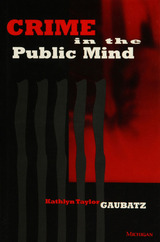 Crime in the Public Mind
Kathlyn Taylor Gaubatz
University of Michigan Press, 1995 Crime in the Public Mind explores the politics of crime and criminal justice, examining in depth what Americans think about penalties for criminal offenders. While some are resigned, others are desperate; a few are hopeful and forgiving, but most are frustrated and angry. In fact, fully eighty percent of the population believes that the court system should deal more harshly with criminal offenders. In this readable account, Kathlyn Taylor Gaubatz makes use of intensive interviews with Americans from varied walks of life in order to reveal the fascinating nuances in the public's views on criminal justice, and in their motivations for holding these views. She questions our easy acceptance of the very existence of a public consensus around such a complex, intractable issue as crime. Why do Americans support harsh penal policies when crime rates are actually falling? How does this attitude square with our increasingly liberal social ideas? What logic is there to support stiff sentencing when the vast majority of the public acknowledges that prisons have been powerless to reduce crime in our nation to an acceptable level? The author powerfully weaves narratives from those she interviewed to construct an in-depth theory about who joins and who spurns the consensus on criminal justice. She explores the complex relationship between our political beliefs and our attitudes toward crime, revealing in some cases a telling dissonance. Through careful argumentation and demonstration, Crime in the Public Mind concludes that Americans have become harsher on crime not in spite of becoming more liberal on a variety of other social issues, but at least in part because we have done so. At a time when crime has been called the political issue of the decade, Crime in the Public Mind forces us to confront our assumptions, to sort through our fear. It gives us an opportunity to balance our desire for safety and our desire to see justice done with our innate compassion and understanding. By exposing the paradoxes of our beliefs, the author pushes us to reconsider whether incarceration really is the answer to every criminal offense and invites us to contemplate saner and perhaps more effective approaches to criminal justice. "In the great tradition of Robert Lane's Political Ideology, Gaubatz has discovered that what the 'common man' (and woman) believes about crime and punishment is more complicated than the polling numbers would allow. While clearly in sympathy with those who dissent from get-tough approaches, she offers a balanced, insightful, and timely understanding of public attitudes about criminal justice. Experts, policymakers, students, and concerned citizens should read this fine book."- John J. DiIulio, Jr., Princeton University and Director, Brookings Institution Center for Public Management Kathlyn Taylor Gaubatz holds a Ph.D. in politics from Princeton University and is Executive Director of a non profit agency that provides housing, counseling, child-care, and other services to homeless families and individuals in San Franciso.
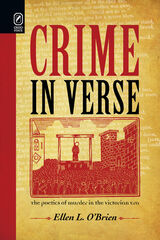 Crime in Verse: The Poetics of Murder in the Victorian Era
Ellen L. O’Brien
Ohio State University Press, 2008 Over the last few decades, Victorian scholars have produced many nuanced studies connecting the politics of crime to the generic developments of the novel—and vice versa. Ellen L. O’Brien’s Crime in Verse grants the same attention and status to poetic representations of crime. Considering the literary achievements and cultural engagements of poetry while historicizing murder’s entanglement in legal fictions, punitive practices, medical theories, class conflicts, and gender codes, O’Brien argues that shifting approaches to poetry and conflicted understandings of murder allowed poets to align problems of legal and literary interpretation in provocative, disruptive, and innovative ways.
Developing focused analyses of generic and discursive meanings, individual chapters examine the classed politics of crime and punishment in the broadside ballad, the epistemological tensions of homicidal lunacy and criminal responsibility in the dramatic monologue, and the legal and ideological frictions of domestic violence in the verse novel and verse drama. Their juxtaposition of the rhymes of anonymous street balladeers, the underexamined verse of “minor” poets, and the familiar poems of canonical figures suggests the interactive and intertextual relationships informing poetic agendas and political arguments. As it simultaneously reconsiders the institutional and ideological status of murder and the aesthetic and political interests of poetry, Crime in Verse offers new ways of thinking about Victorian poetry’s contents and contexts.
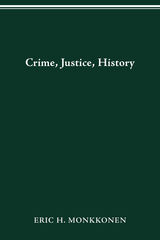 CRIME, JUSTICE, HISTORY
ERIC MONKKONEN
Ohio State University Press, 2002 Crime in the U.S. and the institutions for its control are deeply embedded in and shaped by history. The historical origins have often become invisible, and their recovery difficult, but any understanding of the contemporary situation requires historical context. For over twenty-five years Eric H. Monkkonen has worked on some of the puzzles and problems in recovering the history of crime and police. Much of his work has appeared in articles, often in specialized journals or not in English, which this book collects for the first time. In addition to Monkkonen’s major published articles, this volume includes several new ones. The topics embrace violence, public disorder, policing, popular culture, and contrasts between the U.S. and Europe. Some articles illuminate special methodological and source issues that challenge historians of criminal justice. As well as dealing with serious crime, this book includes several articles on specifically urban problems and solutions associated with disorder, crime, and poverty. In contrast to the more technical articles, several chapters, which originally appeared as op-ed pieces, show how historical understanding can help address current policy issues in crime and crime control. All too often, current policy debates occur without proper historical background. As a result, old ideas that have been tried and rejected are re-introduced, or new and sometimes simple ideas are ignored.
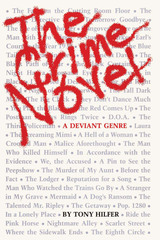 The Crime Novel: A Deviant Genre
By Tony Hilfer
University of Texas Press, 1990 Although rarely distinguished from the detective story, the crime novel offers readers a quite different experience. In the detective novel, a sympathetic detective figure uses reason and intuition to solve the puzzle, restore order, and reassure readers that "right" will always prevail. In the crime novel, by contrast, the "hero" is either the killer, the victim, a guilty bystander, or someone falsely accused, and the crime may never be satisfactorily solved. These and other fundamental differences are set out by Tony Hilfer in The Crime Novel, the first book that completely defines and explores this popular genre. Hilfer offers convincing evidence that the crime novel should be regarded as a genre distinct from the detective novel, whose conventions it subverts to develop conventions of its own. Hilfer provides in-depth analyses of novels by Georges Simenon, Margaret Millar, Patricia Highsmith, and Jim Thompson. He also treats such British novelists as Patrick Hamilton, Shelley Smith, and Marie Belloc Lowndes, as well as the American novelists Cornell Woolrich, John Franklin Bardin, James M. Cain, and Fredric Brown. In addition, he defines the distinctions between the American crime novel and the British, showing how their differences correspond to differences in American and British detective fiction. This well-written study will appeal to a general audience, as well as teachers and students of detective and mystery fiction. For anyone interested in the genre, it offers valuable suggestions of "what to read next."
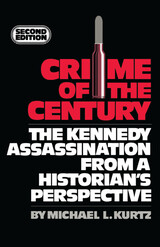 Crime Of Century: Kennedy Assassination From
Michael L. Kurtz
University of Tennessee Press, 1993 The assassination of President John F. Kennedy has generated countless books, virtually all of them heavily biased for or against the “lone assassination” conclusion of the Warren Commission. Now, in the first scholarly treatment of the assassination, Michael Kurtz brings all the skills and objectivity of the professional historian to bear on the key question: “Who killed President Kennedy?”
This book recounts the tragic events of November 22, 1963, and provides a detailed critical analysis of the investigations of the Warren Commission and the House Select Committee on Assassinations. Professor Kurtz outlines the major areas of controversy about the assassination and sifts all the known evidence before concluding that both official inquiries failed to evaluate the considerable evidence of an assassination conspiracy. Operating on the a priori assumption that Lee Harvey Oswald was guilty, the Commission and the Committee both ignored and distorted the overwhelming evidence that more than one assassin fired shots at the president. Professor Kurtz also shows why the most prevalent conspiracy theories fail to fit the facts and concludes by offering a new and more plausible theory of how the assassination occurred.
Thoroughly documented and based on the most exhaustive research carried out to date on John Kennedy’s murder, Crime of the Century draws on a variety of primary source materials from the National Archives and the FBI’s and CIA’s declassified assassination files. It utilizes the latest source materials released by the House Select Committee’s investigation. The depth of research, the rigorously objective sifting of evidence, and the incisive critique of official investigative bias make this a book of importance not only to students of the Kennedy assassination in particular, but also to scholars of government response to political violence in general.
Michael L. Kurtz is professor of history at Southeastern Louisiana University, Hammond, Louisiana. He is co-author of LOUISIANA: A HISTORY and was associate editor for READINGS IN LOUISIANA HISTORY.
The Crime of Galileo
Giorgio de Santillana
University of Chicago Press, 1955 "In the gallery of what might be called the martyrs of thought, the image of Galileo recanting before the Italian Inquisition stirs the minds of educated modern men second only to the picture of Socrates drinking the Hemlock. That image of Galileo is out of focus . . . because it has been distorted by three centuries of rationalist prejudice and clerical polemics. To refocus it clearly, within the logic of its own time . . . de Santillana has written The Crime of Galileo, a masterly intellectual whodunit which traces not the life but the mental footsteps of Galileo on his road to personal tragedy."—Time
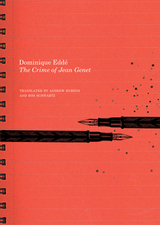 The Crime of Jean Genet
Dominique Eddé
Seagull Books, 2016 Now in paperback, The Crime of Jean Genet is a powerful personal account of the influence of one writer on another and one of the most penetrating explorations yet of Genet’s work and achievement.
Dominique Eddé met novelist and playwright Jean Genet in the 1970s. And she never forgot him. “His presence,” she writes, “gave me the sensation of icy fire. Like his words, his gestures were full, calculated, and precise. . . . Genet’s movements mimicked the movement of time, accumulating rather than passing.”
This book is Eddé’s account of that meeting and its ripples through her years of engaging with Genet’s life and work. Rooted in personal reminiscences, it is nonetheless much broader, offering a subtle analysis of Genet’s work and teasing out largely unconsidered themes, like the absence of the father, which becomes a metaphor for Genet’s perpetual attack on the law. Tying Genet to Dostoevsky through their shared fascination with crime, Eddé helps us more clearly understand Genet’s relationship to France and Palestine, Judaism, Christianity, Islam, the theater, and even death. A powerful personal account of the influence of one writer on another, The Crime of Jean Genet is also one of the most penetrating explorations yet of Genet’s work and achievement.
A Crime of Self-Defense: Bernhard Goetz and the Law on Trial
George P. Fletcher
University of Chicago Press, 1990 The popular press dubbed him "the subway vigilante": Bernhard Goetz, who on December 22, 1984, shot four black youths on a New York subway train when one of them asked for five dollars. Goetz claimed to have fired in self-defense, out of fear that the young men were about to rob him.
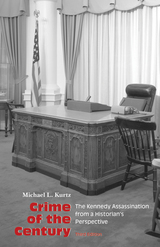 Crime of the Century: The Kennedy Assassination from a Historian's Perspective
Michael L. Kurtz
University of Tennessee Press, 2013 Now a classic, Michael Kurtz’s Crime of the Century recounts the assassination of President John F. Kennedy on November 22, 1963, and provides a detailed critical analysis of the investigations of the Warren Commission and the House Select Committee on Assassinations. Kurtz outlines the major areas of controversy about the assassination and sifts all the known evidence before concluding that both official inquiries failed to evaluate the considerable evidence of an assassination conspiracy. Kurtz also examines each of the most prevalent conspiracy theories and shows how often they fail to fit the facts.
This third edition includes a new introduction, based on updated information about the assassination since the second edition was published in 1993, including material from the National Archives and several major recent interpretations of the events. Drawing on a variety of primary source materials from the National Archives and the FBI’s and CIA’s declassified assassination files, Crime of the Century remains a book of importance not only to students of the Kennedy assassination but also scholars of government response to political violence.
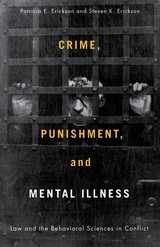 Crime, Punishment, and Mental Illness: Law and the Behavioral Sciences in Conflict
Erickson, Patricia
Rutgers University Press, 2008 Hundreds of thousands of the inmates who populate the nation's jails and prison systems today are identified as mentally ill. Many experts point to the deinstitutionalization of mental hospitals in the 1960s, which led to more patients living on their own, as the reason for this high rate of incarceration. But this explanation does not justify why our society has chosen to treat these people with punitive measures.
In Crime, Punishment, and Mental Illness, Patricia E. Erickson and Steven K. Erickson explore how societal beliefs about free will and moral responsibility have shaped current policies and they identify the differences among the goals, ethos, and actions of the legal and health care systems. Drawing on high-profile cases, the authors provide a critical analysis of topics, including legal standards for competency, insanity versus mental illness, sex offenders, psychologically disturbed juveniles, the injury and death rates of mentally ill prisoners due to the inappropriate use of force, the high level of suicide, and the release of mentally ill individuals from jails and prisons who have received little or no treatment.
 Crime Uncovered: Anti-hero
Edited by Fiona Peters and Rebecca Stewart
Intellect Books, 2015 There are few figures as captivating as the antihero: the character we can’t help but root for, even as we turn away in revulsion from many of the things they do. What is it that draws us to characters like Breaking Bad’s Walter White, Patricia Highsmith’s Tom Ripley, and Stieg Larsson’s Lisbeth Salander even as we decry the trail of destruction they leave in their wake?
Crime Uncovered: Antihero tackles that question and more. Mixing the popular and iconic, contemporary and ancient, the book explores the place and appeal of the antihero. Using figures from books, TV, film, and more, including such up-to-the-minute examples as True Detective’s Rust Cole, the book places the antihero’s actions within the society he or she is rejecting, showing how expectations and social and familial structures create the backdrop against which the antihero’s posture becomes compelling. Featuring interviews with genre masters James Ellroy and Paul Johnston, Crime Uncovered: Antiherois an accessible, engaging analysis of what drives us to embrace those characters who acknowledge—or even flaunt—the dark side we all have somewhere deep inside.
 Crime Uncovered: Detective
Edited by Barry Forshaw
Intellect Books, 2015 For most of the twentieth century, the private eye dominated crime fiction and film, a lone figure fighting for justice, often in opposition to the official representatives of law and order. More recently, however, the police have begun to take center stage—as exemplified by the runaway success of TV police procedurals like Law and Order. In Crime Uncovered: Detective, Barry Forshaw offers an exploration of some of the most influential and popular fictional police detectives in the history of the genre.
Taking readers into the worlds of such beloved authors as P. D. James, Henning Mankell, Jo Nesbø, Ian Rankin, and Håkan Nesser, this book zeroes in on the characteristics that define the iconic characters they created, discussing how they relate to their national and social settings, questions of class, and to the criminals they relentlessly pursue. Showing how the role of the authority figure has changed—and how each of these writers creates characters who work both within and against the strictures of official investigations—the book shows how creators cleverly subvert expectations of both police procedure and the crime genre itself.
Written by a leading expert in the field and drawn from interviews with the featured authors, Crime Uncovered: Detectivewill thrill the countless fans of Inspector Rebus, Harry Hole, Adam Dalgliesh, and the other enduring police detectives who define the genre.
 Crime Uncovered: Private Investigator
Edited by Alistair Rolls and Rachel Franks
Intellect Books, 2016 The private investigator is one of the most enduring characters within crime fiction. From Dashiell Hammett’s Sam Spade— the hard-boiled loner trawling the mean streets—to Agatha Christie’s Captain Hastings—the genteel companion in greener surrounds—the P. I. has taken on any number of guises. In Crime Uncovered: Private Investigator, editors Alistair Rolls and Rachel Franks dive deep into crime literature and culture, challenging many of the assumptions we make about the hardy P. I.
Assembling a cast of notable crime fiction experts, including Stephen Knight and Carolyn Beasley, the book covers characters from the whole world of international noir—Giorgio Scerbanenco’s Duca Lambert, Léo Malet’s Nestor Burma, and many more. Including essays on the genealogy and emergence of the protagonist in nineteenth-century fiction; interviews with crime writers Leigh Redhead, Nick Quantrill, and Fernando Lalana; and analyses of the transatlantic exchanges that helped to develop public perception of a literary icon, Crime Uncovered: Private Investigator will redefine what we think we know about the figure of the P. I.
Rolls and Franks have engaged here the tension between the popular and scholarly that is inherent in any critical examination of a literary type, along the way unraveling the mystery of the alluring, enigmatic private investigator. Crime Uncovered: Private Investigator will be a handy companion for any crime fiction fan.
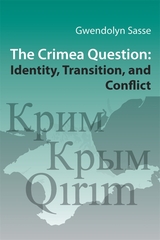 The Crimea Question: Identity, Transition, and Conflict
Gwendolyn Sasse
Harvard University Press, 2007 Regional diversity such as Ukraine's often embodies potential for friction and conflict, in particular when it involves territorialized ethnicity and divergent historical experiences. Political elites interested in stability and conflict prevention must find ways either to accommodate or control this diversity. In the early to mid-1990s, the Western media, policymakers, and academics alike warned that Crimea was a potential center of unrest in the aftermath of the Soviet Union's dissolution. However, large-scale conflict in Crimea did not materialize, and Kyiv has managed to integrate the peninsula into the new Ukrainian polity. This book explores the factors that led to the largely peaceful transition and places the situation in the larger context of conflict-prevention studies, explaining this critical case in which conflict did not erupt despite a structural predisposition to ethnic, regional, and even international enmity.
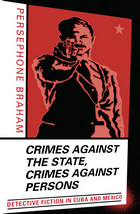 Crimes against the State, Crimes against Persons: Detective Fiction in Cuba and Mexico
Persephone Braham
University of Minnesota Press, 2004 An interpretation of the ideologies and kinships of detective fiction in Cuba and Mexico The transplanted, inherently modern detective genre serves as an especially effective lens for exposing the fissures and divergences of modernity in post-1968 Mexico and revolutionary Cuba. Combining in-depth critical analyses with the theoretical insights of current literary and cultural theory and Latin American postmodern studies, Crimes against the State, Crimes against Persons shows how the Cuban novela negra examines the Revolution through an incisive chronicle of life under a decaying regime, and how the Mexican neopoliciaco reveals the oppressive politics of modernization and globalization in Latin America.International in scope, comparative in approach, Braham’s study presents a unique inquiry into the ethical and aesthetic complexities that Latin American authors face in adapting genre detective fiction—a modern, metropolitan model—to radically diverse creative and ideological programs. Considering the work of writers such as Leonardo Padura Fuentes and Paco Ignacio Taibo II, as well as such English-language influences as G. K. Chesterton and Chester Himes, Braham also addresses Marxist critiques of the culture industry and emergent Latin American concepts of postmodernity.
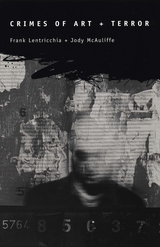 Crimes of Art and Terror
Frank Lentricchia and Jody McAuliffe
University of Chicago Press, 2003 Do killers, artists, and terrorists need one another? In Crimes of Art and Terror, Frank Lentricchia and Jody McAuliffe explore the disturbing adjacency of literary creativity to violence and even political terror. Lentricchia and McAuliffe begin by anchoring their penetrating discussions in the events of 9/11 and the scandal provoked by composer Karlheinz Stockhausen's reference to the destruction of the World Trade Center as a great work of art, and they go on to show how political extremism and avant-garde artistic movements have fed upon each other for at least two centuries.
Crimes of Art and Terror reveals how the desire beneath many romantic literary visions is that of a terrifying awakening that would undo the West's economic and cultural order. This is also the desire, of course, of what is called terrorism. As the authority of writers and artists recedes, it is criminals and terrorists, Lentricchia and McAuliffe suggest, who inherit this romantic, destructive tradition. Moving freely between the realms of high and popular culture, and fictional and actual criminals, the authors describe a web of impulses that catches an unnerving spirit.
Lentricchia and McAuliffe's unorthodox approach pairs Dostoevsky's Crime and Punishment with Martin Scorsese's King of Comedy and connects the real-life Unabomber to the surrealist Joseph Cornell and to the hero of Bret Easton Ellis's bestselling novel American Psycho. They evoke a desperate culture of art through thematic dialogues among authors and filmmakers as varied as Don DeLillo, Joseph Conrad, Francis Ford Coppola, Jean Genet, Frederick Douglass, Hermann Melville, and J. M. Synge, among others. And they conclude provocatively with an imagined conversation between Heinrich von Kleist and Mohamed Atta. The result is a brilliant and unflinching reckoning with the perilous proximity of the impulse to create transgressive art and the impulse to commit violence.
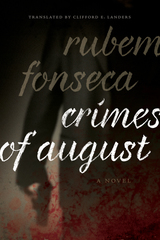 Crimes of August: A Novel
Rubem Fonseca
Tagus Press, 2014 Rubem Fonseca's Crimes of August offers the first serious literary treatment of the cataclysmic events of August 1954, arguably the most turbulent month in Brazilian history. A rich novel, both culturally and historically, Crimes of August tells two stories simultaneously. The first is private, involving the well-delineated character of Alberto Mattos, a police officer. The other is public, focusing on events that begin with the attempted assassination of Carlos Lacerda, a demagogic journalist and political enemy of President Getúlio Vargas, and culminate in Vargas's suicide on August 24,1954. Throughout this suspenseful novel, deceptively couched as a thriller, Fonseca interweaves fact and fiction in a complex, provocative plot. At the same time, he re-creates the atmosphere of the 1950s, when Rio de Janeiro was Brazil's capital and the nexus of political intrigue and corruption. Mattos is assigned to solve the brutal murder of a wealthy entrepreneur in the aftermath of what appears to be a homosexual liaison. An educated and introspective man, and one of the few in his precinct not on the take from the bankers" of the illegal lottery, Mattos suffers from alienation and a bleeding ulcer. His investigation puts him on a dangerous collision course with the conspiracy to depose Vargas, the novel's other narrative thread. The two overlap at several points, coming to their tragic end with the aged politician's suicide and Mattos's downfall.
The Crimes of Empire: Rogue Superpower and World Domination
Carl Boggs
Pluto Press, 2010 Imperial Nations advance their own interests by exploiting other societies. To those on the receiving end this is obvious, while inside the empire, a powerful ideological system of justification tends to hide all but the worst excess.
Carl Boggs argues that that the US began life two centuries ago as a nascent colonialist regime plundering and conquering the Native Tribes. The Indian wars were followed by perpetual militarism and warfare fuelled by a deep sense of national exceptionalism. The Crimes Of Empire examines several trends in this process, and illustrates the new depths plumbed since 9/11.
Violation of international agreements, treaties and laws and the use of prohibited weapons, support for death squads and torture are just some of the practices that Boggs highlights as he shows how technical superiority and media control prolong the American nightmare.
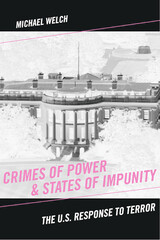 Crimes of Power & States of Impunity: The U.S. Response to Terror
Welch, Michael
Rutgers University Press, 2009 Since 9/11, a new configuration of power situated at the core of the executive branch of the U.S. government has taken hold. In Crimes of Power & States of Impunity, Michael Welch takes a close look at the key historical, political, and economic forces shaping the country's response to terror. Welch continues the work he began in Scapegoats of September 11th and argues that current U.S. policies, many enacted after the attacks, undermine basic human rights and violate domestic and international law. He recounts these offenses and analyzes the system that sanctions them, offering fresh insight into the complex relationship between power and state crime. Welch critically examines the unlawful enemy combatant designation, Guantanamo Bay, recent torture cases, and collateral damage relating to the war in Iraq. This book transcends important legal arguments as Welch strives for a broader sociological interpretation of what transpired early this century, analyzing the abuses of power that jeopardize our safety and security.
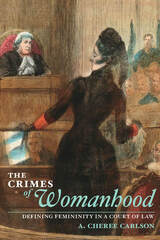 The Crimes of Womanhood: Defining Femininity in a Court of Law
A. Cheree Carlson
University of Illinois Press, 2014 Cultural views of femininity exerted a powerful influence on the courtroom arguments used to defend or condemn notable women on trial in nineteenth-century and early-twentieth-century America. By examining the colorful rhetorical strategies employed by lawyers and reporters of women's trials in newspaper articles, trial transcriptions, and popular accounts, A. Cheree Carlson argues that the men in charge of these communication avenues were able to transform their own values and morals into believable narratives that persuaded judges, juries, and the general public of a woman's guilt or innocence. Carlson analyzes the situations of several women of varying historical stature, from the insanity trials of Mary Todd Lincoln and Lizzie Borden's trial for the brutal slaying of her father and stepmother, to lesser-known trials involving insanity, infidelity, murder, abortion, and interracial marriage. The insanity trial of Elizabeth Parsons Ware Packard, the wife of a minister, resulted from her attempts to change her own religion, while a jury acquitted Mary Harris for killing her married lover, suggesting that loss of virginity to an adulterous man was justifiable grounds for homicide. The popular conception of abortion as a "woman's crime" came to the fore in the case of Ann Loman (also known as Madame Restell), who performed abortions in New York both before and after it became a crime. Finally, Alice Rhinelander was sued for fraud by her new husband Leonard for "passing" as white, but the jury was more moved by the notion of Alice being betrayed as a woman by her litigious husband than by the supposed defrauding of Leonard as a white male. Alice won the case, but the image of womanhood as in need of sympathy and protection won out as well. At the heart of these cases, Carlson reveals clearly just how narrow was the line that women had to walk, since the same womanly virtues that were expected of them--passivity, frailty, and purity--could be turned against them at any time. These trials of popular status are especially significant because they reflect the attitudes of the broad audience, indicate which forms of knowledge are easily manipulated, and allow us to analyze how the verdict is argued outside the courtroom in the public and press. With gripping retellings and incisive analysis of these scandalous criminal and civil cases, this book will appeal to historians, rhetoricians, feminist researchers, and anyone who enjoys courtroom drama.
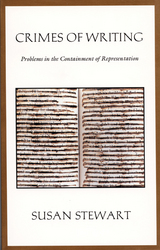 Crimes of Writing: Problems in the Containment of Representation
Susan Stewart
Duke University Press, 1994 From the origins of modern copyright in early eighteenth-century culture to the efforts to represent nature and death in postmodern fiction, this book explores a series of problems regarding the containment of representation. Stewart focuses on specific cases of "crimes of writing"—the forgeries of George Psalmanazar; the production of "fakelore"; the "ballad scandals" of the eighteenth and nineteenth centuries; the imposture of Thomas Chatterton; and contemporary legislation regarding graffiti and pornography. She emphasizes the issues that arise once language is seen as a matter of property, and authorship is viewed as a matter of originality. Finally, Stewart demonstrates that crimes of writing are delineated by the law because they specifically undermine the status of the law itself: the crimes illuminate the irreducible fact that law is written and therefore subject to temporality and interpretation. This valuable and pioneering work, originally published in 1991 (Oxford University Press), will be of interest to literary and legal theorists, folklorists, anthropologists, and scholars of eighteenth-century and postmodern culture.
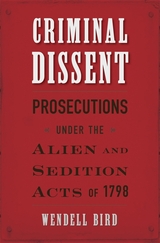 Criminal Dissent: Prosecutions under the Alien and Sedition Acts of 1798
Wendell Bird
Harvard University Press, 2019 In the first complete account of prosecutions under the Alien and Sedition Acts, dozens of previously unknown cases come to light, revealing the lengths to which the John Adams administration went in order to criminalize dissent.
The campaign to prosecute dissenting Americans under the Alien and Sedition Acts of 1798 ignited the first battle over the Bill of Rights. Fearing destructive criticism and “domestic treachery” by Republicans, the administration of John Adams led a determined effort to safeguard the young republic by suppressing the opposition.
The acts gave the president unlimited discretion to deport noncitizens and made it a crime to criticize the president, Congress, or the federal government. In this definitive account, Wendell Bird goes back to the original federal court records and the papers of Secretary of State Timothy Pickering and finds that the administration’s zeal was far greater than historians have recognized. Indeed, there were twice as many prosecutions and planned deportations as previously believed. The government went after local politicians, raisers of liberty poles, and even tavern drunks but most often targeted Republican newspaper editors, including Benjamin Franklin’s grandson. Those found guilty were sent to prison or fined and sometimes forced to sell their property to survive. The Federalists’ support of laws to prosecute political opponents and opposition newspapers ultimately contributed to the collapse of the party and left a large stain on their record.
The Alien and Sedition Acts launched a foundational debate on press freedom, freedom of speech, and the legitimacy of opposition politics. The result was widespread revulsion over the government’s attempt to deprive Americans of their hard-won liberties. Criminal Dissent is a potent reminder of just how fundamental those rights are to a stable democracy.
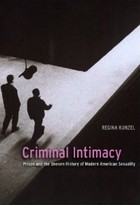 Criminal Intimacy: Prison and the Uneven History of Modern American Sexuality
Regina Kunzel
University of Chicago Press, 2008 Sex is usually assumed to be a closely guarded secret of prison life. But it has long been the subject of intense scrutiny by both prison administrators and reformers—as well as a source of fascination and anxiety for the American public. Historically, sex behind bars has evoked radically different responses from professionals and the public alike. In Criminal Intimacy, Regina Kunzel tracks these varying interpretations and reveals their foundational influence on modern thinking about sexuality and identity. Historians have held the fusion of sexual desire and identity to be the defining marker of sexual modernity, but sex behind bars, often involving otherwise heterosexual prisoners, calls those assumptions into question. By exploring the sexual lives of prisoners and the sexual culture of prisons over the past two centuries—along with the impact of a range of issues, including race, class, and gender; sexual violence; prisoners’ rights activism; and the HIV epidemic—Kunzel discovers a world whose surprising plurality and mutability reveals the fissures and fault lines beneath modern sexuality itself. Drawing on a wide range of sources, including physicians, psychiatrists, sociologists, correctional administrators, journalists, and prisoners themselves—as well as depictions of prison life in popular culture—Kunzel argues for the importance of the prison to the history of sexuality and for the centrality of ideas about sex and sexuality to the modern prison. In the process, she deepens and complicates our understanding of sexuality in America.
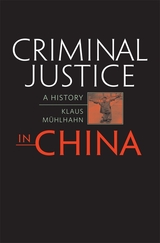 Criminal Justice in China: A History
Klaus Mühlhahn
Harvard University Press, 2009 In a groundbreaking work, Klaus Mühlhahn offers a comprehensive examination of the criminal justice system in modern China, an institution deeply rooted in politics, society, and culture.
In late imperial China, flogging, tattooing, torture, and servitude were routine punishments. Sentences, including executions, were generally carried out in public. After 1905, in a drive to build a strong state and curtail pressure from the West, Chinese officials initiated major legal reforms. Physical punishments were replaced by fines and imprisonment. Capital punishment, though removed from the public sphere, remained in force for the worst crimes. Trials no longer relied on confessions obtained through torture but were instead held in open court and based on evidence. Prison reform became the centerpiece of an ambitious social-improvement program.
After 1949, the Chinese communists developed their own definitions of criminality and new forms of punishment. People’s tribunals were convened before large crowds, which often participated in the proceedings. At the center of the socialist system was “reform through labor,” and thousands of camps administered prison sentences. Eventually, the communist leadership used the camps to detain anyone who offended against the new society, and the “crime” of counterrevolution was born.
Mühlhahn reveals the broad contours of criminal justice from late imperial China to the Deng reform era and details the underlying values, successes and failures, and ultimate human costs of the system. Based on unprecedented research in Chinese archives and incorporating prisoner testimonies, witness reports, and interviews, this book is essential reading for understanding modern China.
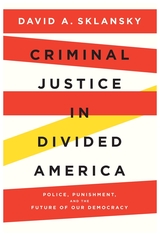 Criminal Justice in Divided America: Police, Punishment, and the Future of Our Democracy
David A. Sklansky
Harvard University Press, 2025 How a broken criminal justice system has fueled the crisis of American democracy, and how we can address both problems together.
American criminal justice is in crisis. Prisons are swollen, confidence in police has plummeted, and race- and class-based biases distort every aspect of the system. American democracy is in crisis, too, as the chasm of loathing and incomprehension that divides political factions grows ever wider and deeper. Legal scholar and former prosecutor David A. Sklansky argues that these crises are deeply intertwined. And if the failures of American criminal justice are near the heart of our political divides, then reforming the system is essential for repairing our democracy.
Criminal Justice in Divided America shows how police, courts, and prisons helped to break American democracy and how better approaches to public safety and criminal accountability can help to repair it. Engaging critically with concerns from both the left and the right, Sklansky lays out a clear and deeply researched agenda for reforming police departments, prosecutors’ offices, criminal trials, and punishment. Sklansky seeks pragmatic solutions that take account of political realities: the lofty ideal of empowering “the people” or “the community” can mean little when members of the public or the community disagree. While efforts to “defund” the police have exacerbated political conflicts without addressing the underlying problem of how and when force should be used to protect public safety, reforms aimed at improving police accountability, restraining prosecutorial power, and expanding the role of juries can bring together warring parties who share a concern for justice.
Ultimately, Sklansky argues, reform must be rooted in a strong commitment to pluralism—bridging political divides rather than worsening them, strengthening democracy, and securing the broad support that enables durable change.
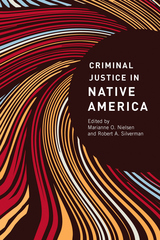 Criminal Justice in Native America
Edited by Marianne O. Nielsen and Robert A. Silverman
University of Arizona Press, 2009 Native Americans are disproportionately represented as offenders in the U.S. criminal justice system, particularly in the southwestern and north-central regions. However, until recently there was little investigation into the reasons for their over-representation. Furthermore, there has been little acknowledgment of the positive contributions of Native Americans to the criminal justice system—in rehabilitating offenders, aiding victims, and supporting service providers. This book offers a valuable and contemporary overview of how the American criminal justice system impacts Native Americans on both sides of the law.
Each of the fourteen chapters of Criminal Justice in Native America was commissioned specifically for this volume. Contributors—many of whom are Native Americans—rank among the top scholars in their fields. Some of the chapters treat broad subjects, including crime, police, courts, victimization, corrections, and jurisdiction. Others delve into more specific topics, including hate crimes against Native Americans, state-corporate crimes against Native Americans, tribal peacemaking, and cultural stresses of police officers. Separate chapters are devoted to women and juveniles.
The well-known scholar Marianne Nielsen provides a context-setting introduction, in which she addresses the history of the legal treatment of Native Americans in the United States as well as a provocative conclusion that details important issues for current and future research in Native American criminal justice studies. Intended to introduce students to the substantive concerns of a range of disciplines that contribute to Native American Studies—among them, criminal justice and criminology, law, sociology, and anthropology—Criminal Justice in Native America will interest all readers who are concerned about relationships between Native peoples and prevailing criminal justice systems.
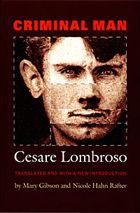 Criminal Man
Cesare Lombroso
Duke University Press, 2006 Cesare Lombroso is widely considered the founder of criminology. His theory of the “born” criminal dominated European and American thinking about the causes of criminal behavior during the late nineteenth century and the early twentieth. This volume offers English-language readers the first critical, scholarly translation of Lombroso’s Criminal Man, one of the most famous criminological treatises ever written. The text laid the groundwork for subsequent biological theories of crime, including contemporary genetic explanations. Originally published in 1876, Criminal Man went through five editions during Lombroso’s lifetime. In each edition Lombroso expanded on his ideas about innate criminality and refined his method for categorizing criminal behavior. In this new translation, Mary Gibson and Nicole Hahn Rafter bring together for the first time excerpts from all five editions in order to represent the development of Lombroso’s thought and his positivistic approach to understanding criminal behavior. In Criminal Man, Lombroso used modern Darwinian evolutionary theories to “prove” the inferiority of criminals to “honest” people, of women to men, and of blacks to whites, thereby reinforcing the prevailing politics of sexual and racial hierarchy. He was particularly interested in the physical attributes of criminals—the size of their skulls, the shape of their noses—but he also studied the criminals’ various forms of self-expression, such as letters, graffiti, drawings, and tattoos. This volume includes more than forty of Lombroso’s illustrations of the criminal body along with several photographs of his personal collection. Designed to be useful for scholars and to introduce students to Lombroso’s thought, the volume also includes an extensive introduction, notes, appendices, a glossary, and an index.
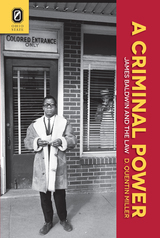 A Criminal Power: James Baldwin and the Law
D. Quentin Miller
Ohio State University Press, 2012 James Baldwin, one of the major African American writers of the twentieth century, has been the subject of a substantial body of literary criticism. As a prolific and experimental author with a marginal perspective—a black man during segregation and the Civil Rights era, a homosexual at a time when tolerance toward gays was not common—Baldwin has fascinated readers for over half a century. Yet Baldwin’s critics have tended to separate his weighty, complex body of work and to examine it piecemeal. A Criminal Power: James Baldwin and the Law is the first thematic study to analyze the complete scope of his work. It accomplishes this through an expansive definition and thorough analysis of the social force that oppressed Baldwin throughout his life: namely, the law. Baldwin, who died in 1987, attempted suicide in 1949 at the age of 25 after spending eight-days in a French prison following an absurd arrest for “receiving stolen goods”—a sheet that his acquaintance had taken from a hotel. This seemingly trite incident made Baldwin painfully aware of what he would later call the law’s “criminal power.” Up to now, the only book-length studies to address Baldwin’s entire career have been biographies and artistic “portraits.” D. Quentin Miller corrects this oversight in a comprehensive volume that addresses and unifies all of Baldwin’s work. Miller asserts that the Baldwin corpus is a testament to how the abuse of power within the American legal, judicial, and penal systems manifested itself in the twentieth century.
 The Criminal Process in the People's Republic of China, 1949-1963: An Introduction
Jerome Alan Cohen
Harvard University Press This volume represents the fruits of a preliminary inquiry into one aspect of contemporary Chinese law-the criminal process. Investigating what he calls China's "legal experiment," Mr. Cohen raises large questions about Chinese law. Is the Peoples Republic a lawless power, arbitrarily disrupting the lives of its people? Has it sought to attain Marx's vision of the ultimate withering away of the state and the law? Has Mao Zedong preferred Soviet practice to Marxist preaching? If so, has he followed Stalin or Stalin's heirs? To what extent has it been possible to transplant a foreign legal system into the world's oldest legal tradition? Has the system changed since 1949? What has been the direction of that change, and what are the prospects for the future?
Today, immense difficulties impede the study of any aspect of China's legal system. Most foreign scholars are forbidden to enter the country, and those who do visit China find solid data hard to come by. Much of the body of law is unpublished and available only to officialdom, and what is publicly available offers an incomplete, idealized, or outdated version of Chinese legal processes. Moreover, popular publications and legal journals that told much about the regime's first decade have become increasingly scarce and uninformative.
In order to obtain information for this study, Mr. Cohen spent 1963-64 in Hong Kong, interviewing refugees from the mainland and searching out and translating material on Chinese criminal law. From the interviews and published works, he has endeavored to piece together relevant data in order to see the system as a whole.
The first of the three parts of the book is an introductory essay, providing an overview of the evolution and operation of the criminal process from 1949 through 1963. The second part, constituting the bulk of the book, systematically presents primary source material, including excerpts from legal documents, policy statements, and articles in Chinese periodicals. In order to show the law in action as well as the law on the books, the author has included selections from written and oral accounts by persons who have lived in or visited the People's Republic. Interspersed among these diverse materials are Mr. Cohen's own comments, questions, and notes. Part III contains an English-Chinese glossary of the major institutional and legal terms translated in Part II, a bibliography of sources, and a list of English-language books and articles that are pertinent to an understanding of the criminal process in China.
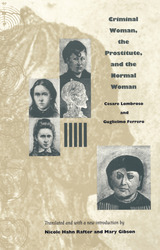 Criminal Woman, the Prostitute, and the Normal Woman
Cesare Lombroso and Guglielmo Ferrero
Duke University Press, 2004 Cesare Lombroso is widely considered the founder of the field of criminology. His theory of the “born” criminal dominated discussions of criminology in Europe and the Americas from the 1880s into the early twentieth century. His book, La donna delinquente, originally published in Italian in 1893, was the first and most influential book ever written on women and crime. This comprehensive new translation gives readers a full view of his landmark work. Lombroso’s research took him to police stations, prisons, and madhouses where he studied the tattoos, cranial capacities, and sexual behavior of criminals and prostitutes to establish a female criminal type. Criminal Woman, the Prostitute, and the Normal Woman anticipated today’s theories of genetic criminal behavior. Lombroso used Darwinian evolutionary science to argue that criminal women are far more cunning and dangerous than criminal men. Designed to make his original text accessible to students and scholars alike, this volume includes extensive notes, appendices, a glossary, and more than thirty of Lombroso’s own illustrations. Nicole Hahn Rafter and Mary Gibson’s introduction, locating his theory in social context, offers a significant new interpretation of Lombroso’s place in criminology.
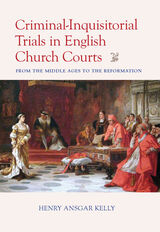 Criminal-Inquisitorial Trials in English Church Trials: From the Middle Ages to the Reformation
Henry Ansgar Kelly
Catholic University of America Press, 2023 After inquisitorial procedure was introduced at the Fourth Lateran Council in Rome in 1215 (the same year as England’s first Magna Carta), virtually all court trials initiated by bishops and their subordinates were inquisitions. That meant that accusers were no longer needed. Rather, the judges themselves leveled charges against persons when they were publicly suspected of specific offenses—like fornication, or witchcraft, or simony. Secret crimes were off limits, including sins of thought (like holding a heretical belief). Defendants were allowed full defenses if they denied charges. These canonical rules were systematically violated by heresy inquisitors in France and elsewhere, especially by forcing self-incrimination. But in England, due process was generally honored and the rights of defendants preserved, though with notable exceptions.
In this book, Henry Ansgar Kelly, a noted forensic historian, describes the reception and application of inquisition in England from the thirteenth century onwards and analyzes all levels of trial proceedings, both minor and major, from accusations of sexual offenses and cheating on tithes to matters of religious dissent. He covers the trials of the Knights Templar early in the fourteenth century and the prosecutions of followers of John Wyclif at the end of the century. He details how the alleged crimes of “criminous clerics” were handled, and demonstrates that the judicial actions concerning Henry VIII’s marriages were inquisitions in which the king himself and his queens were defendants. Trials of Alice Kyteler, Margery Kempe, Eleanor Cobham, and Anne Askew are explained, as are the unjust trials condemning Bishop Reginald Pecock of error and heresy (1457-59) and Richard Hunne for defending English Bibles (1514). He deals with the trials of Lutheran dissidents at the time of Thomas More’s chancellorship, and trials of bishops under Edward VI and Queen Mary, including those against Stephen Gardiner and Thomas Cranmer. Under Queen Elizabeth, Kelly shows, there was a return to the letter of papal canon law (which was not true of the papal curia). In his conclusion he responds to the strictures of Sir John Baker against inquisitorial procedure, and argues that it compares favorably to the common-law trial by jury.
Criminalisation and Advanced Marginality: Critically Exploring the Work of Loïc Wacquant
Edited by Peter Squires and John Lea
Bristol University Press, 2013 Loïc Wacquant’s writings have shaken the world of criminology—and social science more generally—to their foundations with a wide-ranging critique of neoliberal governance’s approach to crime and poverty and its reorientation of state power from welfare to discipline. The first book to fully engage with Wacquant’s work, Criminalisation and Advanced Marginality presents critical but constructive essays on his challenging ideas, focusing on the governance of crime and disorder, welfare, and “diswelfare.” It concludes with Wacquant’s responses to the authors’ comments and critiques.
 Criminality, Public Security, and the Challenge to Democracy in Latin America
Marcelo Bergman
University of Notre Dame Press, 2009
As new democratic regimes take root in Latin America, two of the most striking developments have been a dramatic rise in crime rates and increased perception of insecurity among its citizens. The contributors to this book offer a collective assessment of some of the causes for the alarming rise in criminal activity in the region. They also explore the institutional obstacles that states confront in the effort to curb criminality and build a fairer and more efficient criminal justice system; the connections between those obstacles and larger sociopolitical patterns; and the challenges that those patterns present for the consolidation of democracy in the region. The chapters offer both close studies of restricted regions in Latin America and broader examinations of the region as a whole.
The contributors to this volume are prominent scholars and specialists on the issue of citizen security. They draw on the latest methodologies and theoretical approaches to examine the question of how crime and crime fighting impact the consolidation of democracy and the rule of law in the region. These studies represent a major first step towards evaluating broadly a relative dearth of hard data about the Latin American security situation, as well as identifying future research paths. This book will be important for scholars, policy makers, and students, especially in the fields of Latin American and comparative law, political science, sociology, and criminology.
“The dramatic rise in reported criminality and citizen insecurity is one of the most often-mentioned yet least researched aspects of contemporary Latin America. This valuable compendium draws on recent empirical data, uneven and incomplete but nonetheless illuminating, as well as on comparative analysis, to discuss the sources and characteristics of crime in Latin America and its impact on democratization, the rule of law and institutional strength. The authors go beyond mere description and denunciation to develop better shared understanding of criminal activity and of how best to combat it. An important contribution.” —Abraham F. Lowenthal, Professor of International Relations, University of Southern California
“This is an important and timely collection of essays. For too long criminology has ignored the political dimension of crime and the implications of privatizing security. This collection, bringing together political scientists, sociologists and criminologists, addresses this critical nexus face-on and offers a coherent set of explanations for the rise of crime and the new forms of security that have emerged in Latin America.” —Federico Varese, Oxford University
“This volume is a solid contribution to the scholarship on crime, security, and democracy in Latin America. Although there are other collections that tackle these or similar issues, this volume offers, for the first time, a combined focus on crime, the police, prisons, and the criminal justice system. As such, it will be of tremendous significance to scholars and students interested in the analysis of crime and public security and their relevance to the challenges that Latin American democracies face.” —Carlos Aguirre, University of Oregon
 Criminalization of Women: Abortion, Inequity, and Resistance in Chile
Michele Eggers-Barison
University of Illinois Press, 2025 Until 2017, Chile’s abortion laws remained among the most draconian and restrictive in the world. The dozens of interviews that Michele Eggers-Barison conducted between 2011 and 2014 reveal how the criminalization of abortion and the construction of women as criminals went hand in hand--and both shaped and sustained structural, cultural, and direct forms of violence against women. Eggers-Barison uncovers the narratives of economically disadvantaged, Indigenous, and immigrant women who broke the Chilean law by terminating a pregnancy. Their stories reveal how laws and policies that regulate and control women’s reproductive lives also construct women as criminals. As Eggers-Barison shows, systems of inequality legitimize and sustain harmful attitudes and practices while creating concrete expressions of discrimination and other forms of violence against women. Their experience with abortion remains hidden within spaces of illegality and only becomes visible due to health or legal consequences. Yet despite the obstacles, women used individual and collective forms of group action to resist anti-abortion laws. Timely and vivid, Criminalization of Women shows how abortion’s illegality inscribes itself on a woman’s body and reality.
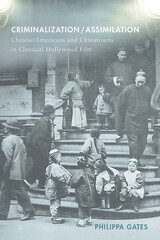 Criminalization/Assimilation: Chinese/Americans and Chinatowns in Classical Hollywood Film
Philippa Gates
Rutgers University Press, 2019 Criminalization/Assimilation traces how Classical Hollywood films constructed America’s image of Chinese Americans from their criminalization as unwanted immigrants to their eventual acceptance when assimilated citizens, exploiting both America’s yellow peril fears about Chinese immigration and its fascination with Chinatowns. Philippa Gates examines Hollywood’s responses to social issues in Chinatown communities, primarily immigration, racism, drug trafficking, and prostitution, as well as the impact of industry factors including the Production Code and star system on the treatment of those subjects. Looking at over 200 films, Gates reveals the variety of racial representations within American film in the first half of the twentieth century and brings to light not only lost and forgotten films but also the contributions of Asian American actors whose presence onscreen offered important alternatives to Hollywood’s yellowface fabrications of Chinese identity and a resistance to Hollywood’s Orientalist narratives.
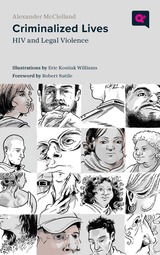 Criminalized Lives: HIV and Legal Violence
Alexander McClelland
Rutgers University Press, 2024 POZ Best in Literature Award
Canada has been known as a hot spot for HIV criminalization where the act of not disclosing one’s HIV-positive status to sex partners has historically been regarded as a serious criminal offence. Criminalized Lives describes how this approach has disproportionately harmed the poor, Black and Indigenous people, gay men, and women in Canada. In this book, people who have been criminally accused of not disclosing their HIV-positive status, detail the many complexities of disclosure, and the violence that results from being criminalized.
Accompanied by portraits from artist Eric Kostiuk Williams, the profiles examine whether the criminal legal system is really prepared to handle the nuances and ethical dilemmas faced everyday by people living with HIV. By offering personal stories of people who have faced criminalization first-hand, Alexander McClelland questions common assumptions about HIV, the role of punishment, and the violence that results from the criminal legal system’s legacy of categorizing people as either victims or perpetrators.
Note: A regrettable error appears on page 22. The number 240 should be 206 when referring to the number of people prosecuted in relation to allegations of HIV nondisclosure. This will be fixed in future reprints.
 The Criminally Insane: A Community Follow-up of Mentally Ill Offenders
Terence Thornberry and Joseph E. Jacoby
University of Chicago Press, 1979 The Criminally Insane is the largest scale in-depth follow-up study on mentally ill criminals yet to appear. This book challenges the assumption that inmates of maximum-security mental hospitals are extraordinarily violent and questions the necessity for maintaining maximum-security institutions which currently house some 15,000 persons in the United States.
In 1971, 586 patients were released from a Pennsylvania maximum-security hospital for the criminally insane. They were not considered officially "cured," but a federal court held that their commitments had been unconstitutional. Through exhaustive examination of hospital and police records and interviews with hospital administrators and the subjects themselves, Thornberry and Jacoby assess the processes by which the patients had been retained in confinement, the impact of their release upon their communities, and their ability to adjust to the freedom of community life.
The authors demonstrate that the patients did not display a significant level of violent behavior during confinement, nor did they pose a major threat to society after release. In fact, their social and psychological adjustment to community life is shown to have been comparable to that of non-criminal mental patients. Yet despite these findings the subjects had been retained in maximum-security confinement for an average of fourteen years because they were predicted to be violent and "dangerous" to society. The authors explain this inaccuracy by a process called "political prediction," in which clinicians avoid any potential risks to the community, the reputation of their hospitals, and their careers by consistently overpredicting dangerous behavior.
The Criminally Insane will stimulate response from professionals in a wide variety of fields, including law, criminology, psychiatry, and sociology, and from anyone concerned with society's responsibility to the mentally ill offender.
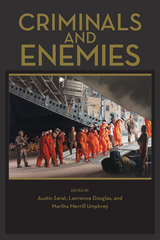 Criminals and Enemies
Austin Sarat
University of Massachusetts Press, 2019 Key binaries like public/private and speech/conduct are mainstays of the liberal legal system. However, the pairing of criminal/enemy has received little scholarly attention by comparison. Bringing together a group of distinguished and disciplinarily diverse scholars, Criminals and Enemies, the most recent volume in the Amherst Series in Law, Jurisprudence, and Social Thought, addresses this gap in the literature. Drawing on political philosophy, legal analysis, and historical research, this essential volume reveals just how central the criminal/enemy distinction is to the structure and practice of contemporary law.
The editors' introduction situates criminals and enemies in a theoretical context, focusing on the work of Thomas Hobbes and Carl Schmitt, while other essays consider topics ranging from Germany's denazification project to South Africa's pre- and post-apartheid legal regime to the complicating factors introduced by the war on terror. In addition to the editors, the contributors include Stephen Clingman, Jennifer Daskal, Sara Kendall, Devin Pendas, and Annette Weinke.
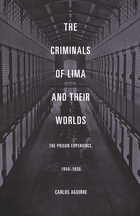 The Criminals of Lima and Their Worlds: The Prison Experience, 1850-1935
Carlos Aguirre
Duke University Press, 2005 The Criminals of Lima and Their Worlds is the first major historical study of the creation and development of the prison system in Peru. Carlos Aguirre examines the evolution of prisons for male criminals in Lima from the conception—in the early 1850s—of the initial plans to build penitentiaries through the early-twentieth-century prison reforms undertaken as part of President Augusto Leguia’s attempts to modernize and expand the Peruvian state. Aguirre reconstructs the social, cultural, and doctrinal influences that determined how lawbreakers were treated, how programs of prison reform fared, and how inmates experienced incarceration. He argues that the Peruvian prisons were primarily used not to combat crime or to rehabilitate allegedly deviant individuals, but rather to help reproduce and maintain an essentially unjust social order. In this sense, he finds that the prison system embodied the contradictory and exclusionary nature of modernization in Peru. Drawing on a large collection of prison and administrative records archived at Peru’s Ministry of Justice, Aguirre offers a detailed account of the daily lives of men incarcerated in Lima’s jails. In showing the extent to which the prisoners actively sought to influence prison life, he reveals the dynamic between prisoners and guards as a process of negotiation, accommodation, and resistance. He describes how police and the Peruvian state defined criminality and how their efforts to base a prison system on the latest scientific theories—imported from Europe and the United States—foundered on the shoals of financial constraints, administrative incompetence, corruption, and widespread public indifference. Locating his findings within the political and social mores of Lima society, Aguirre reflects on the connections between punishment, modernization, and authoritarian traditions in Peru.
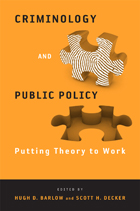 Criminology and Public Policy: Putting Theory to Work
Hugh Barlow
Temple University Press, 2009 Crime policy ought to be guided by science rather than ideology, argue Hugh Barlow and Scott Decker in this incisive and original collection of essays. Establishing the value and importance of linking theory and practice, the contributors to Criminology and Public Policy provide a comprehensive treatment of the major theories in criminology and their implications for criminal justice, crime control, and the larger realm of justice.
In applying theories to real world issues—such as reducing crime and violence, prisoner reentry policies, gang behavior, and treatment courts—the contributors take both a macro and micro level approach. They find, too, that it is often difficult to turn theory into practice. Still, the very attempt pushes the criminal justice system toward workable solutions rather than ideological approaches, an orientation the editors believe will lead to greater progress in combating one of our society’s greatest difficulties.
Contributors include: Robert Agnew, Ronald L. Akers, Gordon Bazemore, Ronald V. Clarke, J. Heith Copes, Frank Cullen, Marcus Felson, Marie Griffin, Scott Jacques, David Kauzlarich, Jean McGloin, Steven Messner, Alex Piquero, Nicole Leeper Piquero, Nancy Rodriguez, Richard B. Rosenfeld, Dawn Rothe, Andrea Schoepfer, Neal Shover, Cassia Spohn, Katherine Tellis, Charles Tittle, Richard Wright, and the editors.
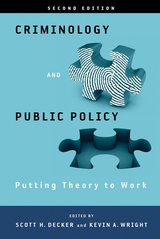 Criminology and Public Policy: Putting Theory to Work
Scott H. Decker and Kevin A. Wright
Temple University Press, 2018 In the field of criminal justice, public policy is designed to address the problems brought on by criminal behavior and the response to that behavior. However, too often, the theories carefully developed in the academy fail to make their way into programs and policy. The editors and contributors to this second edition of Criminology and Public Policy highlight the recent development of “translational criminology” to address the growing movement in criminology to use the results of criminological research and theory to better inform policy and practice. The essays in Criminology and Public Policy propose an in-depth look at both theory and practice and how they are integrated across a number of key criminal justice problems—from racial and environmental concerns to gun control and recidivism rates as well as police use of force and mass incarceration. The end result is an essential volume that blends both theory and practice in an effort to address the critical problems in explaining, preventing, responding to, and correcting criminal behavior. Contributors include: Robert K. Ax, Michelle N. Block, Anthony A. Braga, Rod K. Brunson, Jennifer Carlson, Ronald V. Clarke, Shea Cronin, Megan Denver, Kevin M. Drakulich, Grant Duwe, Amy Farrell, Cheryl Jonson, Charis E. Kubrin, Justin Kurland, Megan Kurlychek, Shannon Magnuson, Daniel P. Mears, Robert D. Morgan, Kathleen Powell, Danielle Rudes, Cassia Spohn, Cody Telep, Natalie Todak, Glenn Trager, Jillian J. Turanovic, Sara Wakefield, Patricia Warren, David Weisburd, Michael D. White, Rob White, Lauren Wilson and the editors
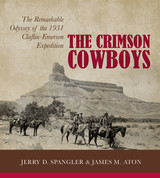 The Crimson Cowboys: The Remarkable Odyssey of the 1931 Claflin-Emerson Expedition
Jerry D. Spangler and James M. Aton
University of Utah Press, 2018 Winner of the Don D. and Catherine S. Fowler Prize. In 1931 a group from Harvard University’s Peabody Museum accomplished something that had never been attempted in the history of American archaeology: a six-week, four-hundred-mile horseback survey of Fremont prehistoric sites through some of the West’s most rugged terrain. The expedition was successful, but a report on the findings was never completed. What should have been one of the great archaeological stories in American history was relegated to boxes and files in the basement of the Peabody Museum at Harvard. Now, based on over a thousand pages of documents (field journals, correspondence, and receipts) and over four hundred photographs, this book recounts the remarkable day-to-day adventures of this crew of one professor, five students, and three Utah guides who braved heat, fatigue, and the dangerous canyon wilderness to reveal vestiges of the Fremont culture in the Tavaputs Plateau and Uinta Basin areas. To better tell this story, authors Spangler and Aton undertook extensive fieldwork to confirm the sites; their recent photographs and those of the original expedition are shared on these pages. This engaging narrative situates the 1931 survey and its discoveries within the history of American archaeology. Click here for a podcast with the APEX hour and Jim Aton about The Crimson Cowboys.
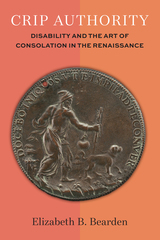 Crip Authority: Disability and the Art of Consolation in the Renaissance
Elizabeth B. Bearden
University of Michigan Press, 2025 Crip Authority explores how Renaissance writers and artists with disabilities drew on consolatory literature to enhance their authority and create a sense of disability community across the centuries. Elizabeth B. Bearden considers how Renaissance writers and artists understood their lived experiences of disability by drawing on the ancient genre of consolation, which aims to comfort people for a variety of hardships, including mental and physical disability. Renaissance writers used the art of consolation to resignify the mental and physical disabilities that their society frequently scorned into an expression of their military, spiritual, political, and most importantly for this study, writerly authority. Bearden names this kind of defiant authorial self-representation crip authority, thereby transgressively cripping our society’s ableist notions of who has the ability and authority to write.
Disabled authors include Francesco Petrarca, Teresa de Cartagena, Giovani Paolo Lomazzo, Miguel de Cervantes Saavedra, Robert Burton, and John Milton. They all explore their experiences of disability, but their work has rarely or never been considered from a disability studies perspective. Bearden thus brings today’s models of disability studies and crip theory together with early modern articulations of disability based on ancient and Renaissance models of military, political, biblical, and literary authority. In sum, Crip Authority makes a significant contribution to the growing field of early modern disability studies and invites us to rethink the extent of crip history and the endurance of disability gain.
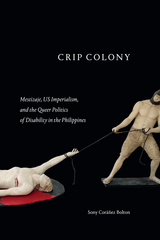 Crip Colony: Mestizaje, US Imperialism, and the Queer Politics of Disability in the Philippines
Sony Coráñez Bolton
Duke University Press, 2023 In Crip Colony, Sony Coráñez Bolton examines the racial politics of disability, mestizaje, and sexuality in the Philippines. Drawing on literature, poetry, colonial records, political essays, travel narratives, and visual culture, Coráñez Bolton traces how disability politics colluded with notions of Philippine mestizaje. He demonstrates that Filipino mestizo writers in the late nineteenth and early twentieth centuries used mestizaje as a racial ideology of ability that marked Indigenous inhabitants of the Philippines as lacking in civilization and in need of uplift and rehabilitation. Heteronormative, able-bodied, and able-minded mixed-race Filipinos offered a model and path for assimilation into the US empire. In this way, mestizaje allowed for supposedly superior mixed-race subjects to govern the archipelago in collusion with American imperialism. By bringing disability studies together with studies of colonialism and queer-of-color critique, Coráñez Bolton extends theorizations of mestizaje beyond the United States and Latin America while considering how Filipinx and Filipinx American thought fundamentally enhances understandings of the colonial body and the racial histories of disability.
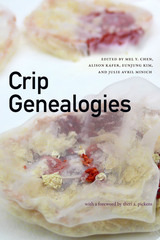 Crip Genealogies
Mel Y. Chen, Alison Kafer, Eunjung Kim, and Julie A. Minich, editors
Duke University Press, 2023 The contributors to Crip Genealogies reorient the field of disability studies by centering the work of transnational feminism, queer of color critique, and trans scholarship and activism. They challenge the white, Western, and Northern rights-based genealogy of disability studies, showing how a single coherent narrative of the field is a mode of exclusion that relies on logics of whiteness and imperialism. The contributors examine how disability justice activists work in concert with other social justice projects, explore crip environments, create alternate disciplinary genealogies, and reject notions of the model minority. Throughout, they demonstrate how the mandate for a single genealogy of the discipline whitewashes disability and continues forms of violence. By cripping disability studies, the contributors allow for divergent histories, the coexistence of anti-ableist and antiracist theorizing, and a radically just and capacious understanding of disability.
Contributors. Suzanne Bost, Mel Y. Chen, Sony Coráñez Bolton, Natalia Duong, Lezlie Frye, Magda García, Alison Kafer, Eunjung Kim, Yoo-suk Kim, Kateřina Kolářová, James Kyung-Jin Lee, Stacey Park Milbern, Julie Avril Minich, Tari Young-Jung Na, Therí A. Pickens, Leah Lakshmi Piepzna-Samarasinha, Jasbir K. Puar, Sami Schalk, Faith Njahîra Wangarî
 The Crip Linguistics Reader
Octavian Robinson
Gallaudet University Press, 2025 How you language is who you are; language shapes your identity, relationships, and experiences. The Crip Linguistics Reader is a wide-ranging and groundbreaking collection that challenges normative ideas about what is considered “good language.” This volume draws on the expertise of contributors across a variety of fields in the humanities, social sciences, and the arts; these writers bring an interdisciplinary and critical disability perspective to languaging by challenging dominant paradigms in linguistic inquiry. Essays include a wide range of topics, such as examining the relationship between disability and race in the context of language, investigating the compulsory nature of specific forms of language education, elucidating forms of linguistic care, and exploring the transmission of ableist ideologies about language. An essential read for scholars and educators, this collection showcases Crip Linguistics as an analytical framework that will transform ideological boundaries of language and communication along with our understanding of what languaging can be.
 Crip Love Onscreen: Representations of Love, Sex, and Disability
Sarah Rainey-Smithback
Ohio State University Press, 2026 Crip Love Onscreen: Representations of Love, Sex, and Disability examines how disabled people’s sexual lives—including pleasure/sex, love, pregnancy, and sexual violence—are represented in popular film and television. Analyzing a variety of films and TV shows from the United States, Canada, and the United Kingdom, Crip Love Onscreen establishes a pattern in disability representation that ignores or distorts many of the realities of crip sexuality. These patterns of sexual representation tend to uphold compulsory able-bodiedness, heteronormativity, and privacy norms—what Rainey-Smithback terms “neoliberal love values,” or standards that celebrate normative forms of sexual desire, bodies, and intimacy practices.
As disability representation increases, though, new possibilities are emerging. Crip Love Onscreen also draws attention to the exceptional through a close reading of cinematic narratives (such as Me Before You,50 First Dates,The Little Mermaid,Juno, and more) that push against neoliberal, heteronormative, and ableist values. Drawing on the work of queer/crip scholars and activists, Rainey-Smithback uncovers glimpses of what Tobin Siebers calls a “sexual culture for disabled people”—a space and way of being that expands sexual access and sexual experience.
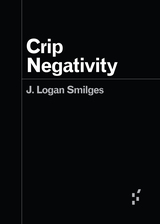 Crip Negativity
J. Logan Smilges
University of Minnesota Press, 2023 Imagining anti-ableist liberation beyond the rubrics of access and inclusion
In the thirty years since the Americans with Disabilities Act was signed into law, the lives of disabled people have not improved nearly as much as activists and politicians had hoped. In Crip Negativity, J. Logan Smilges shows us what’s gone wrong and what we can do to fix it. Leveling a strong critique of the category of disability and liberal disability politics, Smilges asks and imagines what horizons might exist for the liberation of those oppressed by ableism—beyond access and inclusion. Inspired by models of negativity in queer studies, Black studies, and crip theory, Smilges proposes that bad crip feelings might help all of us to care gently for one another, even as we demand more from the world than we currently believe to be possible.
Forerunners: Ideas First is a thought-in-process series of breakthrough digital publications. Written between fresh ideas and finished books, Forerunners draws on scholarly work initiated in notable blogs, social media, conference plenaries, journal articles, and the synergy of academic exchange. This is gray literature publishing: where intense thinking, change, and speculation take place in scholarship.
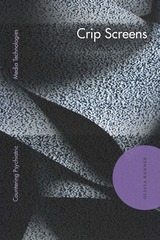 Crip Screens: Countering Psychiatric Media Technologies
Olivia Banner
Duke University Press, 2025 In Crip Screens, Olivia Banner provides a wide-ranging and ongoing history of Black, feminist-of-color, and crip resistance to psychiatry’s incorporation of hegemonic media technologies into treatment and research. Banner shows how institutions use documentary films, data visualization, network graphs, therapy chatbots, virtual patient training programs, and pharmaceutical advertising to pathologize certain people as “deviant” and “mentally ill.” Those people so categorized have used media technologies toward alternative visions of care. Examining insurgent media and technology efforts in the 1960s and 1970s, Banner shows how women and communities of color worked to wrest away from psychiatry its hold over representing mental distress and pathological categorization. These efforts and innovations, she argues, were distinct from what is now accepted as the antipsychiatry movement. In so doing, Banner recovers a lost history of disability politics—what she calls crip screens—that refused psychiatry’s use of cultural productions toward its carceral and subjugating designs.
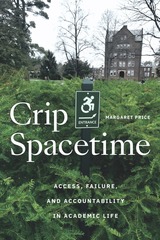 Crip Spacetime: Access, Failure, and Accountability in Academic Life
Margaret Price
Duke University Press, 2024 In Crip Spacetime, Margaret Price intervenes in the competitive, productivity-focused realm of academia by sharing the everyday experiences of disabled academics. Drawing on more than three hundred interviews and survey responses, Price demonstrates that individual accommodations—the primary way universities address accessibility—actually impede access rather than enhance it. She argues that the pains and injustices encountered by academia’s disabled workers result in their living and working in realities different from nondisabled colleagues: a unique experience of space, time, and being that Price theorizes as “crip spacetime.” She explores how disability factors into the exclusionary practices found in universities, with multiply marginalized academics facing the greatest harms. Highlighting the knowledge that disabled academics already possess about how to achieve sustainable forms of access, Price boldly calls for the university to move away from individualized models of accommodation and toward a new system of collective accountability and care.
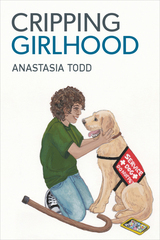 Cripping Girlhood
Anastasia Todd
University of Michigan Press, 2024 Cripping Girlhood offers a new theorization of disabled girlhood, tracing how and why representations of disabled girls emerge with frequency in twenty-first century U.S. media culture. It uncovers how the exceptional figure of the disabled girl most often appears as a resource to work through post-Americans with Disabilities Act (ADA) anxieties about the family, healthcare, labor, citizenship, and the precarity of the bodymind. In paying critical attention to disabled girlhood, the book uses feminist disability studies to rupture the unwitting assumption in girls’ studies that girlhood is necessarily non-disabled.
By closely examining the ways that disabled girls represent themselves, Anastasia Todd goes beyond a critique of the figure of the privileged, disabled girl subject in the national imagination to explore how disabled girls circulate their own capacious re-envisioning of what it means to be a disabled girl. In analyzing a range of cultural sites, including YouTube, TikTok, documentaries, and GoFundMe campaigns, Todd shows how disabled girls actively upend what we think we know about them and their experience, recasting the meanings ascribed to their bodyminds in their own terms. By analyzing disabled girls’ self-representational practices and cultural productions, Todd shows how disabled girls deftly theorize their experiences of ableism, sexism, racism, and ageism, and cultivate communities online, creating archives of disability knowledge and politicizing other disabled people in the process.
Cripping Labor-Based Grading for More Equity in Literacy Courses
Asao B. Inoue
University Press of Colorado, 2024 Writing in response to recent work by Kathleen Kryger, Griffin X. Zimmerman, and Ellen C. Carillo, Asao B. Inoue offers an expanded and compassionate discussion of labor-based grading, a practice that involves negotiating a set of classroom agreements with all of the students in a course to determine how much labor will be expected of students and how it will be accounted for or identified to earn particular final course grades. Inoue focuses his exploration of labor-based grading by asking, “How can labor-based grading evolve so that it addresses the concerns around inequitable access to or expectations of labor that students with disabilities, neurodivergencies, illnesses, or limited time in the semester may face?” The result is a thoughtful re-examination and re-thinking of labor-based grading in writing courses.
 Cripping the Archive: Disability, History, and Power
Edited by Jenifer L. Barclay and Stefanie Hunt-Kennedy Foreword by Jaipreet Virdi
University of Illinois Press, 2025 How do we explain the conspicuous absence of disability from the histories we write? What forces and factors create this dynamic? How can disability be everywhere and nowhere, present and absent, and obvious and overlooked in both the historical record and historians’ interpretations of the past? Jenifer L. Barclay and Stefanie Hunt-Kennedy edit a collection of interdisciplinary essays that consider how and why physical, sensory, intellectual, and psychological disabilities are underrepresented, erased, or distorted in the historical record. The contributors draw on the methodology and practice of cripping to uncover disability in contested archives and explore ways to build inclusive archives accountable to, and centered on, disabled people and disability justice. Throughout, they show ableness informing the politics of the archive as a physical space, a discriminatory record, and a collection of silences. An essential contribution to research methods and disability justice, Cripping the Archive offers a blueprint for intersectional and interdisciplinary approaches that bridge disability studies, history, and archival studies.
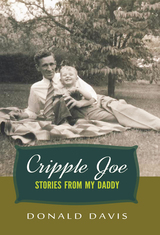 Cripple Joe: Stories from my Daddy
Donald Davis
Parkhurst Brothers, Inc., 2016 Donald Davis was a young United Methodist minister when the telephone rang one morning. "It's your daddy," the caller said, "Mama just couldn't get him awake this morning. He is gone."
"A million questions about him began to line themselves up in my mind." Davis writes. "Where did he go to high school? I did not know." Did he get any education behind that? What were his early jobs, and where did he live then? I was now only twenty-eight, my father was dead, and I had been to young and immature to know to ask t=for the stories that would have filled out his life for me."
The surprise of a lifetime came when he called home and his recently departed father picked up the phone: "Hello! This is Joe Davis. What can I do for you today?"
That case of mistaken identity changed Donald Davis's outlook on the value of family and the need for story gathering. In the twenty-two years until his father's second death, he rarely let an opportunity pass to collect and cherish the stories of his life.
Cripple Joe is the happy result.
Davis tells how his father and an African-American hospital orderly quietly broke down racial barriers in their small mountain town.
He tells how his father employed his humane brand of justice on an eager young chemist whose experiments veered into manufacturing gunpowder, on sons who nearly burned a barn, and on teenagers who organized a disastrous coed camping trip.
And best of all, he tells how Joe Davis--a man known as "Banker Joe" for his work in the loan department but to a select few as "Cripple Joe"--turned a gruesome accident into an opportunity that broadened his world and that of his son.
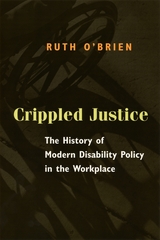 Crippled Justice: The History of Modern Disability Policy in the Workplace
Ruth O'Brien
University of Chicago Press, 2001 Crippled Justice, the first comprehensive intellectual history of disability policy in the workplace from World War II to the present, explains why American employers and judges, despite the Americans with Disabilities Act, have been so resistant to accommodating the disabled in the workplace. Ruth O'Brien traces the origins of this resistance to the postwar disability policies inspired by physicians and psychoanalysts that were based on the notion that disabled people should accommodate society rather than having society accommodate them.
O'Brien shows how the remnants of postwar cultural values bogged down the rights-oriented policy in the 1970s and how they continue to permeate judicial interpretations of provisions under the Americans with Disabilities Act. In effect, O'Brien argues, these decisions have created a lose/lose situation for the very people the act was meant to protect. Covering developments up to the present, Crippled Justice is an eye-opening story of government officials and influential experts, and how our legislative and judicial institutions have responded to them.
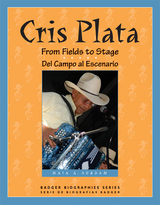 Cris Plata: From Fields to Stage // Del Campo al Escenario
Maia Surdam
Wisconsin Historical Society Press, 2014 Raised among Mexican American farmworkers, singer-songwriter Cris Plata spoke Spanish, ate Mexican food, and heard Mexican music played by family and friends. He also spoke English, went to school with mostly white children for at least half the year, and grew more familiar with mainstream American culture. Until he was seven, he and his family lived and worked on a ranch near Poteet, Texas. The family became migrant farmworkers, moving from Indiana to Arkansas and Florida before finally settling in Wisconsin in 1966 to work at an Astico farm.
This dual language book shares the Plata’s family story of migrant farming, music, and family amid the constant change and uncertainty of migrant life. While hardships—from poor working conditions and low wages to racial prejudice—were constant in Cris Plata’s upbringing, so too was the music that bonded and uplifted his family. After long days in the fields, Cris’s family spent their small amount of free time playing and singing songs from Mexico and South Texas. Cris learned to play the guitar, accordion, and mandolin, beginning to strum when he was just five years old. Today, he writes his own music, performs songs in English and Spanish, and records albums with his band, Cris Plata with Extra Hot.
Following Cris Plata’s journey from farm fields to musical stages, the story explores how a migrant, and the son of an immigrant, decided to make Wisconsin his home.
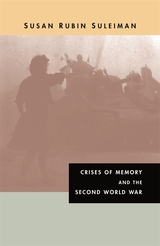 Crises of Memory and the Second World War
Susan Rubin Suleiman
Harvard University Press, 2006 How we view ourselves and how we wish to be seen by others cannot be separated from the stories we tell about our past. In this sense all memory is in crisis, torn between conflicting motives of historical reflection, political expediency, and personal or collective imagination. In Crises of Memory and the Second World War, Susan Suleiman conducts a profound exploration of contested terrain, where individual memories converge with public remembrance of traumatic events.
Suleiman is one of a handful of scholars who have shaped the interdisciplinary study of memory, with its related concepts of trauma, testimony, forgetting, and forgiveness. In this book she argues that memories of World War II, while nationally specific, transcend national boundaries, due not only to the global nature of the war but also to the increasingly global presence of the Holocaust as a site of collective memory. Among the works she discusses are Jean-Paul Sartre’s essays on the occupation and Resistance in France; Marcel Ophuls’ innovative documentary on Klaus Barbie, tried for crimes against humanity; István Szabó’s film Sunshine, a chronicle of Jewish identity in central Europe; literary memoirs by Jorge Semprun and Elie Wiesel; and experimental writing by child survivors of the Holocaust.
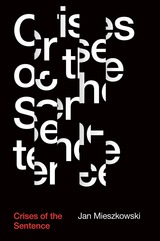 Crises of the Sentence
Jan Mieszkowski
University of Chicago Press, 2019 There are few forms in which so much authority has been invested with so little reflection as the sentence. Though a fundamental unit of discourse, it has rarely been an explicit object of inquiry, often taking a back seat to concepts such as the word, trope, line, or stanza.
To understand what is at stake in thinking—or not thinking—about the sentence, Jan Mieszkowski looks at the difficulties confronting nineteenth- and twentieth-century authors when they try to explain what a sentence is and what it can do. From Romantic debates about the power of the stand-alone sentence, to the realist obsession with precision and revision, to modernist experiments with ungovernable forms, Mieszkowski explores the hidden allegiances behind our ever-changing stylistic ideals. By showing how an investment in superior writing has always been an ethical and a political as well as an aesthetic commitment, Crises of the Sentence offers a new perspective on our love-hate relationship with this fundamental compositional category.
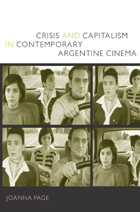 Crisis and Capitalism in Contemporary Argentine Cinema
Joanna Page
Duke University Press, 2009 There has been a significant surge in recent Argentine cinema, with an explosion in the number of films made in the country since the mid-1990s. Many of these productions have been highly acclaimed by critics in Argentina and elsewhere. What makes this boom all the more extraordinary is its coinciding with a period of severe economic crisis and civil unrest in the nation. Offering the first in-depth English-language study of Argentine fiction films of the late twentieth century and early twenty-first, Joanna Page explains how these productions have registered Argentina’s experience of capitalism, neoliberalism, and economic crisis. In different ways, the films selected for discussion testify to the social consequences of growing unemployment, rising crime, marginalization, and the expansion of the informal economy. Page focuses particularly on films associated with New Argentine Cinema, but she also discusses highly experimental films and genre movies that borrow from the conventions of crime thrillers, Westerns, and film noir. She analyzes films that have received wide international recognition alongside others that have rarely been shown outside Argentina. What unites all the films she examines is their attention to shifts in subjectivity provoked by political or economic conditions and events. Page emphasizes the paradoxes arising from the circulation of Argentine films within the same global economy they so often critique, and she argues that while Argentine cinema has been intent on narrating the collapse of the nation-state, it has also contributed to the nation’s reconstruction. She brings the films into dialogue with a broader range of issues in contemporary film criticism, including the role of national and transnational film studies, theories of subjectivity and spectatorship, and the relationship between private and public spheres.
Crisis and Control: Institutional Change in Financial Market Regulation
Edited by Renate Mayntz
Campus Verlag, 2012 In reaction to the international financial crisis of 2007, a network of social scientists from seven countries analyzed the various changes in the regulation of financial markets, and this book presents their results. The articles published herein show patterns of institutional change that were triggered by the economic crisis on different political levels, of their implementation and effectiveness, as well as their results. An indispensible tool for political scientists, Crisis and Control contributes significantly to the theory of institutional change.
 Crisis and Control: The Militarization of Protest Policing
Lesley J. Wood
Pluto Press, 2014 Crisis and Control explains how neoliberal transformations of political and economic systems are militarising the policing of protest, based on a compelling empirical study of police agencies and practices from 1995 until the present.
Lesley J. Wood shows that the increasing role of the security and defense industries, professional police associations, anti-terrorism initiatives and ‘best practices’ in policing networks have accelerated the use of less lethal weapons, pre-emptive arrests, infiltration and barricading strategies against protesters.
The book uses Bourdieu and Boltanski to analyse court transcripts, police reports, policy, training materials and the conference programs of professional police organisations to argue that police agencies are neither omnipotent strategists, nor simple tools of the elite, but institutions struggling to maintain legitimacy, resources and autonomy in a changing field.
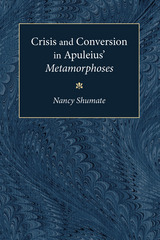 Crisis and Conversion in Apuleius' Metamorphoses
Nancy Shumate
University of Michigan Press, 1996 Apuleius' wonderful Latin novel Metamorphoses, written in the second century C.E., was for a long time neglected. In recent years some have attempted to understand the Metamorphoses by applying contemporary critical theory to the work, without notable success. In Crisis and Conversion in Apuleius' "Metamorphoses" Nancy Shumate takes a new and profitable approach: she uses an epistemologically oriented model of religious conversion to study the experiences of the novel's central character, Lucius, who is turned into an ass and back again.
Shumate draws on a wide range of literary and nonliterary representations of conversion in order to establish a useful theoretical framework. The Metamorphoses is exposed as a text anticipating later narratives in its concern with world-building, with the narrator's subjective reality, and with the invocation and critique of religious experience.
Crisis and Conversion in Apuleius' "Metamorphoses" will be of interest to classicists and scholars of Silver Latin and of the increasingly popular ancient novel, as well as to students of psychology and the sociology of religious experience.
Nancy Shumate is Associate Professor of Classical Languages and Literatures, Smith College.
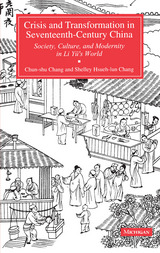 Crisis and Transformation in Seventeenth-Century China: Society, Culture, and Modernity in Li Yu's World
Chun-shu Chang and Shelley Hsueh-lun Chang
University of Michigan Press, 1998 The seventeenth century was a time of great social and political upheaval in China. In Crisis and Transformation in Seventeenth-Century China, Chun-shu Chang and Shelley Hsueh-lun Chang offer a detailed and engaging analysis of society, culture, and the state in China during this critical period.
The main thread of the book follows the life and works of a remarkable figure of the period, Li Yü (1611-80), whose vast array of accomplishments and experiences mirror seventeenth-century China in all its complexity and excitement. Li Yü's China was a world of unprecedented changes in almost all spheres of life. A thriving commercial and industrial economy, stupendous population growth, and the emergence of a new age of science and technology were accompanied by intense urbanization, radical views on money, wealth, and luxury, liberal attitudes toward sexuality, and developments that would change the nature of the literary and intellectual world. The Changs' exhaustive exploration of Chinese historical and literary sources of the sixteenth and seventeenth centuries is combined with a selective application of interpretive insights and analytic techniques from the major theoretical schools.
An important resource for scholars in history, literature, and Asian studies, Crisis and Transformation extends its appeal to those interested in the history of science, issues of gender and social transformation, and popular culture movements.
Chun-shu Chang is Professor of History, University of Michigan, and Honorary Professor of Chinese History, China. Shelley Hsueh-lun Chang is Visiting Associate Professor of History and Research Associate, Center for Chinese Studies, University of Michigan.
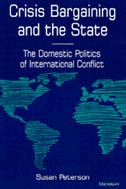 Crisis Bargaining and the State: The Domestic Politics of International Conflict
Susan Peterson
University of Michigan Press, 1996 The first book to systematically explore the importance of domestic institutions to crisis bargaining, Crisis Bargaining and the State argues that the influence of a state's bargaining behavior on its opponents foreign policy depends on the nature of the opposing government--its institutional structures and the strategic beliefs of its leaders. The author shows in three detailed case studies--the Crimean War crisis, the Fashoda crisis, and the Berlin crisis--the significance of domestic factors to questions of war and peace.
Peterson offers a comprehensive analysis of the domestic politics of crisis bargaining. She uses differences in state structure to explain variations in foreign policy processes and outcomes. By introducing domestic structure as a crucial intervening variable between the international environment and a state's foreign policy during an acute conflict, Peterson shows how existing cognitive and bureaucratic approaches provide complementary, not competing, explanations of crisis bargaining.
Crisis Bargaining and the State: The Domestic Politics of International Conflict applies recent research in the field of international political economy on the relationship between ideas, institutions, and the international environment to the issue of crisis bargaining. It will appeal to students, scholars, and policymakers interested in crisis bargaining, international security, and international relations.
Susan Peterson is Assistant Professor, Department of Government, The College of William & Mary.
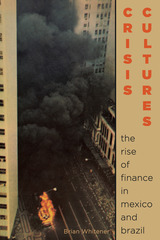 Crisis Cultures: The Rise of Finance in Mexico and Brazil
Brian Whitener
University of Pittsburgh Press, 2019
Drawing on a mix of political, economic, literary, and filmic texts, Crisis Cultures challenges current cultural histories of the neoliberal period by arguing that financialization, and not just neoliberalism, has been at the center of the dramatic transformations in Latin American societies in the last thirty years. Starting from political economic figures such as crisis, hyperinflation, credit, and circulation and exemplary cultural texts, Whitener traces the interactions between culture, finance, surplus populations, and racialized state violence after 1982 in Mexico and Brazil. Crisis Cultures makes sense of the emergence of new forms of exploitation and terrifying police and militarized violence by tracking the cultural and discursive forms, including real abstraction and the favela and immaterial cadavers and voided collectivities, that have emerged in the complicated aftermath of the long downturn and global turn to finance.
 Crisis for Whom?: Critical Global Perspectives on Childhood, Care, and Migration
Edited by Rachel Rosen, Elaine Chase, Sarah Crafter, Valentina Glockner, and Sayani Mitra
University College London, 2023 A complex and nuanced interdisciplinary exploration of children in migration crises.
Children are central figures in narratives of “migration crises.” They are often depicted as either essentially vulnerable and in need of special protections, or suspiciously adult-like and a threat to national borders. This bilingual book, written in English and Spanish, challenges these simplistic narratives. Drawing on collaborations between young migrants, researchers, artists, and activists, this collection asks new questions about how crises are produced, mobility is controlled, and childhood is conceptualized. Answers to these questions have profound implications for resources, infrastructures, and relationships of care. The chapters offer insights from diverse global contexts, painting a rich and insightful tapestry about child migration. They stress that children are more than recipients of care and that the crises they face are multiple and stratifying, with long historical roots. Readers are invited to understand migration as an act of concern and love and to attend to how the solidarities between citizens and “others,” adults and children, and between children, are understood and forged.
The Crisis Imperative: Crisis Rhetoric and Welfare State Reform in Belgium and the Netherlands in the Early 1990s
Sanneke Kuipers
Amsterdam University Press, 2006 Belgium and the Netherlands were perfect examples of the “welfare without work” policy that characterized European welfare states — until a political crisis in both countries during the early 1990s produced a surprising divergence in administration. While Belgium’s government announced major reforms, its social security policy remained relatively resilient. In the Netherlands, however, policymakers implemented unprecedented cutbacks as well as a major overhaul of the disability benefits program. The Crisis Imperative explains this difference as the result of crisis rhetoric—that is, the deliberate construction of a crisis as the imperative for change. It will be a valuable resource for policymakers, researchers, and anyone interested in welfare reform in the United States and abroad.
Crisis In Bethlehem
John Strohmeyer
University of Pittsburgh Press, 1994 Pulitzer Prize winner John Strohmeyer’s account of the collapse of Bethlehem Steel. As editor of the Bethlehem, Pennsylvania, Globe-Times from 1956 to 1984, Strohmeyer followed the steel industry from the height of its power through its decline. He evaluates the self-indulgence of both the unions and industry management and movingly describes the human agony caused by the failure of steel. His account is reinforced by over one hundred interviews with steelworkers, union leaders, steel executives, and industry analysts. First issued in 1986, the book is more significant than ever. In this edition, Strohmeyer includes an update on steel today.
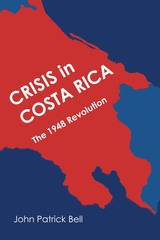 Crisis in Costa Rica: The 1948 Revolution
By John Patrick Bell
University of Texas Press, 1971 The Costa Rican revolution of 1948 capped an extended period of social tension and political unrest. This book analyzes the circumstances of 1940–1948 that led to a successful armed uprising. A secondary and related theme is the role of José Figueres Ferrer in marshaling disparate groups into a movement sufficiently cohesive to seize and hold power. In the 1940s the Communists, the Social Democrats (forerunners of the National Liberation Party), and the followers of Rafael Angel Calderón Guardia within the traditional National Republican party competed to lead the middle sector’s demand for modernization. Most accounts of this period have presented the Calderón regime as aristocratic or oligarchic in nature, yet as linked to an international Communist movement. John Patrick Bell, supporting his argument with considerable detail and documentation from newspapers and private papers, argues that Calderón came to depend upon his alliance with the Communist-oriented Vanguardia Popular to counteract the defection of the right wing of the National Republican party and that the sources of the Vanguardia Popular were basically indigenous. The calderonistas’ comprehensive program for social and economic reform had elicited strong conservative reaction, and this opposition was ready to push the charge of communism against Calderón. Costa Rica thus entered a period of violent political confrontation that culminated in the electoral victory of the conservative candidate, Otilio Ulate Blanco, in February 1948. When the calderonista majority in Congress annulled the election, José Figueres Ferrer launched a successful uprising purportedly to force ratification of Ulate’s election. In reality, however, Figueres had been planning a revolt for nearly six years to redirect modernization along social democratic lines. Figueres and his group, seeking even more radical reforms than the calderonistas, were able to use the opposition movement to their advantage, simply because they were prepared, even with force, when the right moment arrived. The National Liberation Movement, led to power by Figueres, dominated the national political development of Costa Rica for decades afterward. Eschewing a strictly chronological framework, Bell has utilized a topical structure that facilitates a full description of shifts in foreign policy in the United States and Latin America that affected the outcome of the struggle in Costa Rica.
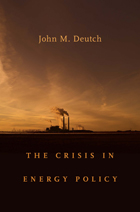 The Crisis in Energy Policy
John M. Deutch
Harvard University Press, 2011 Our future depends on what we do about energy. This stark fact, clear since the oil embargo of the 1970s, has been hammered home through crisis after crisis—and yet our government has failed to come up with a coherent energy policy. John Deutch, with his extraordinary mix of technical, scholarly, corporate, and governmental expertise in the realm of energy, is uniquely qualified to explain what has stood in the way of progress on this most pressing issue. His book is at once an eye-opening history of the muddled practices that have passed for energy policy over the past thirty years, and a cogent account of what we can and should learn from so many breakdowns of strategy and execution.
Three goals drive any comprehensive energy policy: develop an effective approach to climate change; transition from fossil fuels to renewable energy technologies; and increase the efficiency of energy use to reduce dependence on imported oil. Why has every effort in this direction eventually fallen short? Deutch identifies the sources of this failure in our popular but unrealistic goals, our competing domestic and international agendas, and our poor analysis in planning, policy-making, and administering government programs. Most significantly, The Crisis in Energy Policy clarifies the need to link domestic and global considerations, as well as the critical importance of integrating technical, economic, and political factors. Written for experts and citizens alike, this book will strengthen the hand of anyone concerned about the future of energy policy.
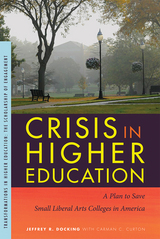 Crisis in Higher Education: A Plan to Save Small Liberal Arts Colleges in America
Jeffrey R. Docking
Michigan State University Press, 2014 In 2005 Adrian College was home to 840 enrolled students and had a tuition income of $8.54 million. By fall of 2011, enrollment had soared to 1,688, and tuition income had increased to $20.45 million. For the first time in years, the small liberal arts college was financially viable. Adrian College experienced this remarkable growth during the worst American economy in seventy years and in a state ravaged by the decline of the big three auto companies. How, exactly, did this turnaround happen? Crisis in Higher Education: A Plan to Save Small Liberal Arts Colleges in America was written to facilitate replication and generalization of Adrian College’s tremendous enrollment growth and retention success since 2005. This book directly addresses the economic competitiveness of small four-year institutions of higher education and presents an evidence-based solution to the enrollment and economic crises faced by many small liberal arts colleges throughout the country.
 Crisis in Korea: America, China and the Risk of War
Tim Beal
Pluto Press, 2011 The South Korean warship Cheonan was sunk in mysterious circumstances on 26 March 2010. The remarkable events that followed are analysed by Tim Beal and woven into a larger study of the increasingly volatile relations between North and South Korea and US concern about the rise of China.
South Korea's stance towards the North has hardened significantly since the new conservative government came to power. Beal argues that the South moved quickly to use the sinking of the Cheonan to put international pressure on the North, even before the cause of the sinking had been established. The US followed suit by attempting to pressurise China into condemning North Korea. The media reports at the time presented an open and shut case of unprovoked North Korean aggression, but the evidence points towards the accidental triggering of a South Korean mine as the cause and South Korean fabrication to incriminate the North.
With the South bent on forcing the fall of the North's regime with US help and China unlikely to stand idly by, this book offers an essential guide to the key factors behind the crisis and possible solutions.
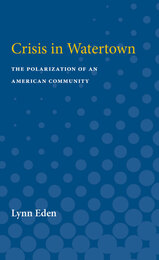 Crisis in Watertown: The Polarization of an American Community
Lynn Eden
University of Michigan Press, 1972 On May 19, 1968, the minister of the Congregational Church of Watertown, Wisconsin, was fired.Alan Kromholz was 29 when he came to Watertown with his wife and two small boys. Kromholz began his ministerial duties in February 1967, seven months before Father James Groppi began marching in Milwaukee.In the middle of September Watertown's city attorney received a model fair housing ordinance from the state, with a recommendation that it be adopted. Thus the polarization began. It was sharpened by the publication of an underground newspaper and the establishment of a coffee house, by feelings that Kromholz was neglecting his pastoral duties and providing a subversive example for the young, by rumors of a black invasion.On May 19, 1968, Reverend Kromholz was fired. Visiting Watertown two years later, Lynn Eden captured the voices of protest and approval —voices that you have heard in your own town, in your own neighborhood, in yourself. The result is Crisis in Watertown: a true and remarkable document of our times.
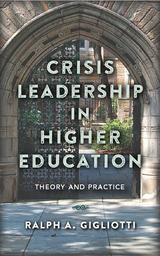 Crisis Leadership in Higher Education: Theory and Practice
Ralph A. Gigliotti
Rutgers University Press, 2020 There was a time when crises on college and university campuses were relatively rare. Much has changed, and it has changed quite rapidly. Rather than being isolated incidents requiring the sole attention of presidents, chancellors, or communication professionals, the proliferation of crises across campuses means that crisis leadership has now become fundamental to the work of university personnel across levels, disciplines, and institutions. Drawing upon the findings of forty interviews with senior leaders from ten major research universities across the United States and a content analysis of over one thousand articles from a variety of news outlets, Crisis Leadership in Higher Education presents a theory-informed framework for academic and administrative leaders who must navigate the institutional and environmental crises that are most germane to institutions of higher education. The perspectives offered in this book remind us that it is in the chaos and uncertainty of crisis that leadership becomes most visible and most critical.
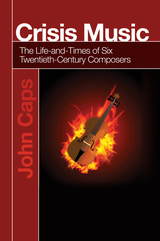 Crisis Music: The Life-and-Times of Six Twentieth-Century Composers
John Caps
Sussex Academic Press, 2022 Story-like chapters profile six twentieth-century "reactive" composers; not the most famous pillars of the period but lesser-known, perhaps more approachable, characters whose stories span that 19002000 period from decadent fin-de-sicle Vienna (Alban Berg, Alexander Zemlinsky) to war-torn Paris (Olivier Messiaen, Arthur Honegger) to the Cold War tensions of East vs. West (Toru Takemitsu) and late-century Communism (Arvo Part). Their stories were all very different crises, and they produced very different kinds of music; each very "telling" of their composer's life and times. Crisis Music; presents each brief biography almost like a detective story looking for motives, then spotlights one particular piece of music from each composer that emerged directly out of hard times—maybe a political crisis at the time of composition (Hitler marching into Paris or later Communist crack-downs); or some personal angst such as illness or scandal—and how that music contains and expresses crisis. In short, the subject for discussion is how context influences content. Such troubled and especially vivid composition, "crisis music" can often be most compelling and meaningful for its composer and for its time. Indeed, their music also seems to have a special resonance to share with our own crisis-prone times. And meanwhile, Western music history played-out its own story from late-romantic style to Serialism and Minimalism to the anything-goes Pluralism we hear today. Crisis Music; sparks the discussion about how history, biography, and music intersects. At the behest of music teachers at secondary and tertiary levels, Crisis Music ;contains substantive Discussion Questions geared for classroom use.
 The Crisis of Capitalist Democracy
Richard A. Posner
Harvard University Press, 2010 Following his timely and well-received A Failure of Capitalism, Richard Posner steps back to take a longer view of the continuing crisis of democratic capitalism as the American and world economies crawl gradually back from the depths to which they had fallen in the autumn of 2008 and the winter of 2009.
By means of a lucid narrative of the crisis and a series of analytical chapters pinpointing critical issues of economic collapse and gradual recovery, Posner helps non-technical readers understand business-cycle and financial economics, and financial and governmental institutions, practices, and transactions, while maintaining a neutrality impossible for persons professionally committed to one theory or another. He calls for fresh thinking about the business cycle that would build on the original ideas of Keynes. Central to these ideas is that of uncertainty as opposed to risk. Risk can be quantified and measured. Uncertainty cannot, and in this lies the inherent instability of a capitalist economy.
As we emerge from the financial earthquake, a deficit aftershock rumbles. It is in reference to that potential aftershock, as well as to the government’s stumbling efforts at financial regulatory reform, that Posner raises the question of the adequacy of our democratic institutions to the economic challenges heightened by the greatest economic crisis since the Great Depression. The crisis and the government’s energetic response to it have enormously increased the national debt at the same time that structural defects in the American political system may make it impossible to pay down the debt by any means other than inflation or devaluation.
The Crisis of Care: Affirming and Restoring Caring Practices in the Helping Professions
Susan S. Phillips and Patricia Benner, Editors
Georgetown University Press By combining stories of care, the reflections of caregiving practitioners, and interpretations of caregiving within a larger social and theoretical framework, this collection identifies the values and skills involved in quality caregiving at the individual level and affirms their importance for reshaping our public caregiving institutions. Contributors from the fields of medicine, nursing, teaching, ministry, sociology, psychotherapy, theology, and philosophy articulate their values, hopes, commitments, and practices both in theoretical essays and in narratives of caregiving that reveal the complexities of skillful practice.
Crisis of Conscience: Arkansas Methodists and the Civil Rights Struggle
James T. Clemons
Butler Center for Arkansas Studies, 2007 Crisis of Conscience features personal stories by Arkansas Methodist pastors, laypersons, and community leaders—including Dale Bumpers, M. Joycelyn Elders, and Miller Williams—who lived through the struggles for civil rights in the 1950s and saw their congregations and other institutions rocked by the tumultuous events of the history-making era. The book also depicts the desegregation of Hendrix College, the prophetic role of Philander Smith College in civil rights activism, and the experiences of other Arkansas Methodist institutions in the great freedom struggle that caused many of the state’s church members to realize they could no longer reconcile their belief in God with participation in a segregated society.
Crisis of European Sciences and Transcendental Phenomenology
Edmund Husserl
Northwestern University Press, 1970 The Crisis of European Sciences and Transcendental Phenomenology, Husserl's last great work, is important both for its content and for the influence it has had on other philosophers. In this book, which remained unfinished at his death, Husserl attempts to forge a union between phenomenology and existentialism.
Husserl provides not only a history of philosophy but a philosophy of history. As he says in Part I, "The genuine spiritual struggles of European humanity as such take the form of struggles between the philosophies, that is, between the skeptical philosophies--or nonphilosophies, which retain the word but not the task—and the actual and still vital philosophies. But the vitality of the latter consists in the fact that they are struggling for their true and genuine meaning and thus for the meaning of a genuine humanity."
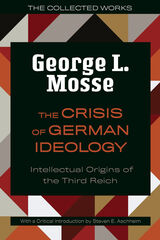 The Crisis of German Ideology: Intellectual Origins of the Third Reich
George L. Mosse
University of Wisconsin Press, 2021 This new edition revisits the renowned historian George L. Mosse’s landmark work exploring the ideological foundations of Nazism in Germany. First published in 1964, this volume was among the first to examine the intellectual origins of the Third Reich. Mosse introduced readers to what is known as the völkisch ideal—the belief that the German people were united through a transcendental essence. This mindset led to the exclusion of Jews and other groups, eventually allowing Nazi leaders to take their beliefs to catastrophic extremes. The critical introduction by Steven E. Aschheim, the author of Beyond the Border: The German-Jewish Legacy Abroad and many other books, brings Mosse’s work into the present moment.
George L. Mosse (1918–99) was a legendary scholar, teacher, and mentor. A refugee from Nazi Germany, in 1955 he joined the Department of History at the University of Wisconsin–Madison, where he was both influential and popular. Mosse was an early leader in the study of modern European cultural and intellectual history, fascism, and the history of sexuality and masculinity. Over his career he authored more than two dozen books.
 The Crisis of Masculinity in the Age of Augustus
Melanie Racette-Campbell
University of Wisconsin Press, 2023 The political rupture caused by the ascension of Augustus Caesar in ancient Rome, which ended the centuries-old Republic, had drastic consequences for the performance and understanding of masculinity in a markedly androcentric society. Previously, masculinity was established and maintained through the frame of competition, in both public and private spheres—but the total accumulation of power by one man foreclosed most avenues of, and even appreciation for, competition. Melanie Racette-Campbell examines how Rome’s elite men navigated this liminal moment between Republic and Empire and shows that the process was neither linear nor uniform.
Careful reading of contemporary texts reveals a decades-long process as tumultuous and unsteady as the political events they echoed, one in which multiple and competing strategies for reconceiving the nature of masculinity were tested, employed, discarded, and adopted in a complex public-private discourse. The eventual reconstitution of a definition of Roman manhood was not easily agreed upon. Masculinity in both the Republic and the Empire are well-studied subjects, but by shining a light on the precise moment of transition Racette-Campbell unveils the complexity, contours, and nuances of the Augustan crisis of masculinity.
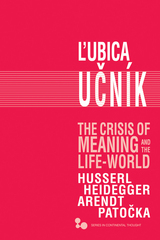 The Crisis of Meaning and the Life-World: Husserl, Heidegger, Arendt, Patocka
Lubica Ucník
Ohio University Press, 2016 In The Crisis of Meaning and the Life-World, Ľubica Učník examines the existential conflict that formed the focus of Edmund Husserl’s final work, which she argues is very much with us today: how to reconcile scientific rationality with the meaning of human existence. To investigate this conundrum, she places Husserl in dialogue with three of his most important successors: Martin Heidegger, Hannah Arendt, and Jan Patočka. For Husserl, 1930s Europe was characterized by a growing irrationalism that threatened to undermine its legacy of rational inquiry. Technological advancement in the sciences, Husserl argued, had led science to forget its own foundations in the primary “life-world”: the world of lived experience. Renewing Husserl’s concerns in today’s context, Učník first provides an original and compelling reading of his oeuvre through the lens of the formalization of the sciences, then traces the unfolding of this problem through the work of Heidegger, Arendt, and Patočka. Although many scholars have written on Arendt, none until now has connected her philosophical thought with that of Czech phenomenologist Jan Patočka. Učník provides invaluable access to the work of the latter, who remains understudied in the English language. She shows that together, these four thinkers offer new challenges to the way we approach key issues confronting us today, providing us with ways to reconsider truth, freedom, and human responsibility in the face of the postmodern critique of metanarratives and a growing philosophical interest in new forms of materialism.
 The Crisis of Meaning: In Culture and Education
David Trend
University of Minnesota Press, 1995
The Crisis of Meaning was first published in 1995. Minnesota Archive Editions uses digital technology to make long-unavailable books once again accessible, and are published unaltered from the original University of Minnesota Press editions.
Pick up any newspaper and it is clear that the United States is facing a democratic crisis. Recent culture wars and debates about political correctness and culture have illustrated how conventional definitions of citizenship and national identity have been thrown into question.
Investigating what he views as an inseparable link between culture and politics, David Trend analyzes how notions of patriotism, citizenship, community, and family are communicated within specific public and private institutions. He extends the meaning and purpose of pedagogy as a cultural practice outside the classroom, focusing on political activism in education, the mass media, and the art world.
The Crisis of Meaning supplies a crucial theoretical understanding of the ways in which the pedagogical and political intersect at a variety of cultural sites, as it points us toward a "democratic" process of national identity formation. It is indispensable reading for anyone interested in the connections between education and politics.
David Trend is executive director of the Center for Social Research and Education in San Francisco and also executive editor of the Socialist Review. He is the author of Cultural Pedagogy: Art/Education/Politics (1992).
 The Crisis of Modern Times: Perspectives from The Review of Politics, 1939-1962
A. James McAdams
University of Notre Dame Press, 2007
In the 1940s and 1950s The Review of Politics, under the dynamic leadership of Waldemar Gurian, emerged as one of the leading journals of political and social theory in the United States. This volume celebrates that legacy by bringing together classic essays by a remarkable group of American and European émigré intellectuals, among them Jacques Maritain, Hannah Arendt, Josef Pieper, Eric Voegelin, and Yves Simon. For these writers, the emergence of new dictatorial regimes in Germany and Russia and the looming threat of another, even more devastating, European war demanded that one rethink the reigning philosophical perspectives of the time. In their view, the western world had lost sight of its founding principles. Individually and collectively, they maintained that the West could be saved only if its leaders embraced the idea that society should be governed by moral standards and a commitment to human dignity.
Since the first issue appeared in 1939, The Review of Politics has influenced generations of political theorists. To complement these essays A. James McAdams has written an introduction that discusses the history of the journal and reflects on the contributions of these influential figures. He underscores the continuing relevance of these essays in assessing contemporary issues.
“The essays contained in this volume demonstrate why the Review of Politics is a national treasure. From Jacques Maritain and Yves Simon to Hannah Arendt and Leo Strauss, it has consistently attracted writers of the highest quality to think about the deepest problems of politics and the twentieth century. The themes covered in this collection range from totalitarianism and nihilism to the value of education and the dignity of the individual. Their probity and intelligence show why the Review of Politics has remained the premier journal for serious students of political philosophy.” —Steven B. Smith, Alfred Cowles Professor of Political Science, Yale University
“The Review of Politics has been essential reading for students of political philosophy and politics for more than two generations, including among its contributors internationally renowned scholars whose works are both enormously influential and increasingly look to be contemporary expressions of perennial wisdom. To make seminal essays of this remarkable journal easily accessible, with more to come in future volumes, is a great service to students of political science at every level.” —Timothy Fuller, Lloyd E. Worner Distinguished Service Professor, Colorado College
 The Crisis of Neoliberalism
Gérard Duménil and Dominique Lévy
Harvard University Press, 2013 This book examines “the great contraction” of 2007–2010 within the context of the neoliberal globalization that began in the early 1980s. This new phase of capitalism greatly enriched the top 5 percent of Americans, including capitalists and financial managers, but at a significant cost to the country as a whole. Declining domestic investment in manufacturing, unsustainable household debt, rising dependence on imports and financing, and the growth of a fragile and unwieldy global financial structure threaten the strength of the dollar. Unless these trends are reversed, the authors predict, the U.S. economy will face sharp decline.Summarizing a large amount of troubling data, the authors show that manufacturing has declined from 40 percent of GDP to under 10 percent in thirty years. Since consumption drives the American economy and since manufactured goods comprise the largest share of consumer purchases, clearly we will not be able to sustain the accumulating trade deficits.Rather than blame individuals, such as Greenspan or Bernanke, the authors focus on larger forces. Repairing the breach in our economy will require limits on free trade and the free international movement of capital; policies aimed at improving education, research, and infrastructure; reindustrialization; and the taxation of higher incomes.
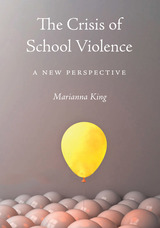 The Crisis of School Violence: A New Perspective
Marianna King
Michigan State University Press, 2020 The Crisis of School Violence is the only interdisciplinary book about school violence. It presents a broad and in-depth approach to the key questions about why bullying continues at an unprecedentedly high rate and why rampage school shootings continue to shock the nation. Based on extensive research, The Crisis of School Violence investigates human nature and its relation to aggressive behavior, with a special focus on the culture of violence that predicates school violence (including rampage shootings) and perpetuates industries that profit from violence. Marianna King presents the considerable psychological and neuroscientific research that investigates the effects of violent entertainment media on the brain and, subsequently, on behavior, which clearly reveals a causal connection between exposure to violent electronic entertainment media—especially violent video games—and increased aggressive and violent behavior. The book also reveals a more specific connection between exposure to violent video games and rampage school shootings. Ultimately this volume is a call to action that includes recommendations for parents, teachers, decision makers, and citizens alike.
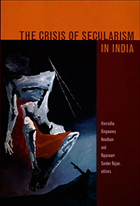 The Crisis of Secularism in India
Anuradha Dingwaney Needham and Rajeswari Sunder Rajan, eds.
Duke University Press, 2007 While secularism has been integral to India’s democracy for more than fifty years, its uses and limits are now being debated anew. Signs of a crisis in the relations between state, society, and religion include the violence directed against Muslims in Gujarat in 2002 and the precarious situation of India’s minority religious groups more generally; the existence of personal laws that vary by religious community; the affiliation of political parties with fundamentalist religious organizations; and the rallying of a significant proportion of the diasporic Hindu community behind a resurgent nationalist Hinduism. There is a broad consensus that a crisis of secularism exists, but whether the state can resolve conflicts and ease tensions or is itself part of the problem is a matter of vigorous political and intellectual debate. In this timely, nuanced collection, twenty leading Indian cultural theorists assess the contradictory ideals, policies, and practices of secularism in India. Scholars of history, anthropology, religion, politics, law, philosophy, and media studies take on a broad range of concerns. Some consider the history of secularism in India; others explore theoretical issues such as the relationship between secularism and democracy or the shortcomings of the categories “majority” and “minority.” Contributors examine how the debates about secularism play out in schools, the media, and the popular cinema. And they address two of the most politically charged sites of crisis: personal law and the right to practice and encourage religious conversion. Together the essays inject insightful analysis into the fraught controversy about the shortcomings and uncertain future of secularism in the world today. Contributors. Flavia Agnes, Upendra Baxi, Shyam Benegal, Akeel Bilgrami, Partha Chatterjee, V. Geetha, Sunil Khilnani, Nivedita Menon, Ashis Nandy, Anuradha Dingwaney Needham, Gyanendra Pandey, Gyan Prakash, Arvind Rajagopal, Paula Richman, Sumit Sarkar, Dwaipayan Sen, Rajeswari Sunder Rajan, Shabnum Tejani, Romila Thapar, Ravi S. Vasudevan, Gauri Viswanathan
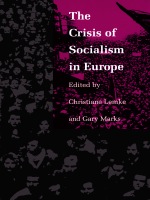 The Crisis of Socialism in Europe
Christiane Lemke and Gary Marks, eds.
Duke University Press, 1991 The revolutions in Eastern Europe and the recasting of socialism in Western Europe since 1989 have given rise to intense debate over the origins, character, and implications of the “crisis” of socialism. Is socialism in ideological, electoral, or organizational decline? Is the decline inevitable or can socialism be revitalized? This volume draws together historians and political scientists of Eastern and Western European politics to address these questions. The collection begins with an historical overview of socialism in Western Europe and moves toward the suggestion of a framework for a post-socialist discourse. Among the topics covered are: the birth and death of communism and a regime type in Eastern Europe; how different forms of national communism were smothered by Sovietization in the postwar period; the origins of revolutions in Eastern Europe; the potential for social democracy in Hungary; the role of the Left in a reunified German; and directions for the Left in general. Contributors. Geoff Eley, Konrad Jarausch, Herbert Kitschelt, Christiane Lemke, Andrei Markovits, Gary Marks, Wolfgang Merkel, Norman Naimark, Iván and Szonja Szelénya, Sharon Wolchik
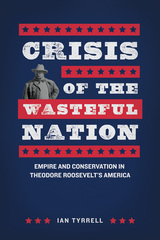 Crisis of the Wasteful Nation: Empire and Conservation in Theodore Roosevelt's America
Ian Tyrrell
University of Chicago Press, 2014 Long before people were “going green” and toting reusable bags, the Progressive generation of the early 1900s was calling for the conservation of resources, sustainable foresting practices, and restrictions on hunting. Industrial commodities such as wood, water, soil, coal, and oil, as well as improvements in human health and the protection of “nature” in an aesthetic sense, were collectively seen for the first time as central to the country’s economic well-being, moral integrity, and international power. One of the key drivers in the rise of the conservation movement was Theodore Roosevelt, who, even as he slaughtered animals as a hunter, fought to protect the country’s natural resources.
In Crisis of the Wasteful Nation, Ian Tyrrell gives us a cohesive picture of Roosevelt’s engagement with the natural world along with a compelling portrait of how Americans used, wasted, and worried about natural resources in a time of burgeoning empire. Countering traditional narratives that cast conservation as a purely domestic issue, Tyrrell shows that the movement had global significance, playing a key role in domestic security and in defining American interests around the world. Tyrrell goes beyond Roosevelt to encompass other conservation advocates and policy makers, particularly those engaged with shaping the nation’s economic and social policies—policies built on an understanding of the importance of crucial natural resources. Crisis of the Wasteful Nation is a sweeping transnational work that blends environmental, economic, and imperial history into a cohesive tale of America’s fraught relationships with raw materials, other countries, and the animal kingdom.
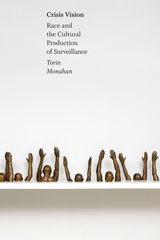 Crisis Vision: Race and the Cultural Production of Surveillance
Tom Monahan
Duke University Press, 2022 In Crisis Vision, Torin Monahan explores how artists confront the racializing dimensions of contemporary surveillance. He focuses on artists ranging from Kai Wiedenhöfer, Paolo Cirio, and Hank Willis Thomas to Claudia Rankine and Dread Scott, who engage with what he calls crisis vision—the regimes of racializing surveillance that position black and brown bodies as targets for police and state violence. Many artists, Monahan contends, remain invested in frameworks that privilege transparency, universality, and individual responsibility in ways that often occlude racial difference. Other artists, however, disrupt crisis vision by confronting white supremacy and destabilizing hierarchies through the performance of opacity. Whether fostering a recognition of a shared responsibility and complicity for the violence of crisis vision or critiquing how vulnerable groups are constructed and treated globally, these artists emphasize ethical relations between strangers and ask viewers to question their own place within unjust social orders.
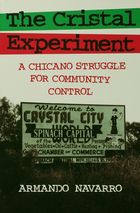 The Cristal Experiment: A Chicano Struggle for Community Control
Armando Navarro
University of Wisconsin Press, 1998 Amidst the turbulence and militancy of the 1960s and early 1970s, the Mexicano population of the dusty agricultural town of Crystal City, Texas (Cristal in Spanish), staged two electoral revolts, each time winning control of the city council and school board. The landmark city council victory in 1963 was a first for Mexican Americans in South Texas, and Cristal—the “spinach capital of the world”—became for a time the political capital of the Chicano Movement.
In The Cristal Experiment, Armando Navarro presents the most comprehensive examination to date of the rise of the Chicano political movement in Cristal, its successes and conflicts (both internal and external), and its eventual decline. He looks particularly at the larger and more successful “Second Revolt” in 1970 and its aftermath up to 1981, examining the political, economic, educational, and social changes for Mexicanos that resulted. Drawing upon nearly 100 interviews, a wealth of secondary materials, and his own experiences as a political organizer in the Chicano Movement, Navarro offers a shrewd and insightful analysis not only of the events in Cristal, but also of the workings of local politics generally, the politics of community control, and the factors inherent in the American political system that lead to the self-destruction of political movements. As both a political scientist and an organizer, he outlines important lessons to be learned from what happened in Cristal and to the Chicano Movement.
Cristi Puiu
Monica Filimon
University of Illinois Press, 2017 Cristi Puiu's black comedy The Death of Mr. Lazarescu announced the arrival of the New Romanian Cinema as a force on the film world stage. As critics and festival audiences embraced the new movement, Puiu emerged as its lodestar and critical voice. Monica Filimon explores the works of an artist dedicated to truth not as an abstract concept, but as the ephemeral revelation of the fuller, ungraspable world beyond the screen. Puiu's innovative use of the handheld camera as an observer and his reliance on austere, restricted narration highlight the very limits of human understanding, guiding the viewer's intellectual and emotional sensibilities to the reality that has been left unfilmed. Filimon examines the director's ethics of epiphany not only in relation to the collective and personal histories that have triggered it, but also in dialogue with the films, texts, and filmmakers that have shaped it.
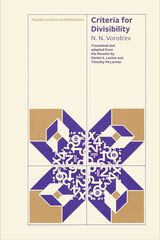 Criteria for Divisibility
N. N. Vorob'ev
University of Chicago Press, 1980 N. N. Vorob'ev's Criteria for Divisibility introduces the high school or early college student to a specific number-theoretic topic and explains the general mathematical structures which underlie the particular concepts discussed. Vorob'ev discusses the ideas of well-ordered sets, partial and linear orderings, equivalence relations, equivalence classes, algorithms, and the relationship between the determinability of algorithms defined on the integers and the well-ordering principle.
All this is done comprehensively with the help of a unique plan for study which encourages the student to skip large sections of the book on first reading and return to them later. The more general and conceptually challenging material appears in small print, so that the student must have a good grasp of the number-theoretic concepts on which the generalizations are based before making the step to generalization. The booklet provides both specific knowledge in a particular field of mathematical investigation and a fine basis on which to continue studies in mathematics.
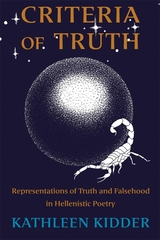 Criteria of Truth: Representations of Truth and Falsehood in Hellenistic Poetry
Kathleen Kidder
Harvard University Press, 2023 Amidst conflicting information and personal experiences, how can someone distinguish between truth and falsehood? Criteria of Truth: Representations of Truth and Falsehood in Hellenistic Poetry tackles this fundamental question through a study of five Hellenistic poems dated to the third and second centuries BCE: Aratus’s Phaenomena, Nicander’s Theriaca, Callimachus’s Aetia, Apollonius of Rhodes’s Argonautica, and Lycophron’s Alexandra.
Situating these poetic works in their intellectual and literary milieu, Kathleen Kidder applies the philosophic concept of the criterion of truth, arguing that each poetic persona represents a different criterion for interrogating truth and falsehood. Moreover, by analyzing the poems’ allusions, myths, and poetic language, Kidder demonstrates how this poetry can encapsulate the tensions not only between truth and falsehood, but also between order and chaos, certainty and doubt, clarity and obscurity, seen and unseen, and being and seeming.
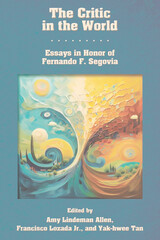 The Critic in the World: Essays in Honor of Fernando F. Segovia
Amy Lindeman Allen
SBL Press, 2024 A Pact of Love with Criticism, A Pact of Blood with the World
Building on the legacy of Fernando F. Segovia, the pioneering essays in this volume redefine the intersection of biblical studies and geopolitics. Through a thorough exploration of how ancient texts and modern readers influence and reflect geopolitical dynamics, each contributor reveals how biblical narratives have shaped and been shaped by historical power structures, territorial conflicts and climate changes, and cultural exchanges. Essays employ contemporary geopolitical concepts that move beyond traditional readings to offer fresh insights into the strategic and ideological forces behind scriptural texts. An annotated interview with Fernando F. Segovia traces his immigration journey as an adolescent and its indelible imprint on his scholarship as a postcolonial critic. Contributors include Efraín Agosto, Amy Lindeman Allen, Reimund Bieringer, Mark G. Brett, Ahida Calderón Pilarski, Greg Carey, Jorge E. Castillo Guerra, Jin Young Choi, Stephanie Buckhanon Crowder, Gregory L. Cuéllar, Musa W. Dube, Neil Elliott, Eleazar S. Fernandez, Bridgett A. Green, Leticia A. Guardiola-Sáenz, Jacqueline M. Hidalgo, Knut Holter, Ma. Maricel S. Ibita, Ma. Marilou S. Ibita, John F. Kutsko, Sung Uk Lim, Francisco Lozada Jr., Luis Menéndez-Antuña, Rubén Muñoz-Larrondo, Robert Myles, Wongi Park, Mitri Raheb, Elisabeth Schüssler Fiorenza, Fernando F. Segovia, Yak-hwee Tan, Ekaputra Tupamahu, Gerald O. West, Hans (J. H.) de Wit, and H. Daniel Zacharias.
Critical Academic Writing and Multilingual Students
A. Suresh Canagarajah
University of Michigan Press, 2002 The critical approach to L2 writing is arguably one of the most significant recent developments in L2 writing pedagogy. A. Suresh Canagarajah provides a thorough discussion of this topic in Critical Academic Writing and Multilingual Students.
This volume facilitates teacher self-reflection and enables readers to better understand the motivations and pedagogical implications--especially for L2 writing--of a more openly pedagogical approach.
Critical Academic Writing and Multilingual Students explains what it means to commit to an academic pedagogy, in terms of form, self, content, and community--and what it can accomplish in the L2 writing classroom. It's a guide for writing teachers who wish to embark on a journey toward increased critical awareness of the role they play, or potentially could play, in the lives of their students.
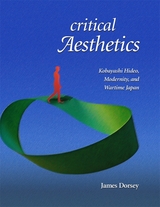 Critical Aesthetics: Kobayashi Hideo, Modernity, and Wartime Japan
James Dorsey
Harvard University Press, 2009 This study revolves around the career of Kobayashi Hideo (1902–1983), one of the seminal figures in the history of modern Japanese literary criticism, whose interpretive vision was forged amidst the cultural and ideological crises that dominated intellectual discourse between the 1920s and the 1940s.
Kobayashi sought in criticism a vehicle through which to rhetorically restore to the artistic work an aura of concreteness that precluded interpretation and instead inspired awe, to somehow recover a literary experience unmediated by intellectual machinations. In adhering firmly to this worldview for the duration of World War II, Kobayashi came to assume a complex stance toward the wartime regime. Although his interweaving of aesthetics and ideology exhibited elements of both resistance and complicity, his critical ethos served ultimately to undergird his wartime fascist stance by encouraging acquiescence to authority, championing patriotism, and calling for more vigorous thought control.
Treating Kobayashi’s influential works and the historical context in which they are rooted, James Dorsey traces the emergence of a modern critical consciousness in conversation with such concerns as the nature of materiality in capitalist culture, the relationship of narrative to subjectivity, and the nostalgia for beauty in a time of war.
Critical Analyses in English Renaissance Drama: A Bibliographic Guide
Brownell Salomon
University of Wisconsin Press, 1979 This bibliographic guide directs the reader to a prize selection of the best modern, analytical studies of every play, anonymous play, masque, pageant, and "entertainment" written by more than two dozen contemporaries of Shakespeare in the years between 1580 and 1642. Together with Shakespeare's plays, these works comprise the most illustrious body of drama in the English language.
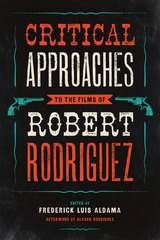 Critical Approaches to the Films of Robert Rodriguez
By Frederick Luis Aldama
University of Texas Press, 2015 Frederick Aldama’s The Cinema of Robert Rodriguez (2014) was the first full-scale study of one of the most prolific and significant Latino directors making films today. In this companion volume, Aldama enlists a corps of experts to analyze a majority of Rodriguez’s feature films, from his first break-out success El Mariachi in 1992 to Machete in 2010. The essays explore the formal and thematic features present in his films from the perspectives of industry (context, convention, and distribution), the film blueprint (auditory and visual ingredients), and consumption (ideal and real audiences). The authors illuminate the manifold ways in which Rodriguez’s films operate internally (plot, character, and event) and externally (audience perception, thought, and feeling). The volume is divided into three parts: “Matters of Mind and Media” includes essays that use psychoanalytic and cognitive psychology to shed light on how Rodriguez’s films complicate Latino identity, as well as how they succeed in remaking audiences’ preconceptions of the world. “Narrative Theory, Cognitive Science, and Sin City: A Case Study” offers tools and models of analysis for the study of Rodriguez’s film re-creation of a comic book (on which Frank Miller was credited as codirector). “Aesthetic and Ontological Border Crossings and Borderlands” considers how Rodriguez’s films innovatively critique fixed notions of Latino identity and experience, as well as open eyes to racial injustices. As a whole, the volume demonstrates how Rodriguez’s career offers critical insights into the filmmaking industry, the creative process, and the consuming and reception of contemporary film.
A Critical Bibliography of the Published Writings of Romain Rolland
William Thomas Starr
Northwestern University Press, 1950 Late nineteenth-and early twentieth-century French writer Romain Rolland remains best known for his epic coming-of-age tale, Jean Christoph. In A Critical Bibliography of the Published Writings of Romain Rolland William Thomas Starr Starr painstakingly collects the information on all writings by and about this prolific author through 1949. Organized into two parts, the bibliography lists the writings of Rolland first, and a devotes second section to studies, comments, reviews, attacks, and homages.
 The Critical Calling: Reflections on Moral Dilemmas Since Vatican II
Richard A. McCormick, SJ. Foreword by Lisa Sowle Cahill
Georgetown University Press, 2006 When Richard A. McCormick's The Critical Calling was first published, Andrew M. Greeley commented that "in years to come scholars will look back on Father McCormick's work and say, 'This was a man who knew what he was talking about!'" In this reissue, with a new foreword by Lisa Sowle Cahill, both first-time readers and those opening the pages for a return visit with an honored friend will find Greeley's characterization remains valid. Father McCormick begins The Critical Calling with his personal affirmation of the work of Vatican II: "I believe the Council was a work of the Spirit—desperately needed, divinely inspired, devotedly and doggedly carried through." Yet, he stresses this was no uncritical endorsement of everything the Council did and said. Part One includes a discussion of fundamental moral theology that looks at the relationship between the church hierarchy and individual moral decision making and several chapters addressing issues precipitated by actions involving Cardinal Josef Ratzinger, now Pope Benedict XVI. Part Two focuses on practical and pastoral questions that touch on contemporary concerns ranging from abortion to AIDS, divorce, homosexuality, and teenage sexuality. Cahill suggests that "those who lived through the tumultuous 1960s and '70s" as well as "those who came to maturity after the Council" will find this book to be an accurate and evocative reflection of the passions that imbued all those early debates and a helpful explanation why those passions ran so high. All readers will benefit from the wise insights into the controversies of that era and the more recent struggles, challenges, and debates that confront today's church.
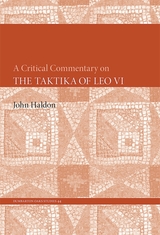 A Critical Commentary on The Taktika of Leo VI
John Haldon
Harvard University Press The Taktika, ascribed to the hand of the Byzantine emperor Leo VI "the Wise" (886-912), is perhaps one of the best-known middle Byzantine texts of an official or semi-official genre. Presented in the form of a book of guidance for provincial generals, it served as both a statement of imperial authority and power, as well as a reminder of earlier "good practice" and the centrality of the values of a Christian society in the struggle against its enemies. In particular, the Taktika identified Islam, for the first time, as a fundamental threat to the very existence of the Christian Roman Empire and Christianity itself. Yet despite its significance for the history of Byzantine administration, culture, language, and society, no study has ever been devoted to this fascinating text. John Haldon offers the first critical commentary to appear in any language, addressing in detail the many varied subjects touched on in the treatise itself and accompanied by three introductory chapters that examine the context, sources, language, structure and content of the text, as well as the military administration of the empire in Leo's time.
Critical Communication: A Memoir
Vincent Mosco
University of Westminster Press, 2025 This memoir, completed just before Vincent Mosco’s sudden death in February 2024, chronicles the last half century of research, activism and teaching in critical communication, technology and society from the perspective of one of its pioneering figures. It concentrates on the making of a radical activist scholar, the creation of a critical communication research field, the growth of a critical political economy of media and the concomitant expansion of critical approaches to media and computer technology, to communication labour and to public policy and media activism.
This beautifully written and deeply personal book is an informative and fascinating read that will be of interest to anyone interested in Critical Media and Communication Studies and the Political Economy of Communication.
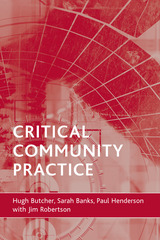 Critical Community Practice
Hugh L. Butcher, Sarah Banks, Paul Henderson, and Jim Robertson
Bristol University Press, 2007 With the increasing focus on 'community' as the site for renewing democracy, improving policymaking and enhancing service delivery, this book provides a challenging approach to understanding community practice. It offers a much-needed theoretical perspective, sets out an analysis of power and empowerment and explores new ways of understanding active citizenship.The book covers a wide range of theoretical and practice topics. First presenting a model of critical community practice, the authors draw upon a variety of case studies from Britain and elsewhere to discuss this in the context of work in and with community groups; management; policy and politics; and development of the critical practitioner. Demands being placed on individuals and organisations have become increasingly complex and greater clarity about community practice is needed. This book, designed to complement the authors' edited volume "Managing Community Practice" (The Policy Press, 2003) provides just that.The book's content will be of particular interest to those following the debates on community involvement in regeneration, social inclusion and health improvement programmes. It will provide a resource for those already engaged in community practice and thus inform the work of local authorities, government agencies, voluntary organisations and partnerships. It will be relevant reading for all those people working to promote change and development in communities. It will also be an essential text for students on a range of professional and management programmes in community development, health, housing, planning and other disciplines with a community focus.
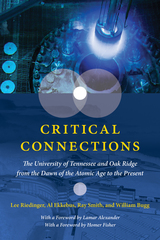 Critical Connections: The University of Tennessee and Oak Ridge from the Dawn of the Atomic Age to the Present
Lee Riedinger
University of Tennessee Press, 2024 The bombing of Pearl Harbor set off a chain of events that included the race to beat German scientists to build the atomic bomb. A tiny hamlet tucked away in the southern Appalachians proved an unlikely linchpin to win the race. The Manhattan Project required the combination of four secret sites—Clinton Laboratories, Y-12, K-25, and S-50—75,000 workers, and the nation’s finest scientists to create the Secret City, Oak Ridge. From the beginning, the effort was aided by the nearby University of Tennessee, which provided expertise to make the weapon possible. Following World War II, it was not clear what role this huge research and development program would play, but pioneering scientists and administrators were determined that one option—dismantling the whole thing—would not happen.
Critical Connections chronicles how Oak Ridge National Laboratory (ORNL), the Y-12 National Security Complex, and their partners became outstanding examples of the military-industrial-educational complex from the Cold War to the present day. At the beginning of the 1950s, Oak Ridge became a flourishing, less-secret city, and the authors show how, decade by decade, ORNL became the source of major breakthroughs in physics, biology, computing, and other fields—and how these achievements required ever-closer connections with UT. By the mid-1990s, after many successful joint initiatives between UT and ORNL, UT was poised to compete to become the manager of ORNL. In 2000, UT-Battelle LLC won the bid from the Department of Energy: UT was charged with providing scientific direction and key personnel; its partner Battelle would oversee ORNL’s operations and chart its technology direction.
The authors highlight the scientific developments these connections have brought, from nanotechnology to nuclear fission, from cryogenic experiments on mice to the world’s fastest supercomputer. The partnerships between a university, a city, and federal facilities helped solve some of the greatest challenges of the twentieth century—and point toward how to deal with those of the twenty-first.
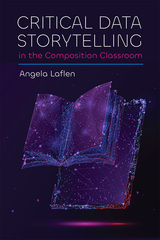 Critical Data Storytelling in the Composition Classroom
Angela Laflen
Utah State University Press, 2025 Critical Data Storytelling in the Composition Classroom provides a timely and essential framework for integrating data literacy into multimodal composition pedagogy. Angela Laflen demonstrates that in an era dominated by big data and AI, the need to understand how to work with data is no longer limited to scientists and mathematicians. Instead, data literacy has become a crucial skill for participating in democratic society.
At the heart of Laflen’s approach is critical data storytelling—a practice that equips students with the skills to understand, interpret, and ethically communicate with and about data through various multimodal formats. By teaching students to make informed decisions as data storytellers, Laflen addresses the ethical implications of working with data while offering practical strategies for reading and analyzing data stories. This approach empowers both students and teachers to engage critically with data as a tool for learning and communication. It also highlights how multimodal composition has yet to fully account for the central role of data in shaping contemporary communication and argumentation.
By focusing on the ethical and rhetorical dimensions of data storytelling, Critical Data Storytelling in the Composition Classroompresents a pedagogical approach that prepares students for the challenges of working with data in a rapidly evolving digital landscape. This flexible, adaptable model for teaching critical data literacy is of great interest to writing instructors, scholars in rhetoric and composition, and educators who seek to prepare students for the demands of a data-driven world.
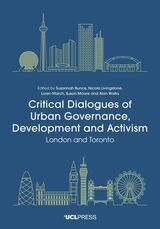 Critical Dialogues of Urban Governance, Development and Activism: London and Toronto
Edited by Susannah Bunce, Nicola Livingstone, Loren March, Susan Moore, and Alan Walks
University College London, 2020 Cities have been some of the most visible manifestations of the evolution of globalization and population expansion, and global cities are at the cutting edge of such changes. Critical Dialogues of Urban Governance, Development and Activism examines changes in governance, property development, urban politics, and community activism in two key global cities: London and Toronto. By taking these two cities as empirical cases, the book engages in constructive dialogues about the forms, governmental mechanisms and practices, and policy and community-based responses to the concerns facing modern urban centers. Through three central issues, governance, real estate and housing, and community activism and engagement, the authors seek to understand London and Toronto from a nuanced perspective, promoting critical reflection on the experiences and evaluative critiques of each urban context, providing insight into each city’s trajectory and engaging critically with wider phenomena and influences on the urban governance challenges in cities beyond.
A Critical Dictionary of Sociology
Raymond Boudon and François Bourricaud
University of Chicago Press, 1989 This distinguished reference work is much more than a lexicon or ordinary dictionary. Each essay, complete with bibliographical references, presents a selective and critical discussion of some issue fundamental to sociology. Synthesizing American, British, French, and German, taken together these contributions provide a coherent and sophisticated critique of the sociological tradition.
|
|
